




















In this week’s issue, our Centerfold Commissioner put together a hamantash personality quiz.
Supposedly, according to the Commissioner, your favorite hamantashen flavor can be determined by certain traits that you have. Are you a poppy or a raspberry? Or maybe an apricot? You can take the “quiz” to find out.
One day, Jewish scientists will put together a Purim personality quiz. I can help them with their questions, although they would have to do the actual science to figure out each person’s “Purim personality.” You see, even though everyone enjoys Purim in their own way, there are still certain Purim “traits.”
Every year, our tables are laden with the myriad mishloach manos that come through the door. And each mishloach manos is unique. So what do they say about us? There are those who send out baked goods every year in their mishloach manos – delectable muffins or delicious salads or decadent chocolates. Are they of a more “nurturing” personality? Are they more giving or caring? Or do they just like to bake?
Other people need to have a theme every year – a sports theme, a French theme, a Pesach theme – the list is endless. Are these people more creative than others? Or do they just like to have fun with their mishloach manos?
What about those who like to go “simple,” just a few things packaged beautifully. Are they more practical or traditional than others? Or do they just not have the time to do something more?
And then you have the Purim cards. After all, we need to know from whom the mishloach manos came. Some people have a simple greeting: “Simchas Purim from the Stern family.” Classic, simple, completes the job. Then there are others who write a poem or an essay. And even within the poem/essay crowd there are those who write a long megillah, crammed with jokes and theme-related puns. Others endeavor to remind us about the power of Purim and the significance of the day. What do those notes say about them? Are they funny, creative, original think-
ers or idealists, reflective, analytical people? Or do they just like to write?
Let’s talk costumes. Kids think about their costumes for weeks before Purim. They pore over magazines, converse with their friends, discuss the details, and ponder the intricacies. But even amongst the costume tumult, there are still certain inevitabilities. Girls under the age of 4 will, with a probability of 85%, be dressed as princesses. Not all of them will be wearing a white and gold gown, though. There are variations, you know. You’ll see Queen Esther, and Sophia the First, and many, many kallahs. But they’re all part of a little girl’s dream.
What about boys of that age? No doubt that 78% of them will be policemen, firemen, Hatzalah members, or in the military. Uniforms, a walkie-talkie, a hat, and maybe a fake gun or two are just so exciting for little boys.
As kids get older, their costumes become a bit more imaginative but you’ll still have some kids who are a bit more creative when it comes to getting dressed up – think shower curtains, a purple wig, and sunglasses – and those who go with the safer costumes that come off the store shelves. What does it mean if a kid has no problem walking the streets dressed as a rodent? Are they more outgoing, confident, quirky? What about those kids who want to dress up just like their friends? What’s their “Purim personality”?
As kids grow into adults, some of them keep their Purim costumes on – I’m referring to those adults who still dress up every year on Purim. Some go all out, wearing a full costume, complete with a hat and face paint. Others give in to their children’s coaxing and don a funny hat or necktie for the day. What does it say about me that I’ve given up the costume habit years ago? Does it mean that I just can’t get into the Purim spirit? Or does it mean that as a mother I’m juggling so many other costume parts throughout the day that it’s just easier to wear my regular clothes?
I’ll let those Jewish scientists decide. Wishing you a freilechen Purim, Shoshana
Yitzy Halpern, PUBLISHER publisher@fivetownsjewishhome.com
Yosef Feinerman, MANAGING EDITOR ads@fivetownsjewishhome.com
Shoshana Soroka, EDITOR editor@fivetownsjewishhome.com
Nate Davis
Editorial Assistant
Nechama Wein
Copy Editor
Rachel Bergida
Shana Brecher
Lani White
Design & Production
Gabe Solomon
Distribution & Logistics
P.O. BOX 266
Lawrence, NY 11559
Phone | 516-734-0858
Fax | 516-734-0857
Classified Deadline: Monday 5:00PM classifieds@fivetownsjewishhome.com

text 443-929-4003
PAYMENT VIA CREDIT CARD MUST BE SUBMITTED ALONG WITH CLASSIFIED ADS
The Jewish Home is an independent weekly magazine. Opinions expressed by writers are not necessarily the opinions of the publisher or editor. The Jewish Home is not responsible for typographical errors, or for the kashrus of any product or business advertised within. The Jewish Home contains words of Torah. Please treat accordingly.
Friday, March 3 Parshas Tetzaveh
Candle Lighting: 5:30 pm

Shabbos Ends: 6:31 pm
Rabbeinu Tam: 7:02 pm

The wonderful piece by Yitzy Halpern about Alan Kutner, a”h, resonated with me. Having married into a Memphis family, I am acutely aware of the foundational impact that the Kutner family had upon the Orthodox community in Memphis (A “Once in a Generation Friend,” Feb. 2).
I wish to point out an inaccuracy. The article notes the special relationship that Alan had with Rav Nota Greenblatt, zt”l. Speaking about Rav Nota, the article states that he “sat alone in Memphis and learned the entire Torah practically by heart.” Yes, Rav Nota was a “gantze Torah Yid,” but no, he did not sit alone in Memphis.
For one thing, there were and are many lomdei Torah in that great city. Further, for many years I had the z’chus to carve a deep relationship with Rav Rafael Grossman, zt”l, the long-tenured leader of the Baron Hirsch Congregation. Rav Grossman was certainly a talmid chacham of stature.
And Memphis was home to Rav Ephraim Greenblatt, zt”l, Rav Nota’s nephew and a towering gadol in his own right. Rav Ephraim was, like Rav Nota, a talmid of Rav Moshe Feinstein, zt”l, and Rav Ephraim’s questions to Rav Moshe feature often in Igros Moshe. Rav Ephraim’s own series of responsa, Rivevos Ephraim, is considered an indispensable part of a modern teshuvos library. I had the merit to “speak in learning” with Rav Ephraim on innumerable occasions.
So Rav Nota was not alone in Memphis. Torah was and is a vigorous part of
that community, and I pray that the city will continue to grow in Yiddishkeit.
Avi GoldsteinFar Rockaway, NY
Dear Editor,
Rabbi Yisroel Reisman of Torah Vodaath conveyed the essence of life in an address to Yeshiva Ohr Somayech in Israel a little over a year ago. It’s based on the following: It says Bnei Yisroel traveled three days from Sinai to the border of Eretz Yisrael. But, because G-d wanted to bring them into the land, G-d made it miraculously happen in one day. However, Rashi later says that they complained for three days about the tircha, the hardship of the travels, a seeming contradiction, as it supposedly happened in one day. Reb Chaim Kanievsky zt”l explains that when G-d shortens time, He just shortens the clock, but not the travel. The actual travel is done, only the time doesn’t come off the clock. Why didn’t G-d choose the opposite model? That, in fact, you magically get to the spot in a minute, and therefore don’t have to go through the travel.
The answer is that life is about the tumultuous journey. The Jewish people complained about an uncomfortable three days of travel after enjoying a sta-


Continued on page 10
Due to an oversight, TJH mistakenly featured the OK Kosher trademarked symbol in last week’s issue on its cover without authorization. We regret the error.

Continued from page 10
tionary respite at Sinai for a year. They didn’t realize that the “three day challenging journey was the destination.”
Our job is to embrace the process, no matter how difficult it is, for that is where growth lies. Success is about enduring struggle with grace and putting our maximum effort into every challenge. Exhibiting such tenacity ensures that the conquering of the next challenge will come with greater ease and “speed.”
Steven GenackDear Editor,
The news that COVID-19 may have leaked from a Chinese lab demonstrates how little we know about the communist country while they have learned a lot about us thanks to the spy balloon flyover.
I would also suggest that this mission served as a lesson of what not to do. Despite spending more on education than many other countries, the U.S. is ranked lower in grade-level proficiency. We have allowed autocracies to lead the way in education because they care about their schools. Imagine how much better America, a democracy, can be if we return to our value system that rewards merit. Finally, if America is to be prepared militarily, we
need to educate our students. Otherwise, we will go bust. I can assure you, dear Editor, that there is nothing coming out of American public schools that China wants access to.
Chaim Yehuda Meyer Brooklyn, NYDear Editor,
I love reading your paper every week. I think that you provide wonderful, insightful, well-quality reading for the frum community. I thank you for that.
This week, you featured an article on “Kosher Money.” It was a great article and covered many good points, certainly many issues that the frum community needs to know about.
But my letter is only tangential to your article. What bothers me is that our community has become so money-absorbed. So much of our frum reading material holds business and money-making to an ideal. The “gvirim” in our community are put on a pedestal. Rarely do you go to a yeshiva dinner and the video features ehrliche baale batim. Rather, it’s the people with money who are the ones we are hearing from.
Yes, having money and being finan-



























cially stable is important if you want to have yishuv ha’daas. But the money adulation in our community is not something we should be proud of and value.

can “handle” it. Their brains are not yet developed and their bodies are not mature enough to handle the effects of alcohol.
Sincerely, A
ReaderDear Editor,
This is a plea to the community to remember that Purim is not a day when alcohol poisoning takes a rest. If you feel you need to drink alcohol, please be responsible with it.
Even more than that, it is not cool or kosher or legal in any way to give alcohol to minors. I don’t care if you think they
A close friend of mine almost lost her son because he was given too much to drink on Purim. She spent the rest of the day in the hospital davening that he should survive.
Please, let’s all enjoy Purim in a responsible, happy, joyous way.
Y. Neuberger

popular, however, especially among the poor half of the population. He has boosted social spending and the minimum wage, and appeals to ordinary Mexicans with folksy language and constant travels around the country – often by car or commercial airline.

The new law is expected to face a swift court challenge. At Sunday’s demonstration in Mexico City, a retired chief justice of the Supreme Court, José Ramón Cossío, urged the magistrates to declare the measure unconstitutional.
Ten of thousands of people joined together in Mexico City’s Zocalo plaza square in front of the presidential palace on Sunday to protest a law that could weaken the national electoral institute.
The turnout underscored how much the electoral law has galvanized voters, after four years in which President Andrés Manuel López Obrador largely dominated political life. The veteran leftist’s party holds a majority in Congress and has swept most governor’s offices.
Many demonstrators wore shirts and baseball caps in pink, the color of the National Electoral Institute, or INE.

“Don’t touch our vote!” they chanted, waving Mexican flags.
Many Mexicans consider the 33-yearold INE to be one of the most important institutions in the country’s transition from seven decades of one-party rule. It replaced a fraud-riddled electoral system with a tightly regulated regimen overseen by thousands of workers who issue voter IDs and control virtually all aspects of state and federal balloting.
López Obrador charges that the autonomous electoral institute has turned into a bloated bureaucracy headed by lavishly paid civil servants, some of them close to the opposition. He says that his plan to slash the INE’s budget and staff — part of a broader government austerity drive – will save $150 million a year.
But many of López Obrador’s critics worry the law passed last week is aimed at keeping his party in power in presidential elections next year. Despite worries, the president is banned from seeking reelection, and his party is likely to win the 2024 elections in any case.
Most of Sunday’s protesters were from the middle-class, who are fed up with the president’s attacks on journalists and academics. López Obrador remains
Nigeria’s two major opposition parties on Tuesday called for the presidential election to be canceled and rerun, saying that it had been compromised by vote rigging and widespread violence.

The election over the weekend in the West African nation — the most populous on the continent, with 220 million people — was the most wide open in years, with a surprise third-party candidate putting up an assertive challenge.
On Tuesday, the chairmen of the two opposition parties — the People’s Democratic Party and the Labour Party — called for the head of the government’s electoral commission to resign, even as the commission continued to release results.
With about one-third of the 36 states reporting results, by Tuesday afternoon, Bola Tinubu, the candidate of the governing All Progressives Congress party, appeared some distance ahead of his rivals in the count, with 44% of the vote. Some 87 million people were registered to vote, but results from the first tabulations suggested low turnout.
“We demand that this sham of an election be immediately canceled,” said Julius Abure, chair of the Labour Party. “We have totally lost faith in the whole process.”
Many Nigerians had looked to the election to put the country back on track after eight years of rule by an ailing president, Muhammadu Buhari — a military dictator turned democrat. Buhari had reached his two-term limit and was not

running for reelection.

Many polls ahead of the election predicted a win for Peter Obi, the so-called “youth candidate” of the little-known Labour Party. But as of Tuesday afternoon, Obi had just 18% of the votes, while Atiku Abubakar of the People’s Democratic Party also trailed behind Tinubu with 33%.
On Monday, Obi pulled off an unexpected victory in Lagos state, home to the country’s largest city and traditionally a stronghold of Tinubu, who was its governor for eight years.
The Independent National Electoral Commission, or INEC, had said in a statement on Monday that it took “full responsibility” for the logistical problems and delays.
Dele Alake, a spokesperson for the All Progressives Congress presidential campaign council, rejected the idea that his party had tried to engineer a result, noting that Tinubu had lost in his home state, as other party figures had in theirs.
“How can anyone claim the election was rigged or not transparent?” he said.
(© The New York Times)
Elon Musk has reclaimed the title of the richest person in the world, as per Bloomberg’s tally.

The Tesla CEO was unseated from the top spot by Bernard Arnault, CEO of French luxury brand LVMH (LVMHF), in December of last year, making Musk No. 2 on the list for more than two months. As of Monday, however, Bloomberg reported that a rally in Tesla stock had lifted Musk back to the top of its real-time Billionaires Index.
Musk’s net worth was some $187.1 billion as of Monday after markets closed, according to Bloomberg, just topping the $185.3 billion fortune of Arnault.
You win some, you lose some. Musk might hold the current title of the richest person in the world, but he also
holds a record for the biggest fortune ever lost by anyone in history. Late last year, Musk became the first person ever to lose $200 billion in wealth — after his net worth slid from some $340 billion in November 2021 to $137 billion in December 2022.
for girls in the country.
Interestingly, although Iran is hardly a democracy, female education has never been challenged in the years since the Islamic Revolution in 1979. In fact, Tehran has been calling on the Taliban in neighboring Afghanistan to have girls and women return to school.

The first cases of the poisoning emerged in late November in Qom, 125 kilometers southwest of Iran’s capital, Tehran. There, in a heartland of Shiite theologians and pilgrims, students at the Noor Yazdanshahr Conservatory fell ill in November. They then fell ill again in December.
Other cases followed, with children complaining about headaches, heart palpitations, feeling lethargic, or otherwise unable to move. Some described smelling tangerines, chlorine, or cleaning agents.
Over the past few months, hundreds of young girls in various schools in Iran have become overwhelmed by noxious fumes wafting into their classrooms, weakening some and sending them to the hospital. Initially, these incidents were dismissed, but now, the Iranian government is admitting that these incidents were actually intentional acts by some who want to poison the girls so they would close schools
At first, authorities didn’t link the cases. It’s winter in Iran, where temperatures often drop below freezing at night. Many schools are heated by natural gas, leading to speculation it could be carbon monoxide poisoning affecting the girls. The country’s education minister initially dismissed the reports as “rumors.”
But the schools affected at first only taught young women, fueling suspicion it wasn’t accidental. At least one case

followed in Tehran, with others in Qom and Boroujerd. At least one boys’ school has been targeted as well.
It took several months for authorities to connect the dots.

“After several poisonings of students in Qom schools, it was found that some people wanted all schools, especially girls’ schools, to be closed,” IRNA news agency quoted Younes Panahi, a deputy health minister, as saying.
But the attackers’ desires have been met in some cases. Parents have begun pulling their daughters from classes, effectively shuttering some schools in Qom in recent weeks.
Attacks on women have occurred in the past in Iran, most recently with a wave of acid attacks in 2014 around Isfahan, at the time believed to have been carried out by hard-liners targeting women for how they dressed. But even in the chaos surrounding the Islamic Revolution, no one targeted schoolgirls for attending classes.
Jamileh Kadivar, a prominent former reformist lawmaker and journalist, wrote in Tehran’s Ettelaat newspaper that as many as 400 students have fallen ill in the recent poisonings.
She cited a supposed communique from a group calling itself Fidayeen Velayat that purportedly said that “the study
of girls is considered haram” and threatened to “spread the poisoning of girls throughout Iran” if girls’ schools remain open.
with its continental neighbors, making it simpler to ship goods between Northern Ireland and the rest of the United Kingdom, and opening the door to restoring a functioning government in Northern Ireland after months of paralysis.
It could also remove a lingering irritant between Britain and the United States. President Joe Biden had pressed Prime Minister Rishi Sunak of Britain to negotiate an end to the impasse with Brussels, and the deal could smooth the way for a visit by the president to London and Belfast, Northern Ireland’s capital, to mark the 25th anniversary of the Good Friday Agreement, which ended decades of bloodshed known as the Troubles.
as a first-line defense against anti-India insurgents in remote Himalayan villages that government forces could not reach quickly. Eventually, the militia was disbanded as the insurgency waned and as some militia members gained notoriety for their brutal tactics. Now, though, the militia is beginning to reform, as violence is being seen in remote areas on India.
Britain and the European Union struck a landmark agreement on Monday to end a festering dispute over post-Brexit trade rules for Northern Ireland, potentially resolving one of the most poisonous legacies of Britain’s exit from Europe’s trade bloc in 2020.
The agreement, concluded after weeks of confidential talks and multiple false starts, could have far-reaching economic and political consequences: averting a trade war between Britain and the European Union, smoothing Britain’s relations
Sunak and Ursula von der Leyen, president of the European Commission, announced the deal, which they called the “Windsor Framework,” after working out the final terms at a meeting in Windsor, outside London.

“The United Kingdom and the European Union may have had our differences in the past, but we are allies, trading partners and friends,” Sunak declared. “This is the beginning of a new chapter in our relationship.”
Von der Leyen said the agreement would allow them to remove a source of friction and focus on greater challenges, including curbing climate change and defending Ukraine in its war with Russia.
Northern Ireland’s trade rules, as fiendishly complex as they are, have become a totemic issue for Brexiteers and unionists because of the territory’s unique status: It is part of the United Kingdom but shares a land border with the Republic of Ireland, a member of the European Union and its single market.
For Sunak, who came to power in October and is trailing the opposition Labour Party in the polls, the deal is a litmus test for his young government. A negative reaction could embolden one of his predecessors, Boris Johnson, who was ousted last year but who may harbor ambitions for a comeback. (© The New York Times)
In January, seven Hindus were killed in attacks in a village in Kashmir. Days after the deadly violence in the village in frontier Rajouri district, where homes are separated by maize and mustard fields, hundreds of residents staged angry protests across the Hindu-dominated Jammu region. In response, Indian authorities revived the militia and began rearming and training thousands of villagers, including some teenagers.
The policy to rearm civilians comes after India stripped Kashmir of its semi-autonomy and took direct control of the territory amid a months-long security and communications lockdown in 2019. Kashmir has since remained on edge as authorities also put in place a slew of new laws that critics and many Kashmiris fear could change the region’s demographics.
In New Delhi’s effort to shape what it calls “Naya Kashmir,” or a “new Kashmir,” the territory’s people have been largely silenced, with their civil liberties curbed, as India has shown no tolerance for any form of dissent.

Since reforming the militia, authorities have armed and trained over 100 Hindu men. They have also lifted the ban on gun licenses in the already militarized Rajouri. The village already had over 70 former militiamen, some of whom still possess the colonial British-era Lee–Enfield rifles allotted to them over a decade ago. Each militia member is going to be paid by the government around 4,000 rupees a month, approximately $48.


cluding a newborn and other children, authorities said.

Eighty people survived the wreck, according to Italy’s coast guard, which said helicopters, ships and water scooters were still being used to look for more survivors in what remained “particularly hostile weather conditions.” The death toll was expected to rise.
The migrants were mainly from Afghanistan, but also from Iran and Pakistan, and had been crossing from Turkey, authorities said.
The wreck drew expressions of grief and demands for action from leaders across the political spectrum in Italy.
In video footage released by police, chunks of wooden beams and boards could be seen lying next to a structure resembling a boat’s keel on the beach of Steccato di Cutro, a small seaside town on Calabria’s eastern coast. Italian news outlets showed survivors covered in thermal blankets sitting in a field near the beach, while a priest blessed the bodies of their dead companions, hidden under white bags nearby.
Calabria, which forms the tip of Italy’s boot, is geographically the easiest destination for migrant vessels traveling from Turkey. It was the landing place of about 15% of the 105,000 migrants who arrived
in Italy last year, according to the International Organization for Migration.
Italy’s president, Sergio Mattarella, called the shipwreck the “umpteenth tragedy in the Mediterranean that can’t leave anyone indifferent.”
He called on the international community to tackle the causes of migration, adding in an unusually harsh statement: “It is equally indispensable that the European Union finally takes on concrete responsibility” to control migration and take it out of the hands of human traffickers.
The central Mediterranean is historically one of the deadliest routes for migrants trying to reach Europe. In 2022, 1,417 people died during the crossing, according to the International Organization for Migration. Deaths were particularly high this month, with 158 already recorded in the weeks before Sunday’s wreck, compared with 132 in February last year.
(© The New York Times)
According to the U.S. Energy Department, a laboratory in Wuhan, China, is the probable cause for the leakage of the coronavirus that threw the world into a

tailspin and killed almost seven million people worldwide.
A report seen by the Wall Street Journal said the agency had updated its position in light of “new intelligence” and the latest science on the virus. The agency had previously said it was “undecided” on how the pandemic that infected 675 million people started.
China.
On Monday, U.S. Ambassador to China Nicholas Burns said that China will have to “be more honest about what happened three years ago in Wuhan with the origin of the Covid-19 crisis” if the United States and China are going to be able to work together.
The FBI previously reached the same conclusion with “moderate confidence.”
The report, said to have been handed to the White House and senior members of Congress, also stated the virus was probably not engineered as part of a weapons program.
The WHO’s chief Tedros Adhanom Ghebreyesus has nonetheless said all theories on the origin of the virus remain on the table and has called on Beijing to allow further investigation. It is highly unlikely that clear answers will come from
According to the Center for Strategic & International Studies, between 40,000 to 60,000 Russian soldiers have died since the invasion of Ukraine last year. That staggering number is more than all the Russian soldiers to have perished in all of Russia’s wars since World War II. Russian troops are dying each month at a rate “at least 25 times the number


killed per month in Chechnya and 35 times the number killed in Afghanistan,” the center wrote.
The high casualties are the result of Ukrainian “military innovation” and counteroffensives, including Ukraine’s defense of Kyiv in the spring of 2022 and counteroffensives in the territory around Kharkiv in the northeast late last year.
Earlier this month, the UK Ministry of Defense tweeted an update that Russian forces had “likely suffered 175-200,000 casualties since the start of the invasion of Ukraine. This likely includes approximately 40-60,000 killed.”
The casualty rate reportedly “significantly increased” after Russian President Vladimir Putin imposed a “partial mobilization” of Russian forces, UK intelligence said.
It has been reported that as many as 13,000 Ukrainian soldiers were killed in combat as of December 2022.
Despite high losses, both sides are now fighting “a war of attrition” to wear each other down, chip away at defenses, and replenish resources as quickly as possible, according to CSIS.
While neither side has gained much territory since late 2022, “casualty rates have increased” and both Russian and Ukrainian forces have damaged weapon systems and equipment.
Putin initially thought that Ukraine would fall into Russia’s hands in a matter of days. But Russian generals seriously overestimated Russia’s military – and underestimated Ukrainian forces – leading to poor strategy, command failures, and mismanaged logistics.

date, the mask mandate is being lifted, according to city leader John Lee.
“We are now returning to normalcy,” Lee said, as the Asian financial hub launches a major push to welcome back business travelers and tourists.
Hong Kong has rolled back several other major controls in recent months, most notably mandatory quarantine for all international arrivals, a move celebrated by travel-starved residents, overseas family members, and struggling local businesses.
Speaking at the same news briefing on Tuesday, Health Secretary Lo Mauchung said that with the lifting of the mask mandate, “we have now removed all epidemic restrictions.”
“I’m looking forward to seeing a smile on everyone’s face now,” he said. However, he added, the government still advises the wearing of masks in “high risk” settings such as elderly care homes and hospitals.

Most other places in Asia have either fully or partially eased their mask mandates in recent months, including South Korea, Japan, and Taiwan.
For much of the pandemic, Hong Kong held the unenviable title of having some of the world’s most stringent pandemic policies – such as the strict quarantine, which at one point required up to 21 days of isolation in a hotel room, with no visitors allowed and the windows locked shut.
The mask mandate, too, drew criticism at times; in July 2020, during the peak of Hong Kong’s humid and sweltering summer, the government expanded the mandate to require masks even when exercising outdoors. It backtracked just weeks later amid public outcry, acknowledging that people had “shied away from exercising” due to the rule.
Nearly three years after the mask mandates were enacted in Hong Kong, the city is now ready to get back to normal.
The mandate had enforced fines up to $1,000 and was enacted for public transportation on July 15, 2020. It was expanded two weeks later for all indoor and outdoor public places. Interestingly, people in the city were wearing the face coverings voluntarily before the mandates as reports of corona spread.
Now, 959 days after that first man -
On Sunday, Hallel Yaniv, 21, and Yagel Yaniv, 19, were killed as they drove through the Palestinian town of Huwara. On Monday, they were buried at Mount Herzl in Jerusalem by their loved ones and thousands of others who joined in the pain of the family.

“Words can’t describe this disaster,” their mother, Esti Yaniv, said at a press conference ahead of the funeral. “Instead of accompanying children to the wedding canopy, we need to bury them.”
The mourning mother called for unity among Israelis.
ish people have gone through so many other difficult things. I am sure we will be able to bear it.”
At the funeral in Jerusalem, Chief Rabbi David Lau lamented, “When we are here, next to a fresh grave, how can we possibly be comforted?”
hoping to join a top elite unit when he started his military service.
Shimon Naumberg, their uncle, told Ynet that they were “the salt of the earth.”
“People, we are brothers,” she said. “We love the country, we love the army and we want security,” she continued. “The army is everyone’s, and we shouldn’t use it for anything political.”
Their father, Shalom, added: “I plead that this is the last such incident. That all the children can marry, have children, and build homes.”
Rachel, who lost her brothers in the terror attack, said, “We are trying to accept with love the hard news that G-d gave us yesterday. This is hard, and this hurts. We are going through not-so-simple times. But we are strong, and the Jew-

Rabbi Eliezer Melamed, the rabbi of the Har Bracha settlement where the Yaniv family lives, also spoke at the funeral, noting how Hallel and Yagel, “full of vigor and vitality, were killed for the sanctification of G-d.” While their lives were cut short, Rabbi Melamed added, “in the real world, they are very much alive — and the girls and boys who play and are happy around the country are due to their strength.”
Rabbi Melamed said that the fate of the Jewish people has always been “to carry the flag of morality, and to bring a blessing to the world… We did not return to our land to dispossess Arabs of their property but to add blessing to the world,” he said. “Whoever rises up against us, we will fight them, and we will win — all within the confines of the law, through the army and the police.”
Hallel had just finished his army service in the Navy as the deputy commander of a missile boat. He was in a Hesder yeshiva when he was killed. Yagel was
He described them as having different personalities, Hallel being more introverted, Yigal full of alacrity, and “jumping from place to place.”
“They were both full of goodness, giving benefit to all around them, each in his own way,” Naumberg said. “So different, so similar… They were children who lived for the land of Israel, the Jewish people.”
The Yaniv family has three other children.
ding when he was shot to death on Monday while driving near the city of Jericho. He is going to be buried in Israel rather than in his hometown of West Hartford, Connecticut.
Elan, 26, had served in the IDF as a computer programmer before returning to the United States to earn his university degree.

“He felt at home in Israel,” Yona Friedman, a friend, said. “His love for Israel goes without saying — enlisting as a lone soldier is not something common in his community. It’s a testament to the strong connection he had for the country he loved so much, where in the end he will be buried.”
According to Noam Landau, another friend, Elan was planning to return to Israel to settle in the near future.
“He felt really good in Israel. He was surrounded by so many friends, and he was the glue that held his social group together,” Landau told Ynet.
Elan’s former roommate at New York’s Columbia University, Mark Cohen, remembered his friend as “one of the best people I’ve met in my life.”
Elan Ganeles, an American-Israeli citizen, was visiting Israel for a friend’s wed-
Cohen recounted an early conversation with Elan after they had moved into an apartment together.
“When we entered the room, we


knew each other a little bit but not well. He looked at me and said, ‘OK, just so you know, now that we’re friends, we’re friends forever, for eternity. You can’t get rid of me, there’s nothing you can do. You’re stuck with me for your entire life.’”
The terrorists who killed Elan had opened fire at his car on the Route 90 highway.
The terrorists then continued driving and opened fire at another car near Beit Ha’arava Junction, then shot at a third car nearby, the IDF said. Police have not yet captured them.
Elan was killed a day after two Israeli brothers, Hallel Yaniv and Yagel Yaniv, were shot to death in a similar attack in the West Bank.
times between Israel and countries such as India and China required a similar authorization from Oman.
“The Far East is not so far away, and the skies are no longer the limit. This is a day of great news for Israeli aviation. Israel has, in effect, become the main transit point between Asia and Europe,” said Prime Minister Benjamin Netanyahu last week. (JNS)
An El Al Boeing 787 Dreamliner that took off from Tel Aviv for Bangkok on Sunday evening at 8:40 p.m. became the first Israeli commercial flight to cross Omani airspace.

The new route will shorten flight times between Israel and Thailand by three hours and substantially reduce flight times to several other Far Eastern countries, according to Ynet. For instance, a flight to India will take five-and-a-half hours instead of eight and a half.
The shorter route is also expected to reduce ticket prices by cutting fuel and personnel costs, though price cuts are not yet reflected in ticket costs.

Other Israeli airlines will also use the new route, including Arkia and cargo carrier Challenge Airlines.
On February 23, Foreign Minister Eli Cohen announced that Oman had opened its airspace to overflights by Israeli airlines.
The announcement came after months of talks between the Foreign Ministry and authorities in Oman, and after Saudi Arabia last July announced during U.S. President Joe Biden’s visit to Israel the opening of its airspace to “all carriers,” paving the way for Israeli commercial airlines to overfly the kingdom.
The Saudi move had hitherto proved largely symbolic, as shortening flight
Just hours after a shooting attack in which Hallel Yaniv, 21, and Yagel Yaniv, 19, were killed, hundreds of Israelis descended on the Palestinian town of Huwara in the West Bank – the town in which the two brothers were murdered. The Israelis set fires to homes, stores, and cars.

It took a while for police officers to quell the rioting, even though they knew that a protest was planned. Troops were also searching for the gunman who slaughtered the two boys.
Eight people were detained by Israeli troops and police officers on Sunday night over their alleged involvement in the rampage, which saw one Palestinian killed and dozens of Palestinian homes and cars set on fire. As of Tuesday morning, all the people had been released from prison, although some were released to house arrest.
Military chief Herzi Halevi vowed to investigate the “lawlessness” and to “thoroughly investigate” the riots.
Halevi also vowed to capture the gunmen who carried out a deadly shooting attack near the West Bank city of Jericho on Monday that killed AmericanIsraeli Elan Ganeles.
“We will thwart terror of any kind, and we will continue to use all operational and intelligence means in order to capture the terrorists,” Halevi asserted.
The attacker who carried out the deadly shooting in Huwara, killing the Yaniv brothers, was believed to be hiding out in one of the Palestinian towns in the area. The gunmen who killed Ganeles fled toward the Jericho area after police attempted to engage them.

decided to quit that as well, it would not have brought the coalition down.
In the letter to Netanyahu, Maoz wrote that he had unsuccessfully worked to roll back a number of policy points pushed by the last government during his short stint as a deputy minister in the premier’s office.
Among them, Maoz tried to reintroduce the labels “father” and “mother” on official government ministry forms, instead of the titles “parent 1” and “parent 2” that was adopted by the government under Naftali Bennett and Yair Lapid.


who is eligible to immigrate to Israel, hoping to tighten the Law of Return and getting rid of the so-called “grandchildren clause.”
On Monday, MK Avi Maoz sent Prime Minister Benjamin Netanyahu a letter saying that he was resigning as deputy minister because he wouldn’t be effective in his role. He wrote that he “was shocked to find there was no serious intention of honoring the coalition deal.”
Maoz is the Noam party’s only lawmaker in the government.
Maoz was slated to be given control over an Education Ministry department that oversees external programming vendors for public schools. The appointment was met with outrage by pro-liberal forces, who see him as someone outspoken and critical of their beliefs.
Still, Maoz said he will remain in Netanyahu’s 64-MK coalition, though had he
In addition, Maoz tried to change state policy towards an egalitarian prayer space at the Western Wall. In February, the government told the High Court of Justice that it still plans to improve the section marked for non-Orthodox, egalitarian prayer. Maoz decried the position, writing in his resignation letter that he tried to get the government “to preserve the sanctity of the Western Wall and stop the actions to divide it.”
Along with the external educational programming unit, Maoz was promised control over Nativ, the organization responsible for processing Jewish immigration from former Soviet states. This decision was also controversial, as Maoz has supported restricting the criteria for
The Oceana nation of Papua New Guinea will open its first embassy in Israel in Jerusalem this year, Israel’s Ministry for Foreign Affairs announced on Sunday.
The Christian island nation of some 9 million inhabitants will become one of only a handful of countries to have embassies in the Israeli capital following the landmark move by the U.S. under President Donald Trump.
The move was agreed upon during a phone conversation between Foreign Minister Eli Cohen and his Papua New Guinea counterpart Justin Tkatchenko.

The two men also discussed expanding bilateral economic relations, especially in the field of advanced agriculture. Tkatchenko promised that his government would continue its support for Israel in the international arena, the Foreign Ministry statement said.
“I would like to thank Papua New Guinea for the courageous ties, their overwhelming support in international institutions, and their decision to open an embassy in Jerusalem,” Cohen said in a statement. “This is further evidence of the warm and important relationship between the countries.”
He pledged to work to encourage other countries to open or relocate their embassies in the capital.
The U.S., Guatemala, Honduras, and Kosovo maintain their Israel embassies in Jerusalem. (JNS)
Oat, soy, and almond drinks can keep the word milk in their names, the Food and Drug Administration proposed this week, in an effort to end a long-running battle between the powerful dairy industry and the plant-based upstarts that have been changing the way Americans consume cereal and flavor their coffee.

Most consumers, the agency noted in its draft proposal, are aware that liquid extracts from plants have no relationship to the udder of a cow.
But in a concession to the nation’s traditional milk producers, the FDA also recommended that the packaging for plant-based drinks make clear the key nutritional differences between their products and cow’s milk. If a carton of rice milk contains less vitamin D or calcium than dairy milk does, for example, the label should provide that information to consumers, the agency said.
Although the new labeling recommendations are described as voluntary, industry experts predicted that most companies would comply. The agency plans to issue a final decision after another period of public comment.
“Today’s draft guidance was developed to help address the significant increase in plant-based milk alternative products that we have seen become available in the marketplace over the past decade,” Dr. Robert M. Califf, the FDA commissioner, said in a statement. “The draft recommendations issued today should lead to providing consumers with clear labeling to give them the information they need to make informed nutrition and purchasing decisions on the products they buy for themselves and their families.”
The FDA’s guidance had been eagerly anticipated by dairy producers and the expansive plant-based food sector, which have been at loggerheads over whether

the word “milk” on products that are derived from nuts and grains confuses consumers. The debate, which was kicked off four decades ago by the introduction of soy-based beverages, has taken on greater urgency amid a seismic shift in dietary habits. Products such as oat milk continue to enjoy robust growth, while milk consumption has been on a downward trajectory for decades.
The growing embrace of beverages made from cashews, quinoa, or flaxseed has been fueled in part by health concerns; some people buy them because they are lactose intolerant. And an increasing number of Americans cite either the desire for a vegan diet or dairy production’s contribution to climate change through the manure and methane produced by cows. (© The New York Times)
At least 3,000 Asian-Americans have had their identities stolen from a Texas driver database for use by a Chinese criminal gang in New York that has been using the “look-alikes” of these Asian-Americans for illegal immigrants so they can
pass themselves off as U.S. citizens.
Authorities shut down the scheme two months ago, but not before thousands were compromised. Even more shocking is that those whose identities were stolen have not yet been notified by authorities.
es.” The DPS said that 2,400 licenses had been shipped in this way.
The scheme came to light when a vendor who handles payments notified the DPS to an “increase in customers challenging credit card charges for online transactions,” according to the Texas Tribune.
The scheme comes to light at the same time Border Patrol are reporting a huge rise in the number of Chinese nationals attempting to illegally cross the Southern border.
Saraswati’s case echoes a similar situation in which NAACP chapter president Rachel Dolezal claimed to be of African American identity.
The criminal group first obtained personal information of Asian-Americans through the dark web and used it to order duplicate driver’s licenses through the state’s website, the Texas Department of Public Safety [DPS] – which issues licenses – admitted.

When ordering a new copy of a license through an online portal, which was run by a third party, the criminals were able to use information such as previous addresses or mother’s maiden names which they had nefariously obtained to answer security questions. They were then able to order new licenses for as little as $11 which they sent to “third-party address-
Raquel Evita Saraswati was a spokesperson for Muslim causes and an advisor for nonprofits in Philadelphia. National Organization for Women’s Philadelphia chapter named her a Woman of the Year. Nonprofit Rad Girls declared her “Rad Girl of the Year.”

And until last week, she was the chief equity and inclusion officer for the American Friends Service Committee, a Quaker-founded service organization that supports social justice causes all over the country and world.

But Saraswati is not what she said she was.
In allegations in an open letter circulated on February 10 by a “group of individuals who care deeply about AFSC,” Saraswati was living a lie. The group accused her of “cultural vulturism,” alleging that Saraswati, formerly known as Rachel or Raquel Seidel, misrepresented herself as having Arab, Latinx, and South Asian heritage. In reality, she was of German, British, and Calabrese Italian heritage.
Saraswati had also served as a commentator about Muslim extremism for conservative news outlets including FOX News and Newsmax. She spoke about the difficulties Muslim women face in a documentary by media company Clarion Project, listed until 2020 as an anti-Muslim group by the Southern Poverty Law Center.
For now, Saraswati will “separate” from AFSC.
Nearly 100 immigrants who were rounded up during a 2018 raid at a meat-processing plant in Tennessee have reached a $1.17 million settlement against the U.S. government and federal agents, who they said used racial profiling and excessive force during the operation, stepping on a person’s neck and punching another in the face.

The agreement, approved late Monday in the U.S. District Court for the Eastern District of Tennessee, is very likely the first class settlement over an immigration enforcement operation at a work site, according to immigration experts. In the past, only individual immigrants have reached settlements related to immigration raids.
Under the terms of the settlement, members of the lawsuit will receive $550,000, or more than $5,700 each. Six named plaintiffs will receive a total of $475,000 from the federal government to resolve their claims under the Federal Tort Claims Act, which allows individuals to be compensated for negligent or wrongful acts by agents of the federal government.
Neither the federal government nor the agents admitted wrongdoing in the case.
Legal experts called it a rare victory for immigrants living in the country illegally. “It is very hard to win a settlement from the U.S. government and agents in immigration enforcement cases,” said Stephen Yale-Loehr, a law professor at Cornell Law School who specializes in immigration. “The outcome is particularly important because federal agents were held accountable for overreaching and racial profiling.”
In April 2018, armed agents with the Homeland Security Department and the IRS burst into the Southeastern Provision

meatpacking plant in Bean Station, a rural town in northeastern Tennessee, and rounded up all but one Latino worker, including at least one U.S. legal resident and one American citizen. The only exception was a man who had hidden in a freezer.
The raid, which federal agents called “The Great American Steak Out,” was part of the Trump administration’s crackdown on illegal immigration — at the border and inside the country — with high-profile work-site raids that had last occurred when George W. Bush was president.
The operation followed an IRS investigation that had found evidence that the owner of the company, located outside the city of Morristown, was paying plant workers in cash to evade taxes. (© The New York Times)
According to a new study, a sugar replacement called erythritol – used to add bulk or sweeten stevia, monkfruit and keto reduced-sugar products – has been linked to blood clotting, stroke, heart attack and death.
“The degree of risk was not modest,” said lead study author Dr. Stanley Hazen, director of the Center for Cardiovascular Diagnostics and Prevention at the Cleveland Clinic Lerner Research Institute.
decades of scientific research showing reduced-calorie sweeteners like erythritol are safe, as evidenced by global regulatory permissions for their use in foods and beverages,” said Robert Rankin, the council’s executive director.
The results “should not be extrapolated to the general population, as the participants in the intervention were already at increased risk for cardiovascular events,” Rankin said.
Like sorbitol and xylitol, erythritol is a sugar alcohol, a carb found naturally in many fruits and vegetables. It has about 70% of the sweetness of sugar and is considered zero-calorie.
government.
The high numbers are due to the thousands who are making their way to the southern border in droves as the Biden administration struggles with how to deal with the enormous masses. In fact, more people were apprehended crossing into the U.S. illegally since March 2021 than any other time in the Border Patrol’s century-long existence.

More bodies were recovered in the south-central region of Texas, which encompasses the border town of Del Rio, than any other of the nine regions that the Border Patrol divides the 2,000-mile southern border by.
People with existing risk factors for heart disease, such as diabetes, were twice as likely to experience a heart attack or stroke if they had the highest levels of erythritol in their blood, according to the study, published Monday in the journal Nature Medicine . Erythritol appeared to be causing blood platelets to clot more readily. Clots can break off and travel to the heart, triggering a heart attack, or to the brain, triggering a stroke.
Consumers shouldn’t be alarmed, for now. The Calorie Control Council, an industry association, told CNN that “the results of this study are contrary to

Artificially manufactured in massive quantities, erythritol has no lingering aftertaste, doesn’t spike blood sugar and has less of a laxative effect than some other sugar alcohols.
Erythritol is also the largest ingredient by weight in many “natural” stevia and monkfruit products, Hazen said. Because stevia and monkfruit are about 200 to 400 times sweeter than sugar, just a small amount is needed in any product. The bulk of the product is erythritol, which adds the sugar-like crystalline appearance and texture consumers expect.

Along with the high number of deaths comes an increase in rescues by Border Patrol. Between October 2021 and June 2022, agents rescued 16,897 immigrants, compared to 4,920 in all of 2019, 5,071 in 2020, and 12,833 in 2021.
Last year, during President Biden’s first full year in office, the number of deceased immigrants recovered at the U.S.-Mexico border spiked to the highest number on record, according to data acquired through a Freedom of Information Act request by the Washington Examiner.
A record-high 880 immigrants who illegally entered the United States at the Mexican border were found deceased in fiscal 2022, which ended in September.
The 880 deaths are far higher than the 247 to 329 deceased found each year between 2014 and 2020. Landowners, as well as police from the local, state, tribal, and federal levels, made the discoveries and reported the numbers to the federal
Marianne Williamson, the self-help author and spiritual adviser who ran unsuccessfully for the 2020 Democratic presidential nomination, will run again in 2024, she told supporters this weekend.

“Since the election of 2016 it’s odd for anyone to think they can know who can win the presidency,” she said in a statement that was emailed to supporters and posted on Facebook. “And I’m not putting myself through this again just to add to the conversation. I’m running for president to help bring an aberrational chapter of our history to a close, and to help bring forth a new beginning.”
She added, “Washington is filled with good political car mechanics, but the problem is that we are on the wrong road.”
She formally announced her campaign in a speech on Saturday.
Four years ago, Williamson was one of more than 25 candidates for the nomination that Joe Biden ultimately won. This time around, so far, she is the only candidate — entering the 2024 race before even Biden has done so, although he is widely expected to run for reelection.

Williamson, 70, became famous within the self-help world as an author of several bestselling books and a spiritual adviser to Oprah Winfrey. In the 1980s, she founded the Los Angeles and Manhattan Centers for Living, which supported people with HIV and AIDS, and Project Angel Food, which provides free meals to people with serious illnesses.
A signature proposal in her first presidential campaign was to establish a federal Department of Peace, which would seek nonmilitary solutions to foreign conflicts and oversee efforts to combat domestic extremism, including white supremacy. She also supported reparations for slavery.
But what brought her the most attention were her spiritual pronouncements, particularly her declaration that Trumpism was a symptom of an illness in the American psyche that could not be cured with political policies.
On a Democratic debate stage in 2019, she spoke directly to then-President Donald Trump: “Mr. President, if you’re listening, I want you to hear me, please: You have harnessed fear for political purposes, and only love can cast that out.”
In the 12 months of her last presidential campaign Williamson never exceeded low single digits in polling averages. After
dropping out, she endorsed Sen. Bernie Sanders, I-Vt. (© The New York Times)
ing in glass tanks stacked around Yap’s cafe on the outskirts of Malaysia’s capital, Kuala Lumpur. These are not exotic creatures in the Asian country, but not many people spend too much time with them.
At the café, though, customers, including children, hold and pet the scaly animals while ordering drinks and food.
“People only care about furry animals, cats, dogs, but people always leave out reptiles and snakes,” lamented Yap, who has a background in environmental science and is part of a community of Malaysians with an interest in herpetology, the study of reptiles.
“So I hope showing the public how interesting (they) are, we can cause them to have a better outlook on reptiles and less loved animals.”
What can be better than sipping a cup of coffee on a warm spring day? How about a slithering snake with that?
Yap Ming Yang is the owner of the world’s first reptile café. The Malaysian reptile enthusiast hopes visitors to his eatery will learn to enjoy spending time with scaly and slithering creatures as they sip their drinks.

Bearded dragons, leopard geckos, and corn snakes are among the species rest-
Yap had first intended to make his café for other reptile enthusiasts like himself to schmooze with each other and hang out with their scaly friends. But then he noticed that other people enjoyed the vibe.
Ssss-ounds ssss-uper.
have to let your mind clear. It’s a mindfulness exercise, and so it was a very soothing experience. Every time you find one – I’ve found over 100 thousand – every time I find one, I still get that little magic feeling; it’s a little boost of serotonin,” she told WMTV.
We be-leave you.
Gabriella Gerhardt is one lucky woman.
The Wisconsinite earned a Guinness World Record after showing the record agency her collection of four-leaf clovers.
After tallying up the lucky leaves, Guinness noted that Gerhardt was the proud owner of 118,791 of them.
Gerhardt had already held the record for largest number of four-leaf clovers collected in eight hours – 887 of them – and most four-leaf clovers collected in one hour – 451.
For this feat, she brought her entire collection to the Fitchburg Public Library on Saturday to be counted by a team of 21 witnesses.
Gerhardt’s 118,791 four-leaf clovers fortunately broke the previous record of 111,060.
Gerhardt, who has been collecting clovers since 2010, applied in January to break the records for largest collection of five-leaf clovers, 1,440, and largest collection of six-leaf clovers, 210.
“In order to really find a clover, you

Passengers onboard a flight to Manchester Airport were in for a real delight when the pilot got on the speaker system to let them know of a small detour.
The easyJet had been flying from Reykjavik, Iceland, to the UK on Monday evening when the pilot told passengers that he would be making a 360-degree turn so they could view the “amazing display” of the Northern Lights.
The controlled detour to the west of the Faroe Islands took just less than 10 minutes and occurred shortly after 8:30 p.m., while the Airbus A320 was flying at an altitude of 37,000 feet.
Passengers were able to take photos and delight in the spectacular lights.
A spokesperson from easyJet said, “We are pleased that the captain on our flight from Reykjavik to Manchester yesterday evening was able to perform a controlled maneuver in order to allow passengers to witness an amazing display from the air of one of nature’s greatest sights, the aurora borealis.

“Our crew will always go above and beyond for our customers, and we’re delighted to have been able to share this special view of the northern lights with them.”
Photographs of the Northern Lights taken by the easyJet passengers have been shared widely on social media, showing hues of green and pink lighting up the night sky.
Talk about a light flight.
Rain, sleet, or snow, Arlene Cole is on it. The 92-year-old has been tracking the


weather for the National Oceanic and Atmospheric Administration for nearly 60 years from the warmth of her kitchen.
is a giant 60-inch ruler in clear view.
Last week, she noted, “Six inches right now. Six inches of snow on the ground. That’s what the stake says.”
As for the temperature, the outside thermometer is wired through her kitchen, so she can see the temperature outside while she sips her coffee.
When asked why she likes to gather weather information, Cole said, “I think it’s interesting. I think everybody is interested in the weather, don’t you?”
a time. At my age, it’s foolish to pretend you’ll be here next year,” the nonagenarian said. Rain or shine.
The Maine resident has been working for the bureau since 1965 as an official weather observer. She is among a nationwide network of about 7,500 volunteers who track the weather conditions for NOAA, which uses the observational information to measure long-term climate changes. Cole took over the job after a friend of hers died.

According to Cole, her first recording was on May 13, 1965. On that day, the high temperature was 62 degrees; the low was 43.
It is estimated that Cole has contributed more than 20,000 readings to NOAA over all these years.
Cole said it’s an easy job. All she has to do is glance out her kitchen window to see how much snow is on the ground. There
Cole takes the official readings at 5 p.m. She then writes them down in her official book.
“There are times when it’s dark at night, 5 o’clock, and the snow has piled up eight inches deep, and I look at myself and say, ‘Why are you in this?’ But you go put your boots on, put your jacket on, your mittens, and you find it’s not bad at all,” she said.
At the end of each month, Cole mails her findings to NOAA, as she’s done for 57 years. She doesn’t have email.
“I don’t like it. It’s one more thing to get mixed up. I’m always fighting with that computer,” Cole said.
Cole said she would continue to do the job until she couldn’t anymore.
“I told them that when I couldn’t do a good job, I would retire. I take it a day at
A California man who has had a customized license plate reading “CASH” registered in his name since 1970 is now selling the coveted plate. The asking price? $2 million.
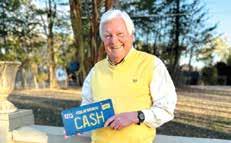
Claude Arthur Stuart Hamrick, 83, a retired San Jose patent lawyer, is offer-
ing the rights to his vanity plate for sale via website PlateBroker.com.
“Every time I traded cars, the dealers tried to buy it from me. Every car dealer in San Jose wanted that plate,” Hamrick told the San Jose Mercury News. “I told them I wouldn’t sell it for a million dollars.”

Hamrick is sticking with that statement, asking for $2 million.
License plate rights have made for lucrative sales in the past. Delaware, a state where low-numbered license plates are highly sought-after, saw a plate featuring the number 20 sell for $410,000 in 2018.
The most expensive license plate in the world hails from California. It has the letters “MM” on it and is valued at $24.3 million.
Hoping you’re not driving a Kia with that blingy plate.
The weekend in Iran is Thursday and Friday.




The long line of cars that snaked across the Atlantic Beach Bridge on Motzei Shabbos was testament to the throngs of people who ventured out in support of Mesivta Shaarei Chaim. The Melava Malka Reception was an opportunity for parents, grandparents, alumnae, community leaders ,and supporters to express their appreciation for this unique makom Torah in our community.
The evening began with two concurrent programs: One large room pulsated with the sound of bochurim, fathers, and grandfathers learning together enthusiastically. Simultaneously, mothers and grandmothers were inspired by Mrs. Ye -
hudis Feigenbaum, who relayed a personal story about the power of a bracha from a tzaddik and a mother’s devotion.
At the elaborate dinner that followed, the guests had the opportunity to hear Rabbi Yerachmiel Scheiner, Rosh HaYeshiva, retell how Shaarei Chaim grew from its founding class of three bochurim to its current enrollment of over 130 talmidim. While the first graduating class had only four bochurim, this year’s current twelfth grade has more than seven times that amount! Despite the growth, though, the Roshei Yeshiva have remained true to their mission: to help every bochur develop a love for and growth in learning. Indeed, the yeshiva

spares no effort in ensuring the boys are setting high standards and are meeting them.
Rav Leibel Rand, Rosh Kollel of Kollel Avreichim, explained that Torah is the root of all blessing. The high level of learning in the yeshiva brings bracha to those who support it. Rabbi Nosson Zupnik, Rosh HaYeshiva, expanded on the evening’s theme, hasmada. The devoted rabbeim in Mesivta Shaarei Chaim set a sterling example for the boys and motivate them without forcing them to take on extra sedarim. The enthusiasm within the beis medrash is unparalleled, and the comradery among the bochurim is legendary. The masterful video pre -
sentation that followed underscored this theme, as well: The hasmada in Mesivta Shaarei Chaim comes not from peer pressure, but rather from a genuine love of learning and passion to reach greater heights.
The magnificent evening was capped off with a heartfelt kumsitz for the bochurim and delicious dessert. The attendees left with renewed appreciation for this gem within our midst. With the devoted staff and community support, Mesivta Shaarei Chaim will continue to grow and raise the next generation of bochurim steeped in Torah and yiras Shamayim.





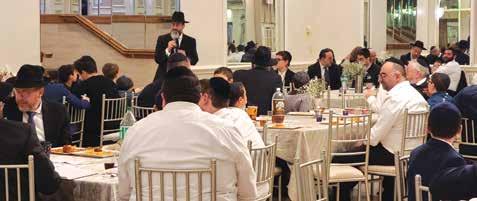




Students at Touro’s Lander College for Men (LCM) had the opportunity to learn first-hand what it takes to succeed in a variety of professions at LCM’s week-long Alumni Career Series, held this month. Twenty-seven alumni in 13 different fields presented to a group of 175 students, who gained a true understanding of the years of study and practical experience required to train for a profession.
Alumni who are currently employed in the fields of medicine, dentistry, accounting, nursing home administration, real estate, finance, computer science, education, law and more shared their personal career journeys, tips for success in their fields, how they achieve work life balance and how to manage religious observance in the workplace.
“The Alumni Career Dinner Series is a fantastic opportunity for current students to hear from successful Touro alumni about a career that interests them,” said Mrs. Jodi Smolen, Director of Career Services at Lander College for Men.
Accounting panelists offered advice for acing the CPA exam, securing internships, and getting through tax season.
Computer Science students discussed with panelists the merits of graduate level training, how to stay current in an ever-evolving field, and which skills are critical for success in the field.
“Don’t think that your writing courses



aren’t important. In addition to technical skills, you must be able to communicate well in order to get ahead,” said Ilya Epshteyn, Lander College for Men, 2002, Senior Manager at Amazon Web Services.
Newly minted physicians shared their career journeys, from studying for the MCAT and securing research internships to getting into and through med school to residency matching and life as a doctor.

“It was awesome to be able to hear from people just like us about the medical school process and what it’s like being a practicing doctor in today’s world. These are guys who had the same teachers and rebbeim as we currently have and so they’re the best examples of what we can, and G-d willing, will accomplish. Hearing about the pre-med process from professors and advisors can only get you so far, but hearing from guys who just went through it is the best way to prepare ourselves,” said Aharon Price, a premed student and junior at Lander College for Men.
After ushering in the month of Adar with an inspiring Hallel at the beginning of the week, MTA broke out Color War. Each grade represented one of the Four Parshiyos which we are currently reading as we move towards Purim. For two and a half days, the talmidim battled it out, showing their skills on the courts as well as their creativity and prowess in music, art, culinary arts, video production, and several other areas of expertise. The competition was fierce, and the lead passed between grades until the very end of the final day. In a surprising upset, the sophomore
grade emerged victorious, beating the juniors by a slim margin for the top spot. As is tradition, the grand finale of MTA Color War is an achdus kumzitz, bringing the four teams together as the scores are tabulated. There is no more beautiful sight than seeing talmidim from different grades come back together as a family just minutes after engaging in such intense competition. No matter how competitive the Color War may have been, the talmidim always realize that the achdus of our yeshiva is always more important than winning or losing.
On Tuesday evening, the Young Israel of Lawrence-Cedarhurst was packed with hundreds of people eager to learn about maximizing their finances at the first-ever Kosher Money event. The ambience was vibrant, with the audience asking thought-provoking questions during the Q&A sessions.


The event featured a keynote address from Rabbi Naftali Horowitz, a wealth advisor to multi-millionaires and a popular guest on the Kosher Money Podcast. Rabbi Horowitz shared his insights on the mindset of a successful investor which will be released as its own episode on the Kosher Money podcast. It was a jaw-dropping presentation, giving people tangible things to keep in mind throughout their life when working to grow their money.

The panel, moderated by podcast host Eli Langer, featured experts on behavioral finance, negotiations, and investing. The key to the panel was giving people practical takeaways they could immediately implement in their lives. Simi
Mandelbaum, a certified financial therapist, shared eye-opening wisdom on the emotions behind our money decisions. Mitchell Eisenberger discussed the art of negotiating and how to get the raise you deserve – and it works! Isaac Goldsmith spoke about the importance of starting to invest no matter where you are in life with whatever amount of money you could afford. Just get started!
The event was lit up by Miller Lighting (gorgeous!) and followed by networking with sponsors Infinity Land Services, a title insurance company; Nobl Wines, a European wine distributor; Approved Funding’s Shmuel Shayowitz, a leading mortgage provider and real estate expert; and the OU’s Living Smarter Jewish, a financial resource for Orthodox
Jewish families, which Eli highly recommended checking out at LivingSmarterJewish.org if you’re looking for a talented financial advisor at no cost.


Maximizing Your Money is expected to hit other cities across the U.S. in the coming months. Be sure to check out the Kosher Money podcast to help you in your financial journey, featured on all podcast platforms, as well as the Living L’chaim YouTube channel, which also features podcasts Inspiration for the Na-
tion, That’s an Issue (mental health podcast), and Charlene Aminoff’s Not Your Typical Podcast.

Shulamith banot reenacted the story of Purim using puppets and puppet theaters they created. Shulamith ECC wishes everyone a Chag Purim sameach!

At Yeshiva Darchei Torah’s second grade Brachos Bee

Earlier this season, on December 4, the 5 Towns JSL Basketball league played at halftime on the court at MSG. The Knicks won that game, and then proceeded to win 8 straight games. Since then, the magic has worn off and the team has played around .500 basketball. Julius Randle explained, “When we saw those boys with their skullcaps come in and drain 3s on our court, it filled our hearts with joy. We played freely like kids again for a couple weeks. It was inspiring.”
Knicks executives noticed and this week the team announced a startling, first-of-its-kind deal. The JSL will now provide players for a youth halftime game at all non-Shabbos home games. The Knicks even added a clause that the JSL hockey players can perform between periods at Rangers games to see if it provides the same morale boost. Team own-
er James Dolan said, “Many fans don’t like me. But I know a crowd-pleaser and a team-booster when I see one. Those Jewish kids can shoot!”
As part of the deal, FM Home Loans is now the official mortgage partner of the Knicks as well. Five Towns FM Home Loans Rep Gabe Tennenberg explained that “FM Home Loans and sports leagues go together like hot fudge and ice cream sundaes. It was inevitable that we would follow the JSL, our favorite local league, into this partnership with the Knicks and the NBA.”
Knicks scouts were also spotted at the recent JSL Men’s showdown between Yitzy Wieder and Shelby Rosenberg, as the Knicks explore all options to fill their final roster spots as they make a playoff push. After news of the new JSL halftime partnership broke, ESPN declared the Knicks favorites to come out of the East.
The World Baseball Classic kicks off in March. Amazingly, Team Israel has once again qualified for the event. This is despite the fact that there are less baseball fields in the entire State of Israel than there are in the Five Towns.
The way this happens is that a player is eligible to play for Team Israel if they are eligible to be an Israeli citizen. ANY Jew has a right to be an Israeli citizen, hence ANY Jew can play for Team Israel. As a result, current Jewish major leaguers like Joc Pederson of the Giants and Richard Bleier of the Red Sox are on the team, as is local legend and Diamondbacks prospect Jacob Steinmetz.
But experts are most excited by two recent additions to the roster. 5TLL Coach Yehuda Jacobs and 5TLL senior division superstar Yehuda Ross both made the final cut and have joined the team down in Miami to practice for the opening rounds.
Yehuda Jacobs is known for his tenacity, speed and home run power to all fields. He joins the team as a valuable bench player and assistant coach. Yehuda Ross is the youngest player to make a WBC roster, but don’t let that fool you. He plays with a skillset beyond his years, and many expect him to be the next superstar to emerge from the Five Towns, an area that is quickly becoming a hotbed of elite baseball talent. In the meantime, he is a solid bench option for an Israeli
National team that many think has a real shot this year.
Ross explained, “When my mom handed me the phone and said that Joc Pederson was calling for me, I thought it was a Rosh Chodesh Adar prank. I still can’t believe I get to Daven three times a day with current and former major league players.”
Experts say that the 5TLL’s unique emphasis on skill development and teamwork have resulted in well-rounded, elite athletes with exemplary middos and dedication. Local hotels have reportedly sold out for April-June as scouts plan to descend on 5TLL games to scour the rosters for the next up and coming Darchei, YKLI and YOSS stars. So make sure to follow Team Israel as the WBC begins later this month!





On a recent trip to Israel, Rabbi Shalom Axelrod of the Young Israel of Woodmere visited YIW students who are studying in Israel.
“It was special getting together with
our YIW shul students spending their year in Israel. We are so proud of their continued spiritual growth in their Torah studies,” Rabbi Shalom Axelrod said.
Boys in Rabbi Eisikovic’s class in Yeshiva Ketana of Long Island finished tracking their daily Meah Brachos for two weeks. A raffle was held on Zayin Adar, the yarhtzeit of Moshe Rabbeinu who taught Klal Yisroel the

mitzvah of saying 100 brachos a day. Please visit MeahBrachos.com for a daily chart to track your 100 brachos or email outloudbrachos@gmail.com with questions.



This past Sunday, HALB sixth grade girls celebrated the milestone of becoming B’not Mitzvah with their parents and teachers. The program began with Rabbi Fogel, Middle School Principal of Limudei Kodesh, running a workshop on tefillah. Then they enjoyed a delicious breakfast, while hearing powerful words of Torah from HALB’s Head of School, Rabbi Englander, as well as from some of the B’not Mitzvah. Drawing on the theme of “Women in Tanach,” guests were also able to peruse the girls’ projects, which displayed eleven inspi-

rational women from Tanach. Moving to the stage, our students sang of the painful tribulations that these women faced and how they came away with the message that “through all that pain, you start to grow.” In groups, the sixth grade girls then presented slides about the women whom they had respectively researched, all of whom serve as role models to our students.
Our new generation of nashim tzidkaniot (righteous women) is already off to an impressive start!


Last week, the JSL Men’s Championship game from FM Home Loans was played at the LWA gym and John’s Automotive emerged with a hard-fought victory over PIP Printing.
Team PIP Printing was led by captain Epphie Hoffman and Camp Manavu legends Yitz Wieder and Tzvi Mandel and co. They squared off against John’s Automotive, led by the fierce Rosenberg brothers, captain Rich Hocheiser, and Rabbi Ashie Schrier.
Hoffman, Wieder, and the rest of their team have dominated the JSL, winning the last three championships in a row. But John’s Automotive came out strong to finally dethrone them.
John’s Automotive took a five-point lead into halftime led by a pair of threes from Shelby Rosenberg. The second half was much the same with Shelby scoring
from beyond the arc and down low, helping John’s Auto expand their lead to a commanding 15 points.
With a little over a minute remaining in the game, Zev Teitlebaum scored a long three to cut the lead to single digits, but Ashie Schrier and Captain Rich Hocheiser answered right back with tough shots of their own and didn’t look back! Jay Steinmetz iced the game, hitting 5 free throws in the final minutes. John’s Automotive closed out the 50-38 victory, led by 20 points from Shelby Rosenberg.
Before the game, the league honored Ikey Cohen of Team Maidenbaum for his incredible individual performance throughout the season, setting records in three-pointers and threes.
The Spring Men’s JSL basketball season begins on March 5th.
Ahuge yasher koach to Coach T and our Shulamith Sharks team for winning the Playoffs game last week and making it to the Semifinals.

Thank you to our amazing Shulamith family for always showing your support.

Go Shulamith Sharks!


“Icannot believe how beautiful the process is. I am just shocked.”
This is one comment from a Holocaust survivor who, along with a group of fellow women survivors, toured the Grove Street Mikvah on February 9, 2023 with Russian-speaking guide Sora Levinson and Barbara Satt from the Jewish Community Council of the Rockaway Peninsula. The tour, organized by the JCCRP, was well received; the Holocaust survivors learned a lot from it and came away inspired.
The survivors first sat in the main lobby area of the mikvah and listened to Sora explain the basic ideas behind a mikvah. The women asked questions, and Sora answered them. Rena Lerner aided with Russian translation. Towards the end of the tour, the women went to see one of the actual mikvaos, where Sora explained the process.
Golda, one of the survivors, said, “I had previously only heard about the Mikvah from books and movies. It is nothing like what I expected. I cannot believe how beautiful the process is. I am just shocked.”
Many of the survivors said that they felt chills running down their bodies when they entered the Mikvah room. They were stunned by the beauty of the Mikvah. All of them were grateful to have the opportunity to tour the Mikvah and appreciated learning more about this special mitzvah. Thank you to Rebbetzin Chanie Wolowik for her assistance in bringing this incredible opportunity for our Holocaust survivors to fruition.
The JCCRP Holocaust Survivor Services Program is generously supported by UJA-Federation of New York and the Claims Conference (Conference on Jewish Material Claims Against Germany).



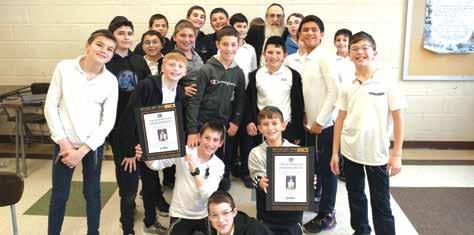

Week 7 of the JSL winter season brought to you by FM Home Loans is in the books! The basketball regular season came to end this past Sunday with some incredible finishes. Playoffs begin next Sunday.
The Middle School talmidim of Yeshiva Darchei Torah collectively raised funds to sponsor 21 new pairs of tefillin for bar mitzvah boys in the Shuvu network in Eretz Yisrael

The boys in our JSL Juniors division are showing some truly incredible improvement in their skills under the guidance of our great coaches as the season progresses. K/P Hockey: Gav Prince led the charge with an early goal for Simcha Day Camp, but Alpert Financial quickly shut them down with relentless offense and a double hat-trick from Benjy Blumenthal, ending the game with a 10-7 victory. Meanwhile, Gourmet Glatt fought hard against Home & Stone, storming back in the second half with an impressive seven goals to take the victory 8-5. And in a stunning offensive clinic, ARG put on a show with ten straight goals against Hewlett Auto Body. K/P Soccer: It was a nail-biting game between Future Care Consultants and ARG, as the former jumped out to an early 4-1 lead. But ARG wasn’t ready to throw in the towel just yet, hustling and clawing their way back into the game to take the contest with a final score of 8-5. 1st Hockey: Island Roofing fought hard against 4 Seasons AC, but Harrison Frenkel’s great shot ultimately sealed the deal, as 4 Seasons took the win 4-2. Meanwhile, Built by Nate put up an impressive fight against ARG, with Asher Newman’s beautiful goal tying the game up at 1-1. However, it wasn’t enough to stop ARG’s four straight goals, as they emerged victorious with a final score of 5-1.
3rd/4th: It was a wild ride on the courts this week, with Yehuda Fricker’s clutch free throw keeping ARG ahead for the win against Town Appliance with a final score of 15-14. Noam Rosman had a double double for Built by Nate, helping them win 31-16 against Posh Home + Bath, while Island Roofing and Maidenbaum ended in a tie at 8-8.
5th-7th: Aryeh Rosensweig led the charge for Wieder Orthodontics with 15 points and 5 assists, leading them to victory over Marciano with a final score of 33-23. And in a breakaway layup, Eliezer Sorotzkin brought home the win for Five Towns Orthodontics, dominating the game 28-8.
2nd/3rd: JNT beat MoldPro 3-0 in
an incredible game with phenomenal goalie performances. Despite Dani Polansky’s great outing for MoldPro, Shlomo Greenspan’s shutout sealed the deal for JNT. Meanwhile, Meat + Board kept their undefeated season alive with a 3-2 victory over 5 Towns Central, thanks in part to Aaron Lowenstein’s two goals. And in a true offensive spectacle, Alpert Financial took control against Elegant Lawns with four second period goals, ultimately winning the game 6-3. 4th/5th: Town Appliance shook off an early scare from Marciano to ultimately dominate with a final score of 8-3, with Eliezer Ketay as MVP for his solid defense. Five Towns Orthodontics had a close game against Posh Home + Bath, with Meir Greenspan and Eli Sherman leading them to a 5-3 victory, while AutoClick battled it out against 925 Sterling in a defensive battle that saw the latter emerge victorious with a final score of 3-2. 6th-8th: Ahron Neuman made waves with a FULL COURT goal for BayRock Insurance, but it wasn’t enough to stop Wieder Orthodontics, who dominated the game with four early goals from Yaakov Noam Levine and a fifth goal in the third period, winning 5-1. JNT had an offensive explosion Monday night with some incredible goals from Hunter Zeitlin.
Swag Corner: The JSL/FM Trick Shot Contest Winners will be picked this week and win a JSL mini hoop!
Game MVPS: Yitzchak Moskowitz, Mordechai Sorotzkin, Harrison Frankel, Chaim Mandelbaum, Avi Abramson, Aharon Levenson, Yitzy Statfeld, Isaac Edery, Eliezer Sorotzkin, Asher Weingarten, Binyomin Tennenberg, Eliezer Kitay, Dovi Einhorn, Dov Kreisman, Benjy Statfeld, and Jeremy Zeitlin

Ezra boys spent last Shabbos shteiging with the Traveling Chassidim in Monsey. Organized by Rabbi Eli Geller, Mashgiach Ruchani of Ezra Academy, Shabbos Shekalim counted in many significant ways for the Ezra senior boys. The senior boys, also members of the Kollel, contemplating spending a year in Israel were invited to Monsey, along with alumni to really spend time pondering the benefits of taking a gap year in yeshiva. The Shabbaton was attended by a mix of current senior boys, recent alumni back from their years of learning in Israel, and married alumni beginning their own families. The warmth of the experience was a truly perfect environment to reflect on the numerous advantages of spending post high schools year(s) learning in Israel. The beauty of Shabbos with the Traveling Chassidim only enhanced the idea that developing
a frum household of their own should be their priority. The program over Shabbos included so many inspiring events. From the opening toameha at the home of the Roydes to the seudah there on Friday night and the Melave Malka hosted by the same family, Ezra has extreme hakarat hatov for their hospitality. The boys were also treated to tremendous words of chizuk by various speakers over the weekend including Rabbi Yisroel Gottlieb, Rabbi Yisroel Royde, and Rabbi Yosef Heller. Additionally, the boys had time to learn b’chavrusa, organized in such a way that an alum was paired with a current student. These pairs have already outlasted the first learning moments as the chavrusas have met again over the past week.
All in all, the success of the Shabbaton can be felt in the positive feelings that continue after the last dance

Last week, the entire student body of Mesivta Ateres Yaakov embarked on their annual mid-winter retreat. Organized by Student Activity Coordinators Rabbi Shlomo Drebin and Rabbi Avromi Meyers, talmidim had the choice of spending the day skiing or snowboarding at Mountain Creek Ski Resort or enjoying an afternoon at Urban Air Trampoline Park and snowtubing at Campgaw.

The day began with divrei Torah from surprise guest speaker, Rabbi Yaakov Robinson, Mora d’Asra of Bais Medrash Mikor HaChaim in Chicago and brother of

11th grade rebbe at MAY, Rabbi Yehoshua Robinson. His divrei his’orirus resonated with the talmidim throughout the trip.
Talmidim were joined by rabbeim on the slopes, skiing and snowboarding throughout the afternoon, breaking only for lunch, Mincha and learning. Many boys opted to utilize bus travel time to learn with a chavrusa, while others spent some lodge-break time learning with their rabbeim.

“The trip accomplishes three things,” commented Menahel Rabbi Yossi Bennett. “It serves as a battery-re -
of melave malka, in the chavrusas and bonds that develop and are maintained after such a weekend and in the overwhelming push by the seniors to make posthigh school plans that involve a commitment to Torah. Ezra thanks Rabbi Geller, the Traveling Chassidim and the participants of the Shabbaton for a most impactful Shabbos.
charge during a long winter z’man, an opportunity to concretize relationships with friends and rabbeim outside of the yeshiva’s walls, and a way to apply the growth and learning in which our talmidim engage on a daily basis in real-world situations.”


The day’s events closed with the entire Mesivta joining together in Englewood, NJ, for a siyum by the Rosh HaYeshiva, Rabbi Mordechai Yaffe, a delicious dinner catered by Dougie’s, and a digital slideshow of pictures from the day’s events.




 By Hadassah Bay
By Hadassah Bay
This past Motzei Shabbos, the Mesivta Ateres Yaakov Eagles battled the Yeshiva Darchei Torah Bulldogs in the championship game of the inaugural season of the Mesivta Hockey League (MHL). When the dust settled, Coaches Yehuda and Shua Behar and their MAY Eagles were victorious and beat the Bulldogs, 3-1.
The MHL is the most recent installment of inter-yeshiva athletics from Mesivta Athletics, joining the Mesivta Football League and the Mesivta Basketball Association. The MHL, a competitive and exciting hockey league, was established this year with five pioneering yeshivos: Mesivta Ateres Yaakov, Yeshiva Darchei Torah, Yeshiva of Far Rockaway, Mesivta Netzach HaTorah and DRS High School.
Leading up to the championship game, both semifinal games were nailbiters and ended up in upsets. YFR (1) took on Darchei (4) and Netzach (2) went up against MAY (3). In the YFR vs Darchei matchup, the game ended in regulation with a tie, 1-1. After one overtime period, a shootout ensued and, in the 7th round,
Darchei won to take a spot in the championship game. In the Netzach vs. MAY game, MAY edged out Netzach 2-1 in a close game till the end.
The championship game drew a crowd of close to 200 spectators. MAY struck first and took a 1-0 lead. But Darchei quickly responded to tie it up 1-1. It didn’t take long for MAY to score two more goals, making it 3-1, and it held that lead for the duration of the game.
“The MHL is just another opportunity for the mesivtas in our community to enjoy wholesome and healthy competitive sports,” commented Rabbi Yossi Bennet, menahel at MAY and organizer of the League. “It was very gratifying watching the teams compete every Motzei Shabbos, with many fathers, friends and rebbeim cheering them on from the stands.”
The MHL thanks the League Commissioner, Mr. Zack Kessler, the referees, coaches, players and fans for a great first season. Congratulations go to Mesivta Ateres Yaakov on the inaugural win.
Kids and adults look forward all year to Purim, the festival of joy and celebration, but for Meir Panim patrons, that joy doesn’t come so easily. At branches across Israel, from Tzfat to Tibieras, Or Akiva, Jerusalem and Dimona, Meir Panim’s branch managers work overtime to ensure a happy holiday atmosphere with plenty of good, nourishing food for the hungry – needy families, single mothers, as well as the elderly and Holocaust survivors.
According to Mimi Rozmaryn, Director of Global Development, Purim prep at Meir Panim starts long before the piles of treats appear in the stores. By the week before Purim, each branch sets up its own mini costume boutique, with racks and racks of colorful, shiny costumes available for patrons.
Another Purim tradition at Meir Panim is to present each recipient with two mishloach manot packages — one to enjoy and one to share. “This beautiful initiative encapsulates what we’re all about,” says Mimi, “enabling our patrons not only to receive but to be on the giving end as well!”
On the day of Purim, all Meir Panim Restaurant-Style Soup Kitchens offer a special holiday meal in the festively decorated dining rooms.
Or Akiva branch manager Ilanit is passionate about providing hot meals and farm-fresh produce to her town’s neediest individuals and families. As Purim approaches, she broadens that mission, also delivering mishloach manot to “the unsung heroes of the community” – police officers, crossing guards, street cleaners, etc. But local children and adults with ASD also benefit from Ilanit’s sensitivity and generosity. “Purim can be difficult for the non-neurotypical,” explains Ilanit. “We’re attuned to their need for a more subdued celebration and strive help them celebrate the holiday in a way that suits them.”
Ilanit’s everyday work brings her in regular contact with children from families who are lowest on the socio-economic scale and who have suffered from severe personal circumstances. They, too, will receive her special attention on Purim.
The past winter has seen Meir Panim branch managers busier than ever. Down in Dimona, branch manager Nissim continues, in his modest, understated way, to ensure that all patrons have hot meals and in abundance. In addition, he works behind the scenes to better the lives of his patrons through various projects, including the women’s empowerment program, to help women escape the cycle of poverty. Recently, Nissim has turned the Meir Panim branch, during afternoon hours, into a safe and inviting “third space” for young people. Thank you to Bank Leumi for donating a huge screen, and Nissim for providing cups of delicious soup to warm up the atmosphere while keeping teens off the street!
With the increasingly tense security situation in Israel, Sderot is one of the first to suffer, with intermittent rocket attacks from Gaza. The teens of this border town, where some 70% suffer from some form of PTSD, are continuing to benefit tremendously from Meir Panim’s youth programs. Of special mention are the woodworking workshops at its Sderot Community Center, where kids have the opportunity to talk out their challenges in a relaxed, fun, social atmosphere. One of Meir Panim’s most loyal supporters is the town’s mayor, Alon Davidi, whose daughter Shira, a university student, is one of the volunteer counselors at the workshop.
You, too, can be a part of Meir Panim’s life-changing work! Make your donation today online at www.mpdonate.org, through the toll-free number at (877) 7-Donate / 877.736.6283 , or by mail to American Friends of Meir Panim at 88 Walton Street, Suite B1 Brooklyn, NY 11206-4479. All donations made in the U.S. are tax-deductible under EIN# 201582478.

The simcha of Adar and joy of toil and accomplishment was present at Mesivta Netzach HaTorah in Woodmere this past Wednesday, Rosh Chodesh Adar, where 13 talmidim joined to make a siyum on Meseches Megillah. The Mesivta welcomed Rabbi Binyomin Eisenberger, shlit”a, to share divrei Torah and chizuk, together with heartfelt singing and dancing! Following the seudah and siyum by one of
the talmidim, Rav Eisenberger spoke to the Mesivta on the importance of a true connection to Hashem through Torah and tefillah, captivating the entire Mesivta and rebbeim with his inspiring words.

At the conclusion of the seudah and siyum, Rav Eisenberger personally presented each mesayim with a sefer, giving brachos and chizuk to the talmidim as they lined up to escort him out.

The Flatbush Jewish Community Coalition (FJCC) hosted a leadership meeting to introduce the NYPD’s new Commanding Officer of Patrol Borough Brooklyn South, Chief Charles McEvoy to community leadership. In light of recent antisemitic attacks and an uptick in crime, the meeting was an opportunity for yeshiva, shul and community leaders to discuss their concerns with NYPD brass. The meeting, held at the Ohel building, was attended by more than 50 leaders under the FJCC coalition. It was coordinated by NYPD Brooklyn South Community Affairs Commander Lt. Ira Jablonsky who continuously works alongside the Chief day and night to ensure the community's safety. Rabbi Moshe Scheinerman, rav of Khal Bnei Yeshivos, gave the opening invocation.

Senator Simcha Felder, Assembly Member Simcha Eichenstein, and Council Members Kalman Yeger and Inna Vernikov participated to show solidarity for a safe, secure and flourishing community. Inspector Richie Taylor, Commanding Officer of Community Affairs, brought a message of support from One
Police Plaza. Mayor Eric Adams and the FJCC honored police officers Meir Green and Jessica Morgan-Brown of the 76 Precinct for their bravery in the line of duty. They rescued a transit rider who fell on the tracks in a video that went viral. The Mayoral award was presented by Senior Advisor to the Mayor Joel Eisdorfer and Commissioner of the Community Affairs Unit, Fred Kreizman.
Flatbush is the largest demographic and geographic Jewish community in New York encompassing six police precincts. The commanders of the 60, 61, 62, 63, 66, 70 precincts and their community affairs staff attended the meeting and interacted with the yeshiva and shul leaders. As Rabbi Rephael Netanel, Dean of Students at YDE, stated, “This crucial leadership interaction fosters relationships and communication that help keep our students safe.”
FJCC Chairman Josh Mehlman and executive board member Rafi Treitel chaired the meeting, welcoming the officers and the community leaders, whose attendance indicates their deep commitment to serving the community. The FJCC was established in July 2013 to
unite the greater Flatbush Jewish community on communal, civic, and political concerns. The Coalition represents over
Did you know?
200 organizations, shuls, yeshivas, and Bais Yaakov schools.
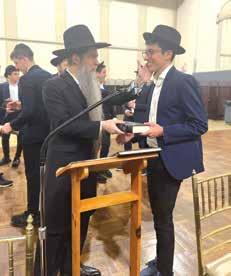
Tea is served at official gatherings and meals in Iran.
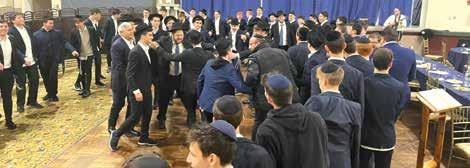


The challenge was clear but the solution was not: Develop a technological answer to an African village’s poverty and lack of clean water.
STEM teams from nearly twenty schools gathered in Industry City, NY, to take on this challenge at the CIJE (Center for Initiatives in Jewish Education) 2023 Hackathon. Teams representing the competing schools were provided with background information and the details of the challenge by Innovation Africa, a company that shares its technological know-how to improve conditions in Africa as part of its mission to help the global community. The students were given new technology to work with and had to create a working model of their invention, as well as deliver an effective presentation about their design. While the students’ teachers accompanied them to the event, the students were really “on their own” as they worked for several hours to develop their project. The job was intense and fast-paced, and ultimately, the Shevach team emerged as a semifinalist with their working model and highly compelling presentation.
Sara Davidov, one of the team members, shared, “We learned about the lack of pure water, electricity, education, and so many more aspects of life that are considered necessities in our daily lives. My friends and I started thinking and brainstorming, and we came up with the idea of a hygienic shower. This source of water for the shower would be from a pump in the lake. The water would go through a water heater, which would kill all of the bacteria. The water would then travel through tubes and go through another filter in the showerhead that would get rid of any debris that was found in the water e.g. rocks, plastic, mud, etc. before coming out of the shower head. We
also added a distance sensor that would sense when a person was underneath the shower head or far away. It would turn on the water when a person came near the showerhead, and it would turn off the water as soon as the person left, which would ultimately save a lot of water. We also added a temperature sensor that would tell a person how hot or cold the water is in order to determine how much longer they should let the water warm up for. The website we designed would let the person know if the shower is occupied or if it is vacant.
“Altogether, the Hackathon was a fun and educational experience that I really enjoyed, and I would love to go back if I had the chance!”
Ahava Yusupova expressed, “I liked creating new things and being able to form a project using our imagination and skill. I enjoyed working with my team, brainstorming a project, and seeing it being made through our own work. It was fun to see many schools come together and participate.”
Yael Zimmerman remarked, “I learned website design with html and some new coding skills. I didn’t come in with any expectations of winning but it only makes me prouder that we did… I’m so proud of what we were able to accomplish in such a short time.”
Shevach High School, and especially the Hackathon team members, Sarah Davidov, Yael Goldfarb. Tehila Levant, Ahava Yusupova, and Yael Zimmerman, are truly grateful to Mrs. Paula Berger, Shevach’s STEM course instructor, for facilitating this incredible experience. Hopefully those who are in need around the world will soon be better off…and it may just be through the teamwork, effort, and ingenuity of students just like the Shevach Hackathon Team of 2023!

Rabbi Weiss and his fourth grade class at Siach Yitzchok have been working on the halachos of tzitzis



and on the actual making of their own tzitzis for a long time. Finally, after much work, they completed the project.
The fourth grade in TAG got to see Torah come to life with a special visit from the Living Torah Museum. The girls were mesmerized by Rabbi




This past weekend, Congressman Anthony D’Esposito (NY-04), a member of the House Homeland Security Committee, joined several of his committee colleagues at the United States-Mexico border in El Paso. As part of his visit to America’s southern entryway, Rep. D’Esposito met with representatives from area law enforcement agencies tasked with maintaining order at the border, including Customs and Border Protection, Homeland Security Investigations (HSI) and the Texas Department of Public Safety.
The trip by D’Esposito allowed the Long Island freshman to highlight glaring security deficiencies currently plaguing America’s southern border. While meeting with Border Patrol agents, Rep.
D’Esposito witnessed both a seizure of fentanyl by a smuggler attempting to cross into the United States from Mexico via car, as well as a segment of border fencing which was dismantled by migrants – allowing border crossers to enter the country undetected. What’s more, while participating in overhead observation of the border from a Border Patrol helicopter, D’Esposito observed several migrants attempting to scale border security structures.
A retired NYPD Detective, Rep. D’Esposito has made supporting law enforcement a cornerstone of his congressional agenda. As a member of the House Homeland Security Committee, D’Esposito is committed to furnishing law enforcement agencies operating on the
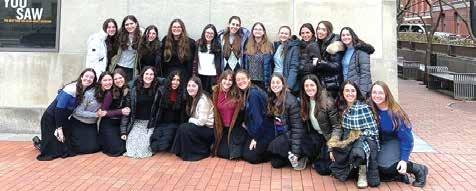
This past Motzei Shabbos, MTA talmidim and parents converged on Washington Heights to enjoy an evening together with the MTA family. With delicious food provided by the local eateries, the night began with the opportunity to reconnect with friends from across the tri-state area. Then the crowd headed to the gym for dancing to the mu-
sic of Baruch Levine. Rebbeim, talmidim, and their fathers danced around in exuberance to the songs of Adar and Purim expressing their love and appreciation for a yeshiva that is and has been home to so many. The families then took seats as divrei Torah were shared by Menahel Rabbi Shimon Schenker and senior Avi Cohen. After the inspirational words of

On Monday, February 13, Central seniors in the “From the Ashes” Holocaust education program had the privilege of visiting Washington, D.C., for an educational and memorable trip. Participants in the program had been working diligently, meeting once a week with faculty advisor and Holocaust educator Rabbi Dr. Joshua Strulowitz, for both history of the Holocaust sessions and lessons on interview techniques. These lessons culminated in a full-day trip to Washington, D.C., where students, accompanied by Rabbi Dr. Strulowitz and Head of School Ms. Bracha Rutner, visited the United States Holocaust Memorial Museum. The group completed a self-guided tour, which allowed for each student to walk through the museum at her own pace. Both returning visitors and those who were experiencing the museum for the first time noted how meaningful the exhibits were.
“I had been to the Holocaust muse -
um in eighth grade,” said Rivka Sullivan (‘23), “but coming back four years later with so much more knowledge was such an emotional experience.”
After the museum tour, the group walked through the streets of D.C., passing both the Washington Monument and the Lincoln Memorial, to the next stop on the trip: the Dwight D. Eisenhower Executive Office Building. There, they were met by Cynthia Bernstein, a graduate of both Central (‘02) and Stern College for Women (‘06), who currently serves as the Director of Management and Administration in the Office of the Vice President. Led by Ms. Bernstein, the group walked through the Eisenhower building and were seated in one of the offices, where they had the opportunity to hear from Aviva Feuerstein, a speechwriter for the White House, and Shelley Greenspan, the White House Jewish Liaison. The Central seniors were hugely appreciative to hear from Ms. Feuerstein, Ms. Green-
border with the tools they need to combat smuggling operations, end the fentanyl/drug cross border pipeline, and get a handle on the overwhelming migrant crisis.
“The deteriorating security situation along the United States-Mexico border poses a threat to American communities across the country, not just here in Texas,” said D’Esposito. “The federal government’s underfunding of area law enforcement agencies like Customs and Border Protection has produced a situation where an untold amount of drug smugglers, human traffickers, and other illegal entrants can cross into the United States with ease. It is vital the Biden Administration directs additional funding to beleaguered CBP personnel and
Torah had been shared, the lights were shut and a heartfelt kumzitz ensued. The room was filled with the beautiful sound of sincere song as talmidim, parents, and rebbeim joined together in harmony. The night concluded with one last round of dancing as the talmidim and their fathers kept the ruach going after the kumzitz had officially come to a close.
provides them with the tools they need to secure our Nation’s borders.”
span, and Ms. Bernstein, who had taken the time out of their packed schedules to meet them.
“It was incredibly meaningful to hear the stories of three prominent Jewish women working in government, especially after coming from the Holocaust museum,” said Gabi Lefkowitz (‘23). “It really showed me how far the Jewish people have come since then, and it was a nice full-circle moment for the day.”
Inspired by the visit to Washing-
ton, D.C., participants in the “From the Ashes” program immediately continued preparing for their interviews with Holocaust survivors. Each student will have the privilege of speaking to a survivor and will work in groups to record, edit, and present a short film about those stories. The interviews will be taking place in early March, and the videos will be presented to the entire Central student body and faculty on Yom HaShoah.
Purim spirit was definitely in the air at the Stella K. Abraham High School for Girls the week of February 21. With a hilarious costume contest on Tuesday and a Dress Up Decades Day on Wednesday, SKA students proved they are extraordinarily creative. Contributing to the lighthearted festive atmosphere, several SKA faculty members dressed as they did in high school while many girls continued wearing Purim garb the rest of the week!
Chagiga, grade-wide programs and parties, and pre-school and i-Shine carnivals are coming – we can’t wait for Purim at SKA!


Yeshiva Darchei Torah second graders tie-dyeing shirts as they learn about the melacha of tzoveya, part of a yearlong experiential lesson in the 39 Avos Melachos of Shabbos.


It was an action-packed week in the HANC Elementary School in West Hempstead. Ushering in the happy month of Adar, the students and teachers wore silly hats and funny socks to add to the festivity of the first day of Rosh Chodesh. As the children and staff entered the building, they were delighted to see that the lobby and lunchroom had been decorated with multi-colored streamers, adding a carnival atmosphere to the fun days ahead. On Wednesday, the children dressed up as what they aspire to be doing in the future. Their ideas were priceless: doctors, artists, sports players, mothers and fathers, teachers, astronauts, scientists, and even an old lady. Festive activities took place throughout the day in the classrooms, and the PTA distributed delicious hamantashen as a pre-Purim treat.

Friday marked the 100th day of school, and the first graders came to school wearing shirts that they decorated themselves which depicted the number 100. The creative ideas included 100 stickers, pompoms, googly eyes, BandAids, and even a 100 piece puzzle. Some children drew 100 rainbows, hearts, and other pictures on their shirts all by themselves. Throughout the day, the students participated in activities that explored
the many ways one can calculate 100. The highlight of this busy week arrived with school-wide participation in the mitzvah of hachnasat orchim. HANC invited all of the neighborhood children who attend public school to come to HANC for a day of learning and fun. The guests and their parents joined hundreds of students in a spirited full-school Rabbi Kelemer Shabbat Assembly designed with the special guests in mind. The festive assembly included singing, dancing, divrei Torah and raffles. At the conclusion of the program, each guest was called up to the stage and was presented with a siddur or Megillat Esther personalized with their Hebrew name inside. They then joined their peers back in the classrooms for a Parshat Terumah lesson and ate lunch together with the HANC students. The parents were also treated to a lively discussion with HANC’s Assistant Principal, Mrs. Michal Wasser, and enjoyed a special lunch in their honor as well.
This wonderful achdut program would not have been possible without HANC parent Ayelet Mottahedeh, who conceived of the idea, sponsored it and worked tirelessly along with the administration to bring the program to fruition.




HALB Lev Chana celebrated day one of Read Across America with a very special visit from author Ariella Prince Guttman. The chil-


dren loved listening to her read from her book “Wherever You’ll Be” and asked many thoughtful questions.

Amuch-anticipated event at Shulamith is the annual Brachot Bee for 3rd and 4th graders. The bee gives students the chance to work with their morot on improving their knowledge of what bracha to say on a myriad of foods. The girls spent weeks reviewing brachot and participated in classroom bees to determine the contestants for the main event, which took place on the stage of the Shulamith auditorium. Yasher koach to our Brachot Bee champion, Rachel Rabinow, and to all of the third and fourth graders for improving their knowledge of brachot!
DRS believe that the relationship built between talmidim and rabbeim doesn’t only exist within the confines of the classroom. That is why the yeshiva runs multiple Shabbatons, weekend tisches and many other extra-school programs throughout the school year. Aside from the Freshmen Shabbaton at Camp Kaylie at the beginning of the year, and Schoolwide Shabbaton in November, one of the highlights of the year for many of our talmidim is the opportunity to spend Shabbos with rab -


beim in their houses. Many of the Rabbeim hold annual “Shiur Shabbatons” in their homes. Additionally, each grade has their own “mini-Shabbaton” where students eat meals at friends’ homes, and gather together for grade-wide tisches and shalosh seudos events.
DRS’s beautiful building in the heart of Woodmere also plays host to Simchas Torah Hakafos, the Annual Yeshiva Purim Chagigah, an all-night learning program on Shavuos, and the Beis Medrash is open nightly until 10:00.






Gesher celebrated Rosh Chodesh Adar with a hilarious and entertaining puppet show by the Small Wonder Puppet Theatre. The children got to see the Purim story acted out right before their eyes with all of its excitement and drama. They also dressed up in silly costumes in order to get into the spirit of Purim. We really feel the excitement in the air as Purim approaches!


On Sunday, February 26, over 500 HAFTR parents, friends and faculty joined together to celebrate HAFTR’s 43rd Annual Dinner Experience, commemorating HAFTR’s past, present, and future. The event took place at 140 Central and featured a 5-star menu from MD Hospitality. At the end of the night, guests got to build their own dessert: a chocolate tree, featuring choc-
olate mousse and cotton candy leaves to symbolize how we will continue to grow and build HAFTR’s future together.
HAFTR would like to extend a warm mazal tov to this year’s honorees: Melisa and Chaim Lazarus, Guests of Honor; Cyndy Goldberg, Faculty of the Year; and Chavia Libin, Hakarot Hatov Award. Thank you for your contributions to our beautiful community and institution.










The past two weeks in the Mercaz Academy library in Plainview are among the most anticipated of the year. In previous years at this time, students hosted the Mock Caldecott Awards, and this year marks the first time for the Mercaz Academy Mock Caldecott Awards. Every year, as the American Library Association comes together to announce the best picture book of the year, our students do the same. School librarian Francie Goldberg prepares the students by teaching about picture books and previous winners and narrows the
wide field of competition to the top three contenders.
Students in grades one through six analyze the art techniques used in the books, how the pictures complement the text, and whether the book appeals to the population as represented by the students at Mercaz Academy. After much analysis and voting, Too Many Pigs and One Big Bad Wolf by Davide Cali and illustrated by Marianna Balducci took the gold Caldecott Medal at Mercaz. The Mercaz panel bestowed the Caldecott Honor on Walter Had A Best Friend by
Deborah Underwood, illustrated by Sergio Ruzzier. A very close third was Hot Dog, written and illustrated by Doug Salati (winner of the real Caldecott Medal for 2023).
The library students spent last week writing letters to the illustrators to notify them that they won our school competition and awarding them their Mercaz Medals. Of course, all Mercaz Medalist authors are welcome to pick up their honor in person should they wish to do so.
YCQ junior high students arrived at the beautiful Bushkill Inn early Friday afternoon. After lunch, students enjoyed swimming in the indoor pool and playing sports. Before tefilah, students participated in exciting “Pre-Shabbat ruach” and welcomed Shabbat with singing and dancing. The energy continued throughout davening and a musical Kabbalat Shabbat.
During the meal on Friday night, divrei Torah were given by Eitan Berkowitz, Alex Hartstein, and Ariel Basalel. Students then broke into small learning groups with their rebbeim. The ruach levels stayed strong throughout the night with a “Schnitzel Extreme” game show, a Let’s Make a Deal type of game, hosted by the Schnitzel Guys. A rocking oneg shabbat filled with more songs and Shabbat spirit concluded the night.
Shabbat morning kicked off with tefillah and a kiddush, and then students participated in an engaging and entertaining trivia game featuring questions about Torah and sports written by Rabbi Bernstein. After a delicious lunch that featured divrei Torah from Jacob Geula,

Mikey Fried, and Gabriel Koptiev, more games were played with rebbeim, including Jeopardy! and a guessing game involving baby pictures of school staff.
Mincha and a meaningful seudat shlishit that included divrei Torah from Eli Samet, Brandon Rakhminov, and Yona Canter wrapped up Shabbat, but the Shabbaton was far from over. After Havdalah, the ruach train was full steam ahead with a musical Melave Malka that featured more singing and dancing. A special shout out to the eighth graders for really stepping up and leading the school with their enthusiasm. Throughout Shabbat, tickets were distributed for participation in activities, and the Shabbaton concluded with a mega raffle with some remarkable prizes including a hoverboard!
Special thanks to Mr. Jacob Grossman, the Director of JHS Student Life and Activities, for all of his effort organizing the Shabbaton. All the rebbeim, their families, and the 17 alumni advisors, whose presence truly enhanced the Shabbaton, also deserve appreciation.

Here at HANC, students jumped right in at the opportunity to participate in Pink Day in support of Sharsheret, a non-profit organization with the goal of supporting women and health.
On Wednesday, February 15, students and faculty dressed in pink and brought in pink shtick to represent the day. The

Pre-Med Society sold pink-glazed doughnuts during club hour as a fundraiser for Sharsheret.
Kudos to senior Tzippora Friedman for spearheading this important event. Thank you to all the students and faculty who made Pink Day both spirited and meaningful!
When you read a story from Rabbi Yechiel Spero, you know there will be more.
More inspiration. More surprises. More lessons and more uplift.
In his latest book, There’s More to the Story, we read about:
•A young American boy trapped in Siberia who finds a unique way to hear shofar on Rosh Hashanah.
• A loner, dependent on his neighbors in Lakewood. A washing machine that keeps breaking down. A story that will change the way you look at the power of chessed.
• An elderly woman who’d rejected her teacher, Sarah Schenirer, but finds her way back to Yiddishkeit almost seven decades later with the help of a young Bais Yaakov student.
…And so many more!
We read stories about the man who ran the world’s most grueling marathon –in his bedroom, where he was trapped by Covid-19. About the Holocaust survivor who told the judge he’d earned his doctorate – in the university of life. About the mix-up that sent a gorgeous three-layered cake to a young boy’s classroom siyum and ensured he would stay Torah-observant many years later.
These stories are, indeed, a treasure trove, gems sparkling with emunah, ahavas Yisrael, and the power of prayer and hashgachah pratis: a precious gift from a master storyteller.

The following is one of the dazzling stories in this new must-read book.
Reb Leibel Kutner, a well-known Gerrer Chassid from Lodz, whose tidbits of chizuk inspired thousands, lived in Tel Aviv following World War II. Until he passed away, he continued to inspire everyone with whom he interacted.
During the war, Reb Leibel endured unspeakable tragedy, as he lost his wife and eight children. Through it all, he held steadfast to his emunah, bitachon, and simchas hachaim. Even in the darkest of times, Reb Leibel continued to infuse those around him with the fighting spirit and spark that only a Yid possesses.
In one of the labor camps in which
he was incarcerated, Reb Leibel worked in a munitions factory for twelve hours a day. In a desperate race against time, the German Nazi war machine attempted to produce as much ammunition as possible. The inmates were forced to work vigorously, but it was never enough.
One evening, one of the ammunition machines malfunctioned, halting the entire production line. For all intents and purposes, output for the next day would have to be called off, unless the machine could be fixed. Seething with rage, the Nazi foreman glared at the terrified prisoners. As he walked back and forth, clicking his heels, he sized up each of the prisoners standing before him. No one knew what he was preparing to do, and they feared the worst.
His eyes locked onto Reb Leibel. “You! You will be the one to fix the machine!”
Reb Leibel did not know how to respond. He had no expertise in repairing machinery. He was merely doing what everyone else was doing, trying to look busy so he could survive. He didn’t even know where to begin. Looking back at the Nazi, he responded simply, “I don’t know how to fix machines.”
Though he knew that excuses were intolerable, he had to at least state his case.
The guard was adamant, insisting, “Du bist ah Yid, you are a Jew! Uhn ah Yid kent, and a Jew can!”
Reb Leibel knew that if he refused at that point, he would be shot on the spot. Yet if he didn’t succeed, he would also be shot. The machine had to be fixed by morning; if he didn’t repair it successfully, he would surely die. However, he still had the whole night, so he had to try. After all, as the Nazi expressed, “Du bist ah Yid, You are a Jew! Uhn ah Yid kent, and a Jew can!”
Reb Leibel stood over the machine the entire night. Taking his time, he disassembled it, unscrewing it bit by bit, part by part, and piece by piece. He hoped that somehow by taking it apart and putting it back together, the machine would whir into action. After greasing the disassembled parts, he began the difficult task of fitting everything together.
His back hurt, his whole body was exhausted, but he tried his utmost not to allow any negative thoughts to fill his mind. Over and over, his chizuk came from the most unexpected place. The words of the
wicked man, his tormentor, echoed in his mind and in his neshamah. “Du bist ah Yid, You are a Jew! Uhn ah Yid kent, and a Jew can!” Every time he thought of giving up, the refrain played in his mind once more. “Du bist ah Yid, You are a Jew! Uhn ah Yid kent, and a Jew can!” And he marched on.
The hours passed quickly, and the sun was beginning to rise. Time was running short, as the last precious few moments of night disappeared. He held his breath and pressed the ignition. The machine rattled and shook violently. Reb Leibel whispered a prayer and then, miraculously, the machine began to purr.
A short while later, the Nazi barged into the factory, expecting failure and ready to pounce on his victim. When he saw the machine working, he could hardly believe his eyes. Yes, he had demanded that it be fixed, but the skeletal Jew had been given little to work with and possessed no knowledge of the machine he was ordered to repair. Somehow, he had managed to bring it back to life.
Reb Leibel noticed the surprise in the German officer’s expression and decided to capitalize on the moment. He cleared his throat and boldly spoke up. “I think that since I did such a good job fixing the machine, I should be rewarded.”
Those within earshot listened in alarm. They wanted to run for cover. No one spoke that way to the Nazis. No one had the gall or audacity to dare ask for anything. One’s very breath was not a given. Nevertheless, Reb Leibel seemed firm in his request. He knew that asking for a reward would lift the spirits of his fellow brothers and imbue them with hope. Undoubtedly, it would give them a little more desperately needed oomph in their step. He had to do it.
The other inmates waited anxiously, hoping the Nazi would not remove his
gun and instantly end Reb Leibel’s life. He didn’t.
Instead, himself stunned by the request, the Nazi asked Reb Leibel what he had in mind. Reb Leibel didn’t need much. He just wanted a few cigarettes as compensation. Shockingly, the Nazi reached into his pocket, pulled out a few cigarettes, and handed them to Reb Leibel, as everyone else felt a great sense of pride. The Nazi looked around one last time, turned around abruptly, and walked out the door.
Holding a lit cigarette in his hand, Reb Leibel turned to the inmate standing next to him and declared with confidence and strength, “Du bist ah Yid, You are a Jew! Uhn ah Yid kent, and a Jew can!”
Turning to the next one, he reiterated his statement. Over and over, the chant was repeated. “Du bist ah Yid, You are a Jew! Uhn ah Yid kent, and a Jew can!”
It’s the refrain we have uttered again and again, since the beginning of this long and bitter exile.
It’s the refrain we can never forget.
“Du bist ah Yid, You are a Jew! Uhn ah Yid kent, and a Jew can!”
Ancient Persians developed the first ever known refrigerator known as yakhchal, a dome structure that produced ice and kept food cold.



Every year, as is probably the case in many Jewish homes, my dear wife Yael and I discuss what to include in our mishloach manos packages. Like everyone else, we distribute them on Purim to rabbis, teachers, friends, and relatives around town. I call it the Mishloach Manos game.
There is often an inner feeling that the package is not “good” or “original” enough, whatever that means. Every one of us has his/her sense of what is adequate to give out in our Purim gift packs. When it comes to wine, there is a growing diversity of options ranging from the inexpensive, straightforward wine to some of the finest kosher wines now available in small 187ml or 375ml formats.
One of the most popular choices remains the Bartenura Moscato in its signature blue bottle. Suppose you want to go more sophisticated and appeal to those


who like it sweet. In that case, you can choose the delicious Carmel Signature Late Harvest Gewurztraminer, a delicious dessert wine that will be great to pair with jelly-filled hamentaschen. For those who would like to gift a fun, sweet wine but go for something more affordable, the Bartenura cans are perfect. You can even choose between the classic white Moscato and the Rosato. For yet another highend option besides the aforementioned Carmel, a favorite of mine that is just as original, there is the Covenant Zahav Late Harvest Chardonnay.
We should also certainly remember our dry wine-loving friends, especially since the festive meal on Purim is a seudas mitzvah, which requires meat according to many opinions and customs. And thus, here is a selection of 375ml formats for some of the best kosher red wines, including Mevushal and non-Mevushal wines. Château Les Riganes is a line of inexpensive, yet lovely Bordeaux wines meant to be enjoyed young. It will
go well with relatively light dishes such as a charcuterie platter. And it is available in both the 375ml and 187ml formats. Even Château Roubine, the topnotch Provence winery specializing in high-quality dry rosé wines, offers its flagship Premium Cru Classé rosé in a 375ml bottle.
For the pièce de résistance, some options are much fuller-bodied in a variety
of styles and grape varieties: Celler de Capçanes Peraj Ha’abib ; Shiloh Secret Reserve Cabernet Sauvignon ; Psâgot Cabernet Sauvignon ; and Château de Parsac by Baron de Rothschild.


These excellent wines should pair with a roast or steaks wonderfully.
So wine-tune your Purim game however you and your friends like it.
L’chaim – Purim sameach!

Oops, I forgot that I am supposed to speak to English to you guys. Seriously, learn another language! It’s a great hobby— around six weeks ago, I decided to teach myself Mandarin, and now I’m fluent.
Anyway, yes, yes, yes, Purim is here. I will be manning a spy balloon over the Five Towns to get pictures of all the amazing costumes. But I need to send the photos back to my handlers in China so I’m not sure that I will get them back in time to print in the TJH’s Purim Photo Album. So, just to make sure that everyone gets to see your IDF costume, send in your photos to TJH. Seriously, snap away and keep the Purim spirit going for another few days.
Send in your Purim pics to editor@fivetownsjewishhome. com. They specifically asked me to mention that in the subject line you should write “Purim Pics.”
I know that the TJH office is going to get at least six phone calls:
“Yeah, hi, I by mistake wrote Purim Photos in the subject line. Is that a problem? Do I have to resend the pictchaaaas?”



for you at the office and will submit it for approval with the subject-line department. And it’s even OK if you didn’t capitalize the “P” in Purim; we will handle that as well.
But if you don’t send it to the correct email address, then you are on your own. I don’t want to have to have this discussion with you:
Oh, wow, really, I must have sent it to the wrong email address. You mean you can’t find it?
Sally, if you sent it to the wrong email address, there are around 15,000,000,000,000 possibilities of where that email may be. I don’t have the time to find it. So do me a favor— now that you know that you sent it to the wrong address, instead of making me do the search (I’m kind of tied up in America right now), do you mind sending it again, but this time to the correct email address?
Oh, Sally, I was also joking at the beginning of this letter when I said that I’m flying a Chinese balloon over the Five Towns on Purim. I could explain to you why I made that joke but, as E.B. White said, “Humor can be dissected, as a frog can, but the thing dies in the process.”
Sally, you don’t want us to start dissecting frogs here, do you?
Happy Purim, Sally!

No, Sally, you don’t have to resend the pictchaaaas. We will fill out the wrong subject line form [Form WSL246-TJH(B)(ii-a)]
- Comrade Centerfold CommissionerUsing our proprietary algorithms, once you answer the following questions, we will be able to discern with 99% probability what your favorite hamantash is. So, let’s play ball. You got people to meet and hamantashen to eat!

1. Hamantashen are a true love of mine. If you were an herb, you would be:
a. Parsley
b. Sage
c. Rosemary
d. Thyme
2. If you could learn another language, which of the following would you choose?
a. Klingon
b. Xhosha (Clicking language)
c. Khoisan
d. !XOO (pronounced “Taa”….Don’t blame me, I didn’t make it up)
3. Which of the following do you prefer to visit?
a. New York underground sewer system (AKA “The Subway”)
b. Dial Seven Car Service dispatch booth
c. The library
d. Galapagos Islands
4. If you can give yourself a new name today, would you give yourself the letter X as your middle initial?
a. Yes
b. No
5. Which of the following careers would you choose?
a. Zip line instructor
b. Food taster
c. Beekeeper
d. Pistachio nut collector
6. What’s the one thing you can’t live without?

a. Your pet lizard
b. TJH
c. Your perm
d. Your gold-plated dentures
7. If you could talk to one of the following people, who would you choose?
a. Zvika from Bazooka gum
b. W.B. Mason
c. Mr. Clean
d. Aunt Jemima
8. Which of the following books do you like the most?
a. How to Lose Friends and Not Influence People
b. The Seven Habits of Highly Dysfunctional People
c. The Road Less Traveled (A Guide to Brookville Boulevard)
d. Man’s Search for Meating (How to Make the Perfect BBQ)
9. If you could eat one thing for the rest of your life, what would it be?
a. Poppy seeds
b. Raspberry
c. Chocolate
d. Prunes
e. Apricots
f. Pizza
g. Steak
h. Sushi
i. Ice cream
Your favorite Hamantash is:

Poppy Seed Hamantash - If you answered A to at least three questions and C to at least two questions, and you answered A to question 9.
Raspberry Hamantash - If you answered B to at least five questions and D to at least two questions, and you answered B to question 9.
Chocolate Hamantash - If you answered C to at least three questions and B to at least two questions, and you answered C to question 9.
Prune Hamantash - If you answered D to at least three questions and C to at least two questions, and you answered D to question 9.
Apricot Hamantash - If you ignored the first eight questions because you were too busy eating apricots and you answered E to question 9.
Not bad, huh? Don’t ever accuse me of not being a genius. That’s why they call me Dr. Centerfold, Md., PhD, LCSW, LCPC, MSW, TJHCFC


 By Rabbi Berel Wein
By Rabbi Berel Wein
One of the main garments that the High Priest of Israel donned was the jewel-bestudded breastplate – choshen – that he wore upon his chest. This breastplate contained twelve precious jewels of different colors and on each of the stones was engraved the name of one of the tribes of Israel.
In addition to these stones, there were two large, elongated diamond stones that were embedded in the shoulder straps of the apron – eiphod – that the High Priest wore. Engraved on those shoulder strap stones were the names of the Patriarchs of Israel and a reference to all of the tribes
of Israel. Thus, all of the twenty-two letters of the Hebrew alphabet were to be found on these stones in the breastplate and on the shoulder straps. This allowed these stones and their engraved letters to serve as the urim v’tumim – the means of prophecy by which important national issues could be decided with Divine help and intervention. Though the letters of the answer shone on the stones, the ability to string the letters together correctly and coherently into the necessary words and message depended upon the prophets of Israel who “read” the urim v’tumim accurately.
This was symbolic of the symbiotic relationship, so to speak, of G-d and the Jewish people in pursuit of the national and spiritual goals of Israel. Only by this interaction of Heaven and humans could the message of the urim v’tumim have any constructive meaning. Heaven alone never completely determines our future. We must also work and strive, interpret and analyze, study and act in order to see our future realized successfully.
In the pocket of the choshen, there was inserted a piece of parchment with the in-
en was present on the breast of the High Priest, but the urim v’tumim was no longer in effective operation. The human element of service and dedication was already lacking. There were no longer prophets present amongst Israel, and the choshen therefore was merely an ornament, part of the uniform of the High Priest but no longer a G-dly guide to the future and a source of instruction to the people of Israel.
Because of this, the great men and rabbinic leaders of Second Temple times

effable name of the L-rd written upon it. This was the engine that powered the miracle of the urim v’tumim. Without its presence, the choshen was a lifeless collection of jeweled stones. This significance is part of Jewish tradition.
Beauty and expensive value are only relevant when they are somehow inspired and created for a lofty purpose of spirit and service. King Solomon wisely said that “if the L-rd builds not the city then those that have constructed it have toiled in vain.”
In Second Temple times, the chosh-
in the Land of Israel recognized early on that this Temple was ultimately doomed to be destroyed. The necessary interplay of Heaven and earth, of G-d and His creatures, were no longer present. In such an environment, no matter how beautiful the structure or how handsome the jewels may have been, the whiff of eternity upon which all Jewish life is based was absent. It is our task to somehow restore the very same urim v’tumim in our personal and national lives. Shabbat shalom.

In such an environment, no matter how beautiful the structure or how handsome the jewels may have been, the whiff of eternity upon which all Jewish life is based was absent.


 By Rav Moshe Weinberger
By Rav Moshe Weinberger
Adapted for publication by Binyomin Wolf
One of the most difficult aspects of the haftara of Shabbos Zachor is Shaul Hamelech’s failure to completely eliminate Amalek along with their livestock and possessions. Shaul was a big tzaddik, and it cannot be that he was simply negligent in fulfilling Hashem’s command. The Navi (Shmuel 2:21:6) even gives him an appellation that is not given to anyone else, “bechir Hashem, chosen of Hashem.” The Gemara (Yuma 22b) explains that Shaul’s failure to carry out the Navi’s instructions was not due to laziness in fulfilling Hashem’s command. Rather, he made a logical deduction and believed that he was doing the right thing.
According to the Gemara:
[The pasuk (Shmuel 1:16:5) says about Shaul’s war with Amalek,] “And he fought in the [dried out] riverbed;” Rav Mani said [that he made an argument] regarding a riverbed. When Hashem told Shaul [through the Navi] (Shmuel 1:15:3), “Go and smite Amalek,” he said: “Just as [the Torah expressed the significant value of] a single human life through the mitzvah (Devarim 21:1-9) of Eglah Arufah, how much the more so all of these lives. And even if the people sinned, what sin did the animals commit? And even if the adults sinned, what sin did the children commit?” A voice came down from heaven and said to him (Koheles 7:16), “Don’t be such a big tzaddik.”
Even with this explanation of the Gemara, how can we understand that Shaul could have uprooted a mitzvah of the Torah because of a logical deduction he made on his own, such that it took a voice from heaven to disprove it? The Chasam Sofer, zt”l, explains (Toras Moshe, Shabbos Zachor, D”H “Vayomer Shaul”) that in truth, Shaul’s whole intention was to
establish the observance of Torah in the Jewish people.
The pasuk (Devarim 27:26) says, “Cursed is the one who does not uphold the words of this Torah,” What does it mean to “uphold” the Torah?
The Yerushalmi (Sota 7:4) explains, “[If someone] learned, taught, observed, and kept [all of the mitzvos] and was able to strengthen others’ [observance of] Torah, and he did not do so, he is counted among those who are ‘cursed.’” Along similar lines, the Gemara (Yuma 86a) says, “[The pasuk (Devarim 6:5)] ‘And you shall love Hashem your G-d,’ [means that] the name of heaven should become beloved [to others] through you.”
The Chasam Sofer writes that from the fact that one who fails to cause the Torah to be upheld by others is cursed, we can infer that one who upholds the observance of Torah by others is blessed. He also points out that in fulfillment of this principle, Chazal decreed that it was better to forbid the fulfillment of certain mitzvos like lulav and shofar on Shabbos
in order to prevent the desecration of Shabbos and uphold the observance of Shabbos among the Jewish people.
We see from the foregoing that the sages can decree that we may passively neglect to fulfill a mitzvah in order to strengthen the observance of Torah. The Chasam Sofer explained Shaul’s logical deduction as follows: He saw that the people derived the Torah’s great value of human life from the mitzvah of Eglah Arufah. They would therefore be unable at this time to understand how Hashem could condone the cruel act of destroying every man, woman, child, and animal of Amalek. Afraid that the observance of the mitzvah of eradicating Amalek would cause a chillul Hashem, a desecration of G-d’s name, Shaul decided that he had to passively forego the performance of the mitzvah of completely destroying Amalek in order to avoid a desecration of G-d’s name and uphold the observance of the Torah among the Jewish people.
The Chasam Sofer explains that Shaul made a critical error. If we allow the mores

of society to determine which rules of the Torah are moral, then it would cause the nullification of the entire Torah. Today, we don’t understand one mitzvah. Tomorrow, it will be a different mitzvah. The values of the masses constantly shift and cannot form the basis of our observance of the Torah. Rather than nullifying mitzvos which the masses do not understand, we must strengthen their appreciation of the fact that (Shmuel 1:2:3) “Hashem is the G-d of knowledge and to Him deeds are counted.” We must understand that man’s intellect is limited, and we cannot expect to understand how Hashem’s wisdom is expressed in every mitzvah.
Shaul Hamelech thought that he was upholding the Torah, so he told Shmuel (Shmuel 1:15:13), “You are blessed of Hashem, I have upheld the word of Hashem.” He thought that because he prevented what he perceived to be a desecration of G-d’s name that he learned the lesson of the pasuk, “Cursed is the person who does not uphold the words of this Torah.” But, in reality, it was just the opposite. Hashem told Shmuel (Id. at 11) that Shaul “shav mei’achorei, turned away from Me.” Indeed (Id.) Hashem said, “He did not uphold my words,” as he intended to do. Instead of upholding the Torah by only teaching people to observe even the mitzvos they could understand, he actually caused them to separate from the Torah by teaching them that they could nullify mitzvos of the Torah by relying on their own understanding of what is good and moral, rather than nullifying themselves and their intellectual understand to Hashem. Although Shaul thought he was upholding the Torah in the Jewish people, the voice from heaven told him, “Don’t be such a big tzaddik.” Hashem knows what He is doing.
Very often, we make Shaul’s logical de-
duction ourselves in one area or another. We may shake hands with women at work in order to avoid “desecrating G-d’s name” or compromise some other area of halacha in order to ostensibly make the Torah more beloved in people’s eyes. I have often been told that not talking in shul could potentially cause a desecration of G-d’s name if an individual is perceived as being “unfriendly” by not responding to his neighbor’s questions and by avoiding conversation. However, instead of increasing people’s respect for Torah, the long-term effect of this approach is to teach people that the Torah’s values bend in the face of that which is seen as acceptable in the eyes of the masses. This greatly demeans the Torah and weakens the observance of the Torah among people in the long-term, rather than the intended goal of strengthening of the Torah.
Explaining the pasuk (Esther 9:27) “Kimu v’kiblu ha’Yehudim, the Jews upheld and established...,” the Gemara (Shabbos 88b) explains that “kimu mah she’kiblu kevar, the Jews upheld [the Torah] that they had already received.” Rashi explains that the Jewish people reaccepted the Torah because of the love of Hashem generated by the miracle. Even though the expected destruction

at the hands of Haman would have been because of Mordechai’s insistence on not doing what was popular by bowing down to Haman like everyone else, it was ultimately this approach that caused the Torah to become established even stronger than it had been before that time.
There is a Purim story from the old Yishuv in Yerushalayim. The rav of the city at that time was Rav Yosef Chaim Sonnenfeld, zt”l. A hidden tzaddik, Rav Hirsch Michel Shapiro, Rav Kook’s rebbe in kabbala, also davened in the same shul as Rav Sonnenfeld. The minhag in that shul was that Rav Sonnenfeld always led the Mincha davening on Purim afternoon because he wanted to ensure that no one who was drunk led the davening. One year, Rav Shapiro noticed that Rav Sonnenfeld seemed giddier than usual, and he was concerned that Rav Sonnenfeld himself had something to drink before Mincha. He therefore asked a number of people to lead the davening but everyone refused because it was established that Rav Sonnenfeld always lead the davening; they were too afraid to do so. Finally, Rav Shapiro had no choice, and he led the davening himself. But he made a mistake and accidentally said, “Mashiv ha’ruach
u’morid ha’tal , Who makes the wind blow and brings down the dew.” Everyone was a bit drunk and no one caught the mistake except for Rav Sonnenfeld who called out, “Morid ha’geshem, Who makes the rain descend!”
A number of people came over to Rav Sonnenfeld afterward, quite amused that Rav Shapiro was concerned that Rav Sonnenfeld was not in a proper state to lead the davening but that Rav Sonnenfeld was the only person in shul alert enough to catch Rav Shapiro’s own mistake. Rav Sonnenfeld then observed that the numerical value of the phrase “The difference between ‘Who makes the wind blow and the rain descend’ and ‘Who makes the wind blow and dew descend’” is within three of the numerical value of “A person is obligated to get drunk on Purim until he does not know the difference between cursed is Haman and blessed is Mordechai.”
Everyone was amazed at this calculation, especially by one who was supposedly slightly inebriated, but one of the men listening, who was a mathematical genius, answered Rav Sonnenfeld, “It isn’t equal – they are ten apart!” But Rav Sonnenfeld answered, “No, you’re not counting the letter “yud ” in the word “a per -
son,” which has a numerical value of ten. Only with the letter “yud,” which means a “Yid,” a Jew, can one appreciate the mitzvah of “a person is obligated to get drunk on Purim until he does not know the difference between cursed is Haman and blessed is Mordechai.”
Being a Jew means not expecting to understand everything about Hashem’s wisdom. We uphold the Torah because it comes from Hashem, and not because we personally understand every single mitzvah with our limited intellect. The greatest praise of Mordechai is (Esther 2:5) “Ish Yehudi haya, He was a Jew.” A Jew lives his life according to the dictates of halacha, not his own intellect or public opinion.
May we soon merit to understand what it means to be a “yud ,” a “Yid,” and not rationalize away any mitzvah or halacha based on what we think will make the Torah more popular, and may we merit to celebrate Purim together in Yerushalayim with Moshiach, may he come soon in our days.
Purim is full of mysteries and enigmas. The masks of Purim hide much, reflecting the fact that Esther is hinted at in the Torah in the pasuk (see Chulin 139b) where Hashem hides His face. Yet, one of the greatest mysteries is why the entire yom tov is called Purim based upon the lottery, called a pur (Megillas Esther 9:26). On the surface, it would seem that the word “lottery” is not the most significant word in the saga of Mordechai and Esther. Yet, every child knows that we are about to celebrate the yom tov of Purim, based upon Haman’s lottery (9:24). Why does the lottery loom so large in the danger and then salvation of Klal Yisrael?
A number of commentaries, especially that of Rav Gedaliah Schorr, zt”l, (Ohr Gedalyahu) explain that that goral or lottery is really the essence of what happened in the Megillah. Amalek is the enemy who attempted to convince us and the world at large that everything
 By Rav Yaakov Feitman
By Rav Yaakov Feitman
happens by chance. Whatever happens is mikreh – coincidence – and therefore nothing really matters. Amalek tries to cool our ardor and avodas Hashem by claiming that actions have no repercussions or consequences. The world is constantly in a state of chaos and anarchy; in other words, the universe sometimes seems like one big lottery. But, of course, it’s not. Hashem runs every single detail, from the microscopic to the telescopic – and one of the greatest proofs is the Purim story. Every segment and even seeming fragment fits in with the purpose and design of the whole. Yet, we don’t really get the entire picture until the very end. As Rav Dessler points out in his Michtav M’Eliyahu, the actions of the Megillah take nine years, but the sof davar – the end result – as we sing in Lecha Dodi , was always be’machashavah techilah – in Hashem’s Mind from the very beginning.
But there is another equally profound thought embedded in the name
“Purim.” Rav Yonasan David, Rosh Yeshivas Pachad Yitzchak, Yerushalayim , shlita, points out (Kuntres Mesibos Purim 6:5; 33:4; 35:7) that on Purim we are enjoined to lose our daas. It seems at first to refer only to drinking a certain amount of wine. But in a deeper sense, it means yielding our human finite understanding to the infinite and limitless daas of the Creator. He demonstrates that although a lottery seems and is defined by the random and uncontrolled, the Purim story teaches that this is all superficially viewed, while in reality Hashem is pulling all the strings from High Above.
Rav Zalman Sorotzkin, zt”l, offers an amazing proof to this interpretation. He notes that Achashveirosh in the Megillah is always acting rashly and impetuously. When Vashti refuses to come to the party – and she may have had good reason – the king has her executed immediately. When he has a bad dream and discovers that Mordechai has never
been rewarded, he commands that he be repaid at once. When he gets angry at Haman, he acts swiftly to hang him on the tree. Now, we know from Chazal that Achashveirosh was as rabid an anti-Semite as Haman. Yet, when he agrees to Haman’s plan r”l to wipe out all the Jews, he waits a full year. What’s going on here?
The answer is wonderfully obvious. Hashem wanted to give us an entire year to do teshuvah. And so it was. There was a wave of repentance in Klal Yisrael which affected Jews all over the world. Haman made a lottery thinking that it would give him a magical day when it would be propitious to wipe us out. They were so happy when it turned out to be Moshe Rabbeinu’s yahrtzeit, for in their minds this was a bad day for the Jews. In reality, of course, it was also Moshe’s birthday, a very good day for the Jews. However, Hashem not only makes everything turn out for the best, but venahafoch hu – He turns everything up -
side down so that we always know that He is running the world, whether that is visible or not. At the Yam Suf, it was readily visible; on Purim, it was hidden. But either way, Hashem is always there. Even Achashveirosh’s usual behavior and alacrity are stifled and his sense of procrastination shines forth so that we could accept the Torah freshly and do a total teshuvah. A lottery indeed! It was the yad Hashem.
Rav Shlomo Brevda , zt”l, would always point to the Gra’s commentary on the Megillah to discover hints of eternity. One of them was that when Haman went, at Achashveirosh’s command, to reward Mordechai, he finds him davening. Thousands of children were learning Torah in front of him. Haman actually asked them what they were learning, and they answered that it was a section of kodashim – korbanos. He was shocked. Everyone knew that there was an edict of death against the Jews, and here they were preparing for a return to the Bais Hamikdash. Even Haman realized that we are indeed different, but not in the anti-Semitic way that he had claimed. No, we live on a higher level, thinking about loftier things, attached to the Creator with every fiber
of our being. It was then that Haman began to realize that it was over for him (Esther Rabbah 9).
We just lived through what our bitter enemies called a “Day of Hate.” Boruch Hashem, we stayed in our shuls and batei medrash, learning and davening as usual. We didn’t go demonstrating through the streets or flooding the evil web with responses. We did what we do best – connect directly to Hashem. Chazal tell us that what seems to be a list of Mordechai’s ancestors is really a description of who he actually was. He illuminated us with his prayers and knocked on the gates of heaven (Megillah 12b). Meforshim alert us to the fact
that Mordechai innovated new methods of davening and entreating Hashem to help and save us. The Megillah is replete with guidance for all of us in times of crisis. It is not politics or even diplomats who will save us. It is turning to Hashem with total emunah and bitachon . Eventually, even Haman understood
Father Who can and does all, we can ask for anything, since a child need not limit his entreaties to his parent. Rav Chaim Falagi (Sefer Moed Kol Chai ) writes that before the Seudas Purim begins, a women should light two candles in memory of the souls of Mordechai and Esther. Then she may recite all the requests that she usually does when she lights the Shabbos candles. On Purim, it says that we must give tzedakah to everyone who extends a hand to us (Rambam Hilchos Megillah 2:16). Since Hashem, so to speak, keeps the Torah as well, it is said that He, too, answers each one of our prayers. The Brisker Rav, zt”l, taught that this is clear from the words of Shoshanas Yaakov as well: “To make known that all who hope in You will not be shamed, nor ever be humiliated, those taking refuge in You.”
that that is what distinguishes us from all others, especially our enemies. Since we are commemorating Rav Chaim Kanievsky zt”l’s first yahtrzeit, let’s quote what he said about davening to Hashem. He was asked if one can request more than one thing of Hashem at a time. His answer was that if we realize that Hashem is our loving heavenly

May we all find the wisdom to take advantage of this wonderful opportunity ahead, to do good onto others and iy”H to have Hashem answer positively all our requests as well.
A freilichen Purim to all.
Hashem runs every single detail, from the microscopic to the telescopic – and one of the greatest proofs is the Purim story.
 By Rabbi Daniel Glatstein
By Rabbi Daniel Glatstein
The Megillah concludes with great praise of Mordechai HaTzaddik:
“For Mordechai HaYehudi was viceroy to King Achashveirosh; he was a great man among the Jews and found favor with the multitude of his brethren; he sought the good of his people and spoke for the welfare of all his seed” (Esther 10:3).
In the final words of the Megillah, we read the accolades of Mordechai: how he has risen to be second in command, and that he seeks the welfare and well-being of all of his brethren. This is understandably the appropriate ending to Megillas Esther
The third-to-last pasuk, though, seems to be problematic. It states, “King Achashveirosh levied a tax on the mainland and the islands of the sea” (ibid. v. 1). Interestingly, the Vilna Gaon points out that maas, taxes, has the gematria of one hundred. V’eyai, and the islands, is numerically equivalent to twenty-seven. This is an allusion to the fact that Achashveirosh taxed all one hundred twenty-seven provinces within his vast kingdom.
Why does the pasuk record that Achashveirosh taxed the citizens of his kingdom? Why should we care that Achashveirosh taxed his subjects? Is there something especially significant about this fact that warrants its placement among the concluding verses of the Megillah?
This question is compounded by the idea expressed in the very next pasuk: “All his mighty and powerful acts, and the account of the greatness of Mordechai, whom the king had promoted, are recorded in the book of chronicles of the kings of Media and Persia.”
The Megillah seems to be directing us to the records of the Shushan historical society for any additional information that is not included in the Megillah Do the Anshei Knesses HaGedolah who canonized the Megillah really want us to be combing through the chronicles of ancient Persia to find out the rest of the story?
Rav Yechezkel Abramsky writes that this pasuk conveys a fundamental message regarding how to understand Megillas Esther. This pasuk is teaching that the Megillah was written for one reason and one reason only: to glorify and publicize the miracle — to record for posterity the Divine hand of salvation that delivered the Jewish people from their enemy in the city of Shushan. There is no information provided simply to offer a better picture of the political background; no information is given to add context to the historic authenticity of the palace intrigue. Each and every pasuk is critical to the miraculous deliverance, and anything that is not absolutely necessary is not included.
Why, then, asks the Brisker Rav, are we told about the taxes that were levied against the citizens of Shushan? This
seems a better fit for the history books.
“The king asked, “Who is in the courtyard?” [Now Haman was (just) coming into the outer courtyard of the royal palace to speak to the king about hanging Mordechai on the gallows that he had prepared for him]” (Esther 6:4).
Haman wanted to hang Mordechai on the gallows he had prepared “for him.” Why does the pasuk add the word lo, for him? The Megillah could have simply stated that Haman wanted to hang Mordechai “on the gallows that he had prepared.” Maseches Megillah addresses this question, and in the following five words of Gemara lie the key to understanding the entire events of Purim: “[The words] ‘prepared for him’ teach (i.e., mean) ‘prepared for himself.’”
The pasuk states, “Ihe gallows which Haman had prepared for him.” We are taught in a Baraisa that these words should be interpreted, “on the gallows that Haman had prepared for himself.” The seemingly extraneous word “lo” indicates that he was actually making it for himself. As Rashi writes, “L’tzorech atzmo, for his own use.” Haman thought he was constructing gallows on which to hang Mordechai, but in reality, he was building it for himself.
And, in fact, this is what eventually transpired: Haman was executed on the very gallows that he had had constructed. Ironically, he unknowingly had built the gallows
on which he himself would hang.
This was not an isolated incident; rather, much of what Haman did as he plotted to annihilate the Jews actually set the stage for our salvation. Hashem directed events in such a way that the efforts that were “heichin lo, prepared for him,” that Haman prepared for the downfall of Klal Yisrael, actually were unwittingly “lo heichin,” prepared for himself, readying his own disgrace and defeat.
On Purim, we recite in Al HaNissim: “And You, in Your abundant mercy, annulled his counsel, frustrated his intention, and brought his evil plan upon his own head, and they hanged him and his sons upon the gallows.”
We thank Hashem because “heifarta es atzaso, He annulled his [Haman’s] counsel,” and also “kilkalta es machashavto, frustrated his intentions.”
How does eitzah differ from machshavah? What is the distinction between Hashem “annulling his counsel” and “frustrating his intention”?
The Vilna Gaon teaches that an eitzah is an idea that comes to fruition. Machshavah, on the other hand, is a plan that is never actualized. Rav Dovid Cohen, the Rosh Yeshivah of Yeshivas Chevron, employs this understanding of the Vilna Gaon to explain this pasuk: “Many designs are in a man’s heart, but the counsel of Hashem, only it will
People formulate many machshavos, thoughts, plans, and ideas which are never actualized. Hashem counsels eitzos, and these actually become reality and come to fruition.
Only Hashem’s plans are realized. Man’s ideas never move past the planning stage unless they are in accordance with Hashem’s will. Hashem’s ideas are therefore referred to as eitzos, while those of humans are called machshavos.
On Purim, we are celebrating not only Hashem’s annulment of all of Haman’s atzaso, his counsels. Not only did his ultimate plan not come to fruition. Hashem did more than that: Hashem appropriated all of Haman’s schemes and machinations and used them against him. So first we thank Hashem for foiling Haman’s plot, but then we acknowledge a much higher level of Divine intervention. Hashem used every scheme of Haman, and in an ultimate display of hashgachah pratis, each machashava of Haman was the very instrument used to bring about his downfall. Haman, in essence, planned his own demise. This is a principle we find throughout the Torah and throughout history.
Maseches Sanhedrin tells of Ovadiah, an Edomite who converted to Judaism and then prophesied about the downfall of Edom. The Gemara explains why it had to be specifically Ovadiah who delivered this nevuah, employing the following expression: “Minei u’va aba nizil bei narga, From and within the forest comes the axe to it.” From the forest itself comes the handle for the axe. The source of the tool that brings about the forest’s destruction is the forest itself.
This is a great principle in the hashgachah of the Ribbono shel Olam. Something is undermined from within. Ovadiah, who himself was an Edomite, provides the prophecy of Edom’s end.
The Steipler Gaon directs us to Pharaoh as an illustration of this principle.
Pharaoh issued a decree throughout the land of Mitzrayim: “Pharaoh commanded his entire people, saying, ‘Every son that will be born — into the River shall you throw him! And every daughter shall you keep alive’” (Shemos 1:22).
Pharaoh’s astrologers had predicted that the savior of Bnei Yisrael would meet his end through water. Pharaoh therefore dictated that every newborn Jewish boy be drowned.
As a result of this very edict, Moshe was hidden in a basket set afloat on the Nile. Pharaoh’s daughter Basya found him in his basket, floating on the river, and took Moshe home to Pharaoh’s palace. She raised Moshe Rabbeinu, the very child Pharaoh sought to kill, in Pharaoh’s own home! The purpose of Pharaoh’s decree to cast the babies into the Nile was to kill the one child whom Pharaoh housed, clothed, fed, and cared for under his own roof!
The Ibn Ezra wonders why Hashem would orchestrate it so that Moshe would grow up in Pharaoh’s home, away from the rest of the Jewish people. He explains that if Moshe had grown up among the Jews, with his own family, he would have shared their slave mentality. He would have acquired the traits and habits of bondage and enslavement. He would not have had the royal bearing necessary to be a leader. Growing up in Pharaoh’s house provided Moshe with a mindset of royalty and leadership.
Pharaoh himself trained Moshe to lead Bnei Yisrael out of Mitzrayim! Pharaoh sought to murder the future redeemer of Klal Yisrael, yet, ironically, raised him in his own home and groomed him to assume the role as manhig of Klal Yisrael.
This is a prime example of the axe’s handle coming from the forest itself.
When one seeks to foil Hashem’s plans, He may very well orchestrate events so that those very plans will come to fruition through the individual seeking to derail them. The schemes and arrangements that are made in an effort to stop an event from taking place will be turned around, utilized to bring about the very result that the enemy is trying to prevent.
The Steipler Gaon then refers us to the incidents of Purim.
Haman was upset because Vashti did not invite his wife to the women’s party and reacted by advising Achashveirosh to remove Vashti from her position as queen. In defense of his wife’s honor, Haman suggested that Vashti be deposed. With Vashti out of the picture, Haman hoped that his wife would be included in future festivities.
Haman made a cunning calculation in erecting the gallows to such a ludicrous height. He knew that Achashveirosh had trouble committing to a decision and would often change his mind. Even if he were to give Haman permission to execute Mordechai, it was possible that he would change his mind shortly afterward.
Haman knew that the only way to ensure that the hanging would take place was to have everything ready to go at a moment’s notice, with the means to hang Mordechai clearly visible to the king. Then, once Achashveirosh gave his approval, Mordechai could be hanged immediately, and there would not be time for Achashveirosh to change his mind. And if he were to regret doing so in the future, it would be too late to reverse what had happened.
When Haman learned that Esther was Jewish, he pleaded for his life. He fell onto the couch on which she was lying, which served to make an already enraged Achashveirosh even more furious. While in a fit of rage, Achashveirosh glanced up and saw Haman’s gallows, towering over all the surrounding buildings. He impulsively reacted to Charvonah’s comment, “Furthermore, the gallows which Haman made for Mordechai … is standing in Haman’s house,” sending Haman to his death.
Had the gallows not been so tall and readily visible to a furious Achashveirosh, he may have calmed down before deciding Haman’s fate, and, explains the Vilna Gaon, he may not have ordered Haman’s death.
Haman’s precise calculations in erecting such exceedingly tall gallows in his quest to kill Mordechai is the very reason he was so quickly and easily dispatched to his own death.
According to another opinion, Haman’s goal in removing Vashti was so that his own daughter could then marry the king. In either case, Haman’s goal in suggesting that Vashti be killed was to improve his own standing and situation.
What transpired was anything but that. Instead of serving to advance Haman, Vashti’s death opened the door for Esther to marry Achashveirosh and later provide the salvation for the Jewish people. Ultimately, it was Esther who had Haman executed!
Once again, the very result Haman was trying to avoid was facilitated by his own actions. Rather than furthering his agenda, removing Vashti served to bring about his own demise. Haman’s plans served to hurt only himself.
The central pattern of Megillas Esther is that Haman’s plans were not merely foiled; every idea he concocted in his quest to destroy the Jews backfired and was utilized against him.
The Vilna Gaon points out how absurd it was for Haman to have constructed a gallows that was fifty amos high. There is no reason to execute someone by hanging him one hundred feet in the air.
“Letters were sent by couriers to all the provinces of the king, to destroy, to slay, and to exterminate all the Jews, from young and old, children and women, on one day, on the thirteenth of the twelfth month, which is the month of Adar, and to plunder their possessions. Copies of the document were to be promulgated in every province, and be published to all peoples, for them to be prepared for that day” (Esther 3:13-14).
The pasuk tells us that Haman sent letters to all the provinces under Achashveirosh’s rule, dictating the annihilation of the Jews that was to occur on the thirteenth of Adar. Which document is then being referenced in the next pasuk, when it mentions “copies of the document” that were “to be published to all peoples” in order “for them to be prepared for that day” ?
The Vilna Gaon explains that Haman HaRasha was afraid of publicizing his intentions to kill the Jews. He knew that if the Jews found out what was being planned, they would gather and implore their local leaders, petitioning them to disobey this evil edict. Enough pressure placed on the government officials might have led to his decree being rescinded.
To avoid this, Haman sent letters that were open and public to all, that stated only that they should be ready and be prepared for the thirteenth of Adar.
That is all that was disclosed to the masses. No details were given. The people were unaware that there was a plan in place to wipe out the Jewish members of their communities. They were merely told that something of note was going to happen, and that they should be ready when the time came. But they had no idea of Haman’s looming decree.
This is yet another manifestation of Haman setting the stage for his own downfall.
Haman, however, did send detailed letters to the governors and rulers of each region, and in these communiqués no detail was left out: “to destroy, to slay, and to exterminate all the Jews, young and old, children and women, on one day, on the thirteenth of the twelfth month, which is the month of Adar. and to plunder their possessions.” But the public was not informed of this.
When Haman was eventually deposed, Mordechai and Esther beseeched Achashveirosh to rescind the decree, to abolish the evil edict dictating the murder of the Jews.
Achashveirosh responded that once a decree is issued, it cannot ever be revoked. It was not possible for Haman’s proclamation, made with the backing of the crown, to be withdrawn. However, when they realized how the text of the publicized decree was actually written, they were no longer concerned, as, in an effort to preserve his plan, Haman had kept the details secret from the public. The document did not say who should be prepared and for what they should be ready.
Mordechai and Esther did not have to change this proclamation, but, with Achashveirosh’s permission, they were able to tweak the order to “be prepared.” Instead of it being a reference to the date on which the Jews should be attacked, the people were instructed that the directive to be prepared was, in fact, to be ready for the Jews to go on the offensive. Since the public had no knowledge of Haman’s initial plan, it was simple to publicize instead a plan that was in the Jews’ favor.
The decree, signed with the seal of the king, would remain in effect, but the instructions to the citizenry would now be very different from what Haman had intended.
The Dubno Maggid writes that this is the principal theme of the Megillah Not only were the schemes of Haman not realized, but each one of his plans against the Jewish people boomeranged back at him. He wound up the victim of many of his own plots. This is explicitly spelled out in the Megillah itself.
“But when [Esther] appeared before the king, he commanded by means of letters that [Haman’s] wicked scheme, which he had devised against the Jews, should recoil on his own head; and they hanged him and his sons on the gallows” (ibid. 9:25).
Haman’s well-laid plans against the Jews were carried out against him personally.
There were numerous ways Hashem could have arranged for Haman’s demise or otherwise orchestrated that his plans would fail. Why did Hashem choose to appropriate Haman’s schemes and turn them on himself? Why did Haman have to hang on the very same gallows that he had prepared for Mordechai?
In his sefer Beis Dovid, Rav Dovid Tevel, a talmid of Rav Chaim Volozhiner, describes the two ways in which the world can operate: the natural and the supernatural.
Every country is rooted in a source of its strength, a force that it harnesses as its own. The Sar, the malach that represents this nation, assists them in utilizing that respective force. The force they employ becomes a part of their very identity, and if another power were to try to subdue them, they would have to employ a stronger opposing force.
For example, Egypt relied on the Nile River. Its dependence on the water of the Nile was to such an extent that the power of water became the identity of Mitzrayim. When
they wanted to rid themselves of the child they thought would one day free their Jewish slaves, they tossed all boys who were born to Jewish women into the water.
If another country were to try to overpower Egypt, it would have to conquer the force of water with the opposing force: fire. It would have to overcome Egypt with aish, fire, and only then could it hope to defeat the Egyptians.
The Ribbono shel Olam, however, is able to step outside of this established, natural system. He can defeat Mitzrayim without fire. Hashem does not require the assistance of the counterforce of His opponent. Hashem can take the very same water that is the pride and strength of the Egyptians and use it against them. He can turn a nation’s force against it. The very entity it has come to rely upon so heavily will then become the source of its downfall.
Hashem drowned the Egyptians in water to show His Omnipotence, His ability to overcome the very power with which Egypt was identified.
It was when the Mitzriyim were drowned, when their very life-force was utilized to bring about their defeat, that Yisro was profoundly impressed, and he proclaimed: “Now
his was used against him. What he decided to do to Mordechai was turned and directed toward him. The very letters he sent to mobilize the population against the Jews were employed for the diametrically opposite purpose. His selfishly motivated advice to have Vashti executed paved the way for Esther to become queen. He constructed extremely tall gallows to ensure that Achashveirosh wouldn’t change his mind, and in doing so provided the perfect circumstances for his own execution.
When we observe this compelling phenomenon, Hashem’s supernatural intervention now becomes obvious. The yad Hashem is crystal clear. This is incontrovertible evidence that the events of the Purim narrative were orchestrated by the Hand of G-d.

The Maharam Schiff wonders why the holiday is called Purim. A pur is a lottery, and the name Purim, lotteries, does not seem to encapsulate the essence of the day. Usually, the name of a festival is related to what is being celebrated. How does the name Purim, lotteries, allude to the salvation of the Jewish people from the evil Haman?
Maharam Schiff explains that, through the use of the lottery, Haman saw that the thirteenth of Adar would be a bloody day for the Jewish people. Hashem turned things around, v’nahafoch hu, and He made it a bloody day for Haman and the Persians, while sparing the Jews. Pur Haman nehepach l’pureinu, the lottery of Haman transformed into a lottery in our favor.
The name reflects the primary theme of the Megillah, the fact that all his plans, beginning with the lottery he cast to choose a date for his nefarious scheme, were turned about to bring about his demise.
I know that Hashem is greater than all the gods, for in the very matter in which [the Egyptians] had conspired against them …” (Shemos 18:11).
Yisro now had confirmation of Hashem’s greatness, because He had employed the very scheme of the Mitzrim — that of drowning the Jewish children — to destroy them. The plans that they had developed were used against them.
The Beis David explains that this, too, is the principle behind the Purim narrative. Throughout the Megillah, no singular supernatural event transpired. Each event that occurred was cloaked in the guise of the natural.
Vashti angered Achashveirosh, and he had her executed. This was not an unusual occurrence in palace life. Haman was promoted. Esther was chosen as the new queen. Mordechai overheard Bigsan and Seresh plotting their murder of the king. These can all be viewed as natural, products of chance. No clear orchestration of Divine Intervention or supernatural powers is seen to be at work.
The disbeliever, the heretic, could easily chalk up the entire saga to a string of circumstances that just happened to work out nicely for the Jews of Persia. Hashem’s role is not overtly revealed.
The one aspect, however, that unequivocally reveals the yad Hashem is how every plan that Haman enacted, every strategy he employed against Mordechai and the Jews of Persia and Media, is turned on its head, and he becomes the victim of all of his own machinations. Every scheme of
At the beginning of the Megillah, we read about Achashveirosh’s dilemma. He did not know what to do with Vashti. Even though she had shamed him publicly, he did not want to kill her. She was beautiful and she had yichus. Her aristocratic background and royal blood gave credence to his sovereignty. Without her, he was a mere stable boy. As she was his claim to the throne, he needed her. He consulted with his advisers to formulate a plan on how to deal with her.
“Then the king spoke to the wise men, those who knew the times [for such was the king’s procedure (to turn) to all who knew law and judgment]” (Esther 1:13).
The Vilna Gaon points out that this is highly unusual. After all, the king ought to be able to make his own decisions, and he should have single-handedly decided her fate. Consulting with his team of advisers on how to proceed with his queen seems curious.
The Vilna Gaon explains that it was not by choice that Achashveirosh consulted with his advisers. Persian law stated that in all matters pertaining to the king personally, he was to recuse himself from passing judgment. He was not allowed to rule on matters that pertained to him. Adjudicating the matter of his wife’s offense to the crown would have to be judged by the courts, not by himself. He was therefore forced to bring other judges to decide her fate.
This new understanding calls into question the events that transpired later in the Megillah. When Achashveirosh learned that Haman was plotting not only against the Jewish people, but against his wife Esther as well, and he then
found him prostrated on the very couch on which Esther lay, he commanded (ibid. 7:9): “hang him” on the gallows he had built.
How was Achashveirosh able to pass judgment on Haman on his own, without consulting the advisers? After all, according to Persian law, he was required to consult with the officials to issue a ruling. The issue at hand fell under the purview of dvar Ha’Melech, a matter pertaining to the king, and, as such, legally it had to be brought to the royal court. How was he able to autonomously decide to send Haman to his death?
The Vilna Gaon explains that Achashveirosh was lawfully allowed to avenge his wife’s honor by personally acting as judge and jury because of one man: Haman himself.
When Achashveirosh consulted with his seven advisors to decide Vashti’s fate, Memuchan, which we are taught was another name for Haman, expressed incredulity at the king’s inability to decide how his wife should be punished for her insubordination. After all, as the king, he ought to be able to personally judge any situation — even if it involved his own family. This, Memuchan argued, was a bad law. Achashveirosh was the monarch over the entire known world, and he ought to do as he pleased.
Memuchan told Achashveirosh: “If it pleases the king, let there go forth a royal edict from him, and let it be written into the laws of Persia and Media, that it not be revoked, that Vashti never again appear before King Achashveirosh; and let the king confer her royal state upon another who is better than she” (Esther 1:19).
The king should personally issue the verdict. First change this antiquated and ridiculous law, give yourself the ability to judge any issues personally, and then decide what to do with Vashti.
Achashveirosh followed Haman’s advice and changed the law. He issued legislation allowing him the right to adjudicate all matters, even issues that pertain to the king. Then, with this privilege, he further accepted Haman’s advice and had Vashti executed.
Years later, when Achashveirosh’s anger drove him to punish Haman, he was empowered to do so himself, without consulting anyone. It was Haman himself who had suggested that the law be changed to allow the king to make decisions even in personal matters, and then Haman himself fell victim to this law when Achashveirosh decided his fate. This is yet another manifestation of Haman setting the stage for his own downfall.
In sefer Ezra, we learn about Daryavesh, the son of Esther and Achashveirosh. After his father’s death, he assumed the throne of Persia. At that time, the Jews were seeking to rebuild the Beis HaMikdash. They were met with opposition, and there was a shortage of funds to proceed with the construction.
The Navi tells us about the decree that Daryavesh issued:
“A decree is hereby issued by me that you should cooperate with

these elders of the Jews to rebuild this Temple of G-d; and the expenses should be provided immediately to these people from the royal estate, from the Trans-Euphrates Region’s taxes, so that [their work] not be halted.
“And whatever they require — young bulls, rams, and sheep for burnt-offerings to the God of heaven, wheat, salt, wine, and oil, according to the specifications of the Kohanim who are in Jerusalem — shall be supplied to them day by day, without fail” (Ezra 6:8-9).
Daryavesh financed the rebuilding of the Beis HaMikdash and supplied the animals and other necessary items for the korbanos. He funded the rebuilding of the Temple with the tax money that had been collected from the citizens of Persia. And when had these funds been collected?
“King Achashveirosh levied a tax on the mainland and the islands of the sea” (Esther 10:1).
Achashveirosh taxed his citizens, and then his son Daryavesh used those very funds to pay for the Beis Ha-
HaMikdash and put them on display at the party. Ironically, that very party was the turning point that ultimately led to his son financing the construction of the Second Temple. Vashti would die as a result of the party, and Esther would take her place. Her child, Daryavesh, would ultimately enable the Jewish People to rebuild the very structure whose destruction Achashveirosh was celebrating.
Heichin lo tana lo heichin applied to Achashveirosh as well. While he was celebrating the destruction and exile of the Jewish people, he was in reality planting the seeds for their redemption and for the binyan Beis HaMikdash
Sefer Ezra discusses the vast amount of silver that Daryavesh donated to the Beis HaMikdash. Ezra 7:22 records that one hundred kikar of silver was sent. From where was so much silver obtained? One cannot help but think that it was in part obtained from the ten thousand kikar of silver that Haman had offered to Achashveirosh as payment for the annihilation of the Jewish people.
The principal financiers of Bayis Sheini were Haman and Achashveirosh!
Daryavesh also sent keilim, vessels, to be used in the Beis HaMikdash. The Ramban writes that these vessels were the very same keilim that were used at Achashveirosh’s party. Daryavesh returned them to the Beis HaMikdash.
The Mishnah in Tamid tells of an area in the Second Beis HaMikdash that was designated with the title Shushan HaBirah. Perhaps the reason for this was because so much of the funding required for the construction of the Beis HaMikdash came from the Persians and their capital city.
Nechemiah was the cupbearer for Daryavesh. Even after the Beis HaMikdash had been rebuilt, Yerushalayim still lay in ruins. Nechemiah asked Daryavesh for permission to go to Eretz Yisrael and assist with the rebuilding of Yerushalayim. Someone else, the Sheigal, was present at the time, and she persuaded Daryavesh to grant Nechemiah’s request.
Mikdash! Thus, when the Megillah informs us of the taxes imposed on the people of Persia, it is not extraneous information! It is teaching us the source of funds that enabled the Second Temple to be constructed.
And now the Purim story has come full circle. In the opening paragraphs of the Megillah, Achashveirosh celebrated the destruction of the Beis HaMikdash and that it was not being rebuilt. He believed that the seventy years of galus had come to an end with no redemption, and he was confident that the Temple would never be rebuilt. Klal Yisrael would never be redeemed. Yet, at the conclusion of the Megillah, we learn that Achashveirosh himself became the chief fundraiser for the rebuilding of the Beis HaMikdash.
A Party Clad in Irony
Achashveirosh threw a party to celebrate what he thought was the eternal destruction of the Beis HaMikdash. He went so far as to desecrate keilim from the Beis
“The king said to me, with the queen sitting beside him, ‘When will you depart and when will you return?’ It pleased the king, and he gave me leave; and I gave him a time” (Nechemiah 2:6).
The Malbim teaches that the Sheigal was actually Esther, Daryavesh’s mother. Esther would sit near her son’s throne and advise him. She persuaded him to allow Nechemiah to go rebuild Yerushalayim.
The Megillah is not a history book. The details contained within it are all significant, as they show the yad Hashem. Hashem orchestrated events so that whatever was being plotted against the Jewish people instead served to help them. The nefarious plots of Haman and Achashveirosh were turned around and, ironically, the actions they took to destroy our nation served to bring about their downfall.
The astonishing irony found in the Purim narrative serves as an eternal reminder that Hashem is always manipulating events for our benefit, and just when things happen that seem precarious, we must recognize that the One “pulling the strings” is orchestrating our success and our salvation.
Hashem did more than that: Hashem appropriated all of Haman's schemes and machinations and used them against him.
After an overwhelming week at work, Daniel decides to go on a nature hike to recharge. Without letting anyone know of his plans, he heads off into the mountains. As he is enjoying the view and the peaceful quiet around him, he suddenly slips and tumbles off the edge of a cliff. He plunges downwards but somehow manages to grasp onto a branch jutting out of the face of the cliff. He clings to the branch for dear life, trying not to look down at the ravine below.
As his life flashes before his eyes, he is struck by a disheartening thought: “I am alone. Nobody knows I am here, and I have no way of saving myself. I am going to die.” He begins to take stock of his life, thinking about the good times he’s had and what he has managed to accomplish in his short existence. He thinks about his family and how much they are going to miss him.
Just then, a rope soars past his head,
hanging directly in front of him. After a moment’s shock, he grabs the rope and holds on tightly as someone on the other end begins to pull him up over the cliff edge.
As Daniel reaches the top, he is still gasping and amazed at the fact that he just survived. He immediately asks the man who saved him, “How did you know that I was hanging off the edge of the cliff and needed rescuing?”
The man stares back at him blankly and says, “I didn’t. This morning, I randomly decided to practice throwing ropes over cliffs.”
There are two reactions that Daniel can have to this series of events. He can recognize the miracle that just occurred, thanking G-d for sending him salvation when all hope seemed lost. Or he can laugh at the unlikely coincidence that this man decided to practice rope-throwing the same exact day that he fell over
a cliff, thankful that he happened to get lucky this time.
This is the exact decision we face in every moment and aspect of life, and this theme runs through the entire Purim story.

As we encounter Purim, let us delve deeper into the unique spiritual and existential battle that the Jewish People must continue to wage against the philosophy of Amalek. Amalek first appeared on the scene when they attacked Klal Yisrael in the Midbar, on their journey to Har Sinai. The most striking aspect of this attack was its timing.
Hashem had just performed the Makkos and split the Yam Suf for the Jewish People — acts that had worldwide reverberations. The Jewish People were viewed as invincible and untouchable, and exactly at this moment, Amalek chose to attack
the Jewish People, undertaking a (practically) suicidal battle with zero provocation. What was their motivation to undertake such a mission? This question can be extended to the Purim story as well. Haman, suddenly promoted to second in command, makes it his mission to wipe out the entire Jewish People. As a descendant of Amalek, he is clearly continuing their legacy of Jewish obliteration. Why is it that, throughout history, people have made it their singular focus to wipe out the Jewish People? And why is this the spiritual legacy of Amalek?
In order to answer this question, we must examine the fundamental principles of Jewish belief, based on the thirteen ikarei emunah (principles of faith) delineated by the Rambam in his commentary on perek Chelek in Sanhedrin.

of Jewish belief is that Hashem is the Creator of the world. He is the Source of time, space, and all of existence.
• The second principle is that Hashem has a direct relationship with this physical world. This is the concept of hashgachah — that Hashem oversees and controls the events of this world.
• The third fundamental principle is that there is a purpose to this world and our lives within it. There is not a single aspect of life that is random; rather, each and every occurrence and interaction is part of an infinitely beautiful grand plan, a cosmic symphony, a masterpiece designed by Hashem.
While Amalek does not tend to focus on the first of these principles, their entire existence is devoted toward destroying the second and third of these principles. Amalek claims that although Hashem may exist, He has absolutely no connection to us or our world. Our lives are therefore meaningless, and this world is devoid of spirituality.
This destructive conviction is embodied in the pasuk describing Amalek’s attack on the Jewish People. As we read in Parshas Zachor, we must remember what Amalek did to us, “Asher korcha ba’derech — How they happened upon us while we were traveling” (Devarim 25:18). The word korcha is peculiar, and Rashi therefore quotes three interpretations of this word, each fundamental and significant.
The first explanation of the word “korcha” is based on its connection to the word “karah” (happenstance). This interpretation reflects Amalek’s claim that everything in this world is random and meaningless. There is no hashgachah, no Divine providence. Anything that happens to you, whether bad or good, has no deeper meaning or significance behind it. Amalek implied that they just “happened” to be there with swords in hand, ready for battle; they simply “chanced” upon the Jewish People as they were on the way.
This is the exact approach that Haman took when plotting to kill the Jews. He did not rationally calculate a date on which to kill the Jews, but rather he specifically chose one through a pur (lottery). A lottery represents and embodies randomness and chance. Haman let the luck of the draw determine when he would kill the Jews, an act of devotion to “karah.” The gematria of Amalek is the same as that of the word safek (doubt).
Amalek represents doubt and uncertainty, randomness, and chaos.
The second interpretation offered by Rashi connects the word “korcha” to “keri,” a concept linked to marital impurity. Judaism views marriage as a lofty mitzvah; the relationship between husband and wife holds incredible spiritual potential. The Ramban explains that the relationship between man and wife ideally reflects the relationship between Hashem and the Jewish People. It is a relationship of spiritual and existential oneness where potential is developed and actualized.
Amalek, however, claims that marriage is no more than animalistic mating, a relationship devoid of higher meaning
Makkos and took the Jewish People out of Mitzrayim, Hashem’s providence was blindingly clear in the world. The nations of the world were ready to accept Hashem and His Torah, and they began flocking toward Har Sinai to join the Jewish People in accepting the Torah. (The Ramchal explains at the end of Derech Hashem that until the Torah was given, any nation could have joined Klal Yisrael. See Zevachim 116a.) The Jewish People were at the height of their success, about to receive the Torah, and the other nations were ready to accept the Torah along with them. At this point, Amalek attacked the Jewish People, undertaking a nearly suicidal mission.
Although the Jewish People won, Amalek showed the other nations that the Jews were not as invincible as they
Amalek attacked the Jewish People in order to prevent Matan Torah — to stop the world from accepting Hashem’s Torah and the truth that lies within it. And although Amalek was sorely beaten with only a few survivors, they still managed to slay a few Jewish warriors. They showed that the Jews were not invincible, “cooling” down the excitement of all the nations of the world and paralyzing their readiness to accept the Torah.
Amalek won. Physically, they lost, but in a deeper way, they won. The nations of the world walked away, turning down the opportunity to accept Hashem and His Torah.
and spirituality. The name Amalek shares its root with the word melikah, which is the process of removing the head from the body of a bird before it is offered as a sacrifice. The head is the highest part of the body, representing the mind and the spiritual; the body is the lower part, representing the physical. Ideally, the two are harmoniously connected (and the head [spiritual] influences the outer expression of the body [physical]). Amalek attempts to disconnect the head from the body, to disconnect the spiritual (head) from the physical (body), claiming that there is no spirituality within the physical world, no meaning, and no connection to Hashem or anything higher.
3. Kor: Cooling the Flame
Rashi’s third explanation of the word “korcha” is based on a Midrash that relates the word to “kor ” (cold). The Midrash describes the mashal of a boiling hot bath of water that nobody dares jump into for fear of being scalded. Along comes a man and boldly jumps into the boiling water, severely burning himself in the process. Although he burned himself, he has now cooled the water enough to allow others to follow suit and jump in as well.
This is what Amalek did as the Jewish People traveled from Egypt to Har Sinai. After Hashem performed the ten
seemed. They “jumped into the scalding bath,” i.e., attacked the Jewish People, and “cooled the waters,” i.e., showed the other nations that the Jewish People were vulnerable to attack. Why did Amalek do this? Why were they willing to burn themselves simply to weaken the Jewish People?
The Philosophy of Amalek
Amalek rejects Hashem’s connection to this world or any connection between the spiritual and the physical. Essentially, Amalek denies Hashem’s control of this world and the ability for man to uplift himself to the level of the spiritual. Torah is the epitome of both of these principles, and it provides the guidelines for how to achieve this spiritual elevation. It is based on the axiom of Hashem’s connection with this world, and it is the means for elevating ourselves and all of physicality to a higher purpose. Amalek stands in direct opposition to this, and when they saw that not only the Jewish People but the entire world was ready to adopt the Torah way of life, they had no choice but to attack. Amalek’s entire existence is predicated on a lack of connection between Hashem and this world, therefore a complete acceptance of that principle by all the nations of the world would mean the cessation of Amalek’s existence.
Amalek fights for a G-d-less reality, devoid of spirituality and meaning; a world of Haman, of doubt, where a gap exists between us and Hashem. Only when you look closer, deepening your gaze, do you see the deeper layer of reality, the transcendent root. Hashem is Echad –One – and our goal is to see the spiritual oneness inherent within every event and object in this world. Amalek seeks to hide the truth, to disconnect us from our Source, and thus to strip all meaning from life. Only when we see past the surface, when we trace everything that happens in this world back to Hashem, our spiritual Source, will we ultimately defeat Amalek and all that they stand for.
Rabbi Shmuel Reichman is the author of the bestselling book, “The Journey to Your Ultimate Self,” which serves as an inspiring gateway into deeper Jewish thought. He is an educator and speaker who has lectured internationally on topics of Torah thought, Jewish medical ethics, psychology, and leadership. He is also the founder and CEO of Self-Mastery Academy, the transformative online self-development course based on the principles of high-performance psychology and Torah.
After obtaining his BA from Yeshiva University, he received Semicha from Yeshiva University’s RIETS, a master’s degree in education from Azrieli Graduate School, and a master’s degree in Jewish Thought from Bernard Revel Graduate School. He then spent a year studying at Harvard as an Ivy Plus Scholar. He currently lives in Chicago with his wife and son where he is pursuing a PhD at the University of Chicago.
To invite Rabbi Reichman to speak in your community or to enjoy more of his deep and inspiring content, visit his website: Shmuel Reichman.com.
Essentially, Amalek denies Hashem’s control of this world and the ability for man to uplift himself to the level of the spiritual.
 By Rabbi Benny Berlin
By Rabbi Benny Berlin
It’s no secret that our world today is full of distractions – from cell phones buzzing with notifications to social media feeds that seem to never end. With so much to occupy our minds, we can easily fall into the trap of living a life of constant rush, always waiting for the next thing to happen rather than being present in the moment. Shlomo Hamelech warned, “Have you seen a man who is hasty in his affairs? There is more hope for the fool than for him” (Mishlei 29:20).
In a 2014 study published in Science Magazine, social psychologist Timothy Wilson from the University of Virginia recruited volunteers to participate in an experiment that required them to be alone with their thoughts for 6-15 minutes. While this may seem like a simple task, the study wildly concluded that 67% of men and 25% of women would prefer a mildly painful electric shock than to spend time alone with their thoughts.
What are the consequences of living a hurried existence in contrast to one filled with purpose and intention? A closer examination of Megillat Esther, the story of Purim, offers insights into managing this struggle.
Over and over, the Megillah emphasizes that the wicked Haman and those who surround him are constantly in a rush. “Couriers went forth hurriedly by order of the king” (3:15) to disseminate the evil proclamation to annihilate all the Jews. Haman is told to “hurry, and take the attire and the horse as you have said and do all this for Mordechai the Jew who sits at the king’s gate” (6:10). “Haman hurried home, despondent and with his head cov-
ered” (6:12). Haman is again “hurried to the banquet which Esther had prepared” (6:14) to ultimately be hanged on the very gallows he prepared for Mordechai.
The Gemara (Megillah 11a) states that Achashverosh and his people are compared to bears that “have no tranquility.” They are not living purposeful existences and simply reacting to their environment instead of thinking. Raw emotion drove Haman to hate Bnei Yisroel so much he wanted to kill them, and Achashverosh and his henchmen nearly facilitated this death sentence without a second thought. Reacting instead of thinking can have life-altering consequences.
We all are guilty of not taking the time to think before we act. For example, we have all found ourselves speeding while driving when we are running late, gripping the steering wheel hard and praying that the lights don’t turn red as we make it through the yellow. Achieving tranquility can be challenging when the world feels like a racetrack.
It is, however, extremely important that we consider the consequences of our actions even when we are not afforded the luxury of staying calm. Examining Esther’s situation, she was caught between a rock and hard place. Upon being told that her entire nation was to be wiped out, her best option was to approach the king which, without being summoned, would likely mean her execution. Not to mention, Achashverosh had a demonstrated track record of killing his disobedient wives.
It would have been very understandable if the extreme stress of the situation had driven Esther to behave a bit rash, but
she did quite the opposite. Esther said, “Go and gather all the Jews who are in Shushan and fast for my sake; do not eat and do not drink for three days, night and day… Then I shall go to the king” (4:16). Esther was mentally preparing for the task ahead of her and her due diligence did not end there.
When Esther approaches Achashverosh at her own peril, he is magnanimous, saying, “What is it, Queen Esther? What is your request? [Even if it be] half the kingdom, it will be granted you” (5:3). It would have been extremely sensible for her to make her request then and there to the man who had just promised her anything.
But that is not what Esther did. She threw a party. She sat down with Achashverosh and Haman, the man who wanted to annihilate her people, and she dined and drank with them. She befriended Haman and became more charming in Achashverosh’s eyes than she had been before. Then, instead of making her request right then and there, she threw another party. She wined and dined once again, and then, once she was sure as she was ever going to be, she made her big request.
Esther did not have the luxury to think calmly, but she managed to do it anyway. We can see that being afforded such a privilege, an environment that facilitates tranquility, is the true Purim celebration. In fact, at the end of the Megillah, our obligation to commemorate Purim annually is not on the day we won the battle, but instead, on the day we rested! “As the days on which the Jews gained relief from their enemies” (Esther 9:22). Our salvation comes from our tranquility being restored.
The Sfas Emes goes so far as to say that “the tranquility and peace of mind that came after the battle in the Purim story was an even greater victory than the military triumph itself.”
Haman is from the nation of Amalek, the eternal enemy of the Jewish people. Among Amalek’s many negative traits, Haman exhibited its characteristic hastiness that caused his ultimate downfall. As the Sfas Emes also teaches, it is Amalek’s objective to uproot us from tranquility. From the time of Har Sinai, they were the first nation to attack us, knocking us off the high we were experiencing after just receiving the Torah.
Amalek is said to exist in every generation, but are we allowing Amalek to exist in ourselves? How frequently do we keep our email open while engaging in work that demands our full attention? How often do we have our cell phones on when we are having a meaningful conversation with our spouse or children?
We have a choice: we can wait to live, or live to wait, or live in the now, to be engaged in the moment. This is the essence of Purim, where we can find inner peace by surrendering to G-d’s plan for our lives. When we let go of the need to rush, to be distracted, to jump to the next best thing, we finally can trust in G-d.
We can experience true happiness and beat Amalek.
That is the joy of Purim.


The Shulchan Aruch (O.C. 531:1) writes that there is a mitzvah to get a haircut on erev yom tov. The Pri Megadim is unsure if the mitzvah is that one should ensure his hair looks its best in honor of yom tov, or perhaps there is only a mitzvah to get a haircut if one’s hair is somewhat overgrown and he definitely needs one.
If one did not get a haircut before yom tov, he may not get one on chol ha’moed. This is true even though one could correctly argue that getting a haircut qualifies as a yom tov need. Nevertheless, the Sages forbade getting a haircut on chol ha’moed.

The prohibition applies to shaving as well. Still, Rav Moshe Feinstein, zt”l, ruled that in case of great need, someone who shaves every day, who is in a place where other people likewise shave every day, may shave even on chol ha’moed. But even if someone relies on this leniency, he still may not get a haircut. The Shulchan Aruch clearly writes, however, that a mustache was not included in the decree. One may freely trim his mustache on chol ha’moed, even if his only intention is for vanity.
Interestingly, Rav Elyashiv discusses a person who mindlessly pulls out his hair while engaged in studying or some other activity. He does not have to be on guard to suspend that behavior on chol ha’moed. However, once a person realizes that he is randomly pulling out hairs, he should cease doing so on chol ha’moed.
The Shulchan Aruch lists several exceptions to the above injunction. One who was let out of prison right before yom tov or on chol ha’moed may get a haircut and shave. The Sha’ar HaTziyon opines that even if a prisoner was let out a few hours before yom tov and correctly and wisely chose to use his precious little time to prepare for the holiday (such as preparing his lulav or his Seder needs), he may nevertheless not take a haircut on chol ha’moed.
was forbidden to get a haircut, may get a haircut on chol ha’moed if he was freed from his exclusionary treatment on chol ha’moed.
A person who uttered a vow that he would not shave may shave on chol ha’moed if he had his vow annulled then.
What is the halacha regarding a person who lost his shaver and wasn’t able to shave before yom tov? What happens if the barber had a bout of the flu and was closed the week before yom tov? What happens if a person’s electricity was shut off due to non-payment, and it was only restored right before yom tov? May he shave when his power is restored?
The Mishnah Berurah writes that we may not add to the exceptions the Shulchan Aruch listed. There is something unique about those circumstances that doesn’t necessarily apply to other situations (see Sha’ar HaTziyon 7). However, there are some other exceptions mentioned in the Gemara that the Shulchan Aruch chose not to list.
The Gemara writes in Moed Katan that a nazir who completed his nezirus may get a haircut on chol ha’moed. He was not able to cut his hair before and, in fact, now has a mitzvah to do so. (As an
aside, the Rashba writes that the mitzvah is only to cut the hair on his head, not the beard.) The Gemara writes that a nazir must cut his hair with a razor. This would normally be forbidden for a man, as he has an obligation to preserve his peyos. Nevertheless, the Torah tells us that a nazir must perform his haircutting ritual with a razor. This may even be done on chol ha’moed.
There is another interesting example, mentioned by the Rema, of someone who is permitted to get a haircut on chol ha’moed. The Torah writes that the Levi’im who took the place of the bechorim were obligated to shave all their hair with a razor. Rashi quotes Rav Moshe HaDarshan that the shaving was to atone for the sin of idolatry committed by the firstborn during the sin of the Golden Calf. Just as a metzora must shave all his hair, someone who committed idolatry must do likewise. A metzora and someone who worshipped Avodah Zarah are similar in the respect that they are both symbolically considered dead.
The Terumas HaDeshen therefore writes that there is a custom that a heretic who wants to do teshuvah shaves all his hair and goes to the mikveh. The Rema
writes that this person who has now returned to the fold may fulfill this custom and shave his hair on chol ha’moed. The Shvus Yaakov cautions that the shaving should not be done with a razor, as we shouldn’t get too carried away with the custom. The Levi’im had a clear commandment to shave with a razor and therefore were permitted to do so. The same holds true for the nazir and metzora. This ba’al teshuvah, though, who is shaving to fulfill a custom, must use scissors, as it is forbidden for a man to completely remove his peyos or shave his beard with a razor.
Although this situation may not have much everyday relevance, the implications of this halacha do. The Mishnah Berurah writes that even if this ba’al teshuvah repented before yom tov, with ample time to shave, he may nevertheless shave on chol ha’moed. The Mishnah Berurah says the reason for this leniency is that the custom is that he may not be counted for a minyan before he shaves. Shaving enables him to do mitzvos and be counted as a full upstanding member of Klal Yisrael.
Based on this explanation, the poskim conclude that one may get a haircut on chol ha’moed if it fulfills a mitzvah purpose. The poskim mention three examples: (1) A man who puts on tefillin on chol ha’moed may cut his hair if he is concerned that his long hair may be a chatzitzah; (2) A married woman who is unable to cover her hair because it is too long may trim her hair on chol ha’moed; and (3) Finally, a chassidish woman who has a custom of shaving all her hair before going to the mikveh may do so even on chol ha’moed.


President Joe Biden is facing a new round of questions after additional classified documents were found in Seforim Forwarders in Woodmere, NY. President Biden and his son Hunter were in town to check out the famous Elmo show that takes place in Pizza Pious. If you don’t know which show I’m talking about, cancel your tickets to Disney – no reason to go that far. Leo does an even better job.
modern-era gedolim, the agents searched every nook and cranny of Seforim Forwaders (that’s a total of 147 nooks and 79 crannies).

“Please check me in! I need to rest, please.”
They took his vitals and confirmed that he’s 102 years old.

After a little rest, he proceeded on his tour of the Five Towns.

Biden passed the historical site near HAFTR that is currently being excavated by the Taglut Tichon Ezra L’Yisrael in conjunction with HAFTR students. The excavation is taking place near the Five Towns’ finest airplane building. Supposedly, they found a pair of TWA airplane headphones in their first dig, leading many to believe that this was a plane junkyard many years ago.
“What’s this?” asked one FBI agent to the Seforim Forwarders guy upon spotting some questionable material.
“Uh…$11.”
“What?!”
“OK, fine, I’ll give it to you for $9.”
While Pres. Biden was at Pizza Pious considering whether to buy some of the Gushers on display, the FBI swooped in and found classified documents that the President mishandled and stored in a Maxwell House Haggadah that he unloaded on Seforim Forwarders. The FBI quickly took control of the whole area in order to retrieve the documents. As they set up shop on Broadway under the watchful gaze of the Mount Rushmore of
The President’s official reason for coming to the Five Towns was to show strength after the U.S. Air Force shot down some kid’s upsherin balloons (and it was in North Woodmere so they were really fancy…got them from someone on Insta). The President promised that he “will not rest” until he finds out who gave the order to shoot the balloons.
Then he passed the Premier and begged his staff,
Some believe that the airplane building was actually once a functioning plane. (If you’ve been inside the building, you’d know that the door knobs are in the middle of the doors – because they used to function as cockpit doors.)
But even if the building is not an airplane, it’s a great place to have an appointment. Instead of having to re -

member an appointment next week in Building D, Suite 4054B(ii) in Lake Success (the robber baron who set up that town was certainly into positive thinking…tracht gut, vet zein gut…and all that stuff), all you have to remember is one thing: Appointment, Tuesday at Airplane building! Done.

The airplane building is a great place to have an office. Whenever there’s a fire drill, people deflate slides and slide onto HAFTR’s lawn. And, of course, during fire drills, the Cedarhurst baale baatim come skipping out of their offices gleefully chanting, “Reb Shaya ben Reb Moshe!”
Calm down, brother – you didn’t get thrown off a plane because you are Jewish; there’s no anti-Semitism, no lawsuit. It’s just a fire drill.
After leaving the excavation site, Pres. Biden walked a little further down Central and crossed the famous Central Avenue crosswalk in front of Berrylicious.
That iconic crosswalk is very humbling for drivers: OK, you win. I have to stop my car for you. And you have 16 gallons of ice cream, to boot! You beat me twice. But do you have to cross so slowly? This is not exactly a Liverpool Crosswalk photoshoot. Get on with it. Go to your car and sorrow-pound your ice cream.
The President, of course, stopped in for ice cream. When asked by a reporter what his favorite flavor is, Mr. Biden replied, “Vanilla with a sprinkling of malarky.”

in the window, from back in his modeling days.
Before you accuse me of playing politics – Trump also looks great in shades, but the Orange Man can’t be in an advertisement because of a conflict of interest; he has his own store on Central Avenue: Clementine.


Biden began his speech there by saying how good it felt to be back in Morocco.
Although the President is prone to making mistakes like this, he can’t really be blamed in this case – it’s kind of strange. One second you are on Cedarhurst Avenue and the next second – without any flights, visas, or packing – you are in the heart of Marrakesh.
The President took a photo with Eli Cheshin, owner of Berrylicious and Israel’s Ambassador to Uzbekistan. Biden complimented him on the ice cream. Ambassador Cheshin responded, “Mr. President, you think this ice cream is good?! I have over 200 kids saying Te-heelleem every Shabbos for one whole hour in Shor Yo’shuv! We are smashing the gates of heaven!”

“You’re kidding me,” Biden replied. “These kids say to kill him? Who do they want me to kill? I’m ready with my bombers. Let me know where to shoot.”
The President, who doubles as an aviator shades model, stopped in the glasses store that actually has him
The growing entourage stopped in at Under 5-10 for Dr. Fauci to buy a little something. He’s been a little down since the U.S intelligence agencies are finally reporting that Covid actually started in a Wuhan lab that creates viruses rather than at a bat-soup kitchen that – by a one in a trillion coincidence – is down the street from that lab. (That’s the shocker to end all shockers. The next thing the intelligence agencies will discover is that Tuesday comes after Monday!)
The President then went to see the people gathered at Hachaim V’Hashalom for the Mincha/Maariv/hotdogs on the half hour.
The President told all those gathered that he loves Jews and that when he was a kid he wanted to change his name to Bidenburger.
The President was so moved at the event that he offered Vice President Harris to say a few words. She delivered such an incredible word salad that the only response from people in the audience was, “Can you chop it, please?”
Speaking of chopped salads, there is a high level of chopped salad rage in the Five Towns.
Regardless of the store, the guy behind the counter always seems so angry while chopping the salad. Why do they have to use such extreme force on their chops? And why do they keep chopping, as if in a trance? Romaine lettuce seems pretty harmless to me.
I always want to say to the guy, “Settle down, El Chapo – I said you should chop my salad, not slaughter it!”
But there are only a few little hearts of palm acting as a buffer to prevent this guy from turning his rage on me. So, instead, I try not to make eye contact and consider the risk of asking for a straw I can use to eat my pureed salad.
(The truth is that it does look therapeutic to dump all the ingredients into the wooden bowl, give a spin, and chop away. I hear that it’s a new therapy modality that is getting popular these days: Cognitive Salad Chopping, CSC therapy, for short.)










The President then stood at attention in front of Blue Door.
His aides said to him, “Sir, we are not at 10 Downing Street, and, besides, that’s a black door not a blue door.”
But it was too late, Harry and Meghan already arrived for the ceremony.
Meghan agreed to come because she loves Fame (and the Five Towns is a great place to get a new lace top wig). Harry also likes the Five Towns because it’s close to Queens but over the border.
When asked about his recent book, Harry declared, “I would never say anything negative about my family who are the worst human beings that ever lived.”
Harry then proceeded to blame them for being forced to live in a $40 million hilltop estate in Montecito, California (not to be confused with Monticello, NY, where you can travel to get Fialkoff’s pizza if Seasons Express runs out).
(Yes, I know that I should be more sympathetic. I’ve been to enough inspirational schmoozes to know that just because he is a prince, it doesn’t mean that he’s happy inside. He obviously is not. But let him get a real job; that’s kind of overrated, too.)
The President then made his way down Central Avenue and stopped in at the Lawrence-Cedarhurst Fire Station.
“I was once volunteer fireman,” he said. “They called me Firefighter Cornpop!”
teleprompter.
The all-volunteer Lawrence-Cedarhurst Fire Department (they also accept donations of old, worn-out leather office chairs, for when the weather is nice outside) blew the fire warning horn that is used whenever the volunteer firefighters want to scare the daylights out of everyone on Central Avenue… The Whoopee cushion to end all Whoopee cushions. The President, though, thought it was his alarm clock, so he just turned over and went back to sleep.
Biden also visited the thrift shop to pay homage to his generation.

paintings to sell for $6 million each.
Biden then stopped at the corner store where Five Towns residents had an 8-day stampede over Sesame Chanukah donuts that are heavy on caramel and the price. This store is unique in that it pays homage to ices in strange bags and multiculturalism.
Although, it’s certainly a first in the genre on Central Avenue, it’s not much different than the gelato shop that doubles as a realtor’s office in Atlantic Beach.



That gelato shop is perhaps the only place in the world where you can say, “I think I’ll have a mango sorbet. Actually, never mind – I’ll take the duplex condo on Long Beach Boardwalk.”
Some were incredulous about that claim until Pres. Biden reminded everyone that the first rule of fire safety is: “Stop, drop, and roll.”
However, conservative websites quickly produced a photo of Pres. Biden staring intensely at the Stop, Chop, and Roll sign on Cedarhurst Avenue; turns out that he was just reading off what he thought was the
“Excuse me, Mr. President!” they said as he entered. “You can’t wear a mask in here! No masks allowed!! Don’t you know that we are a mask-free store?!” (Just kidding, they really didn’t say that.)
The President and Hunter restocked on pear bowl
The President was then whisked down Central Avenue for a flag-raising ceremony at K’hal Mevakshai Hashem.
Mr. Biden was visibly moved as the KMH members (I mean chevra-shaffers) sang the Berditchever niggun (song) before the flag-raising ceremony. In fact, the White House announced that they will start playing the Berditchever niggun every time the President climbs the stairs of Air Force One… “You fall down you get back up, you fall down you get back up, nah nah, nah, nah, nah, nah…”
The President appreciated that our community was
OPEN 24/7
Brought to you by:
Front Line Fashions

We’ll make your friends green with envy.
Sukkah Building


“O’live in it and O’love it!”
Viyzchleskov
Gordovskiskviliyashnov, a satisfied customer


Weddings

“Tanks to these shirts, I am ready for any mission.”


Viyzchleskov Gordovskiskviliyashnov, (Not related to the other satisfied customer)
Location: Target Shopping Center, Rocketway Turnpike
“We have styles to fit every need.”
so thankful to him and even had a flag with the words “Thank You Hashem.” But then his advisors explained to him, “No, no, no, Sir. You’re a bit confused. You’re not Hashem; you are Brandon!”
Biden proceeded to give a rousing speech and said, “I have to tell you, I love KMH; this Rabbi Zelensky is something else!”
The ceremony was quite the commotion. There were 45 black Chevy Suburbans, 87 people with security radios in their ears, 17 medics, 4 fire chiefs, and 1 auxiliary police officer. And all those people were just members of KMH. Then there was the President’s whole motorcade and security detail.

Others feel that Brookville Boulevard’s flooding probably is not related to global warming and may possibly have to do with the fact that the roadway is built directly on a swamp.
In fact, although I don’t have much experience in building roadways, I think I could build a smarter roadway there. And I even have a great name for it: The Staten Island Ferry.
Of course, being a good husband, Biden stopped in Costco for Kleenex tissues, Downy detergent, water bottles, paper towels, and a watermelon (if there are good ones).
This may be an appropriate time to take a break from this news story and provide a good life hack:
When you are trying to pick out a good watermelon, don’t expect the person near you to teach you in 30 seconds how to be an expert at watermelon picking.
How long did it take you to get your PT or OT degree?

Well, then respect that person’s watermelon-picking expertise.
The best thing to do is to tap the watermelon, get a good base sound, and say the following words: “Hashem, please make this a good watermelon because I have no clue what I’m doing here, slamming the belly of this thing, but I am in too deep at this point.”
Pray well because if you don’t, the second you put that watermelon down, a watermelon expert will pick it up. Unfortunately, there is no 5 second rule, so you would be out of luck if that happens.
committee for the Republican National Convention. They met in Doma.
With just one phone call, one of the askanim quickly secured Bell Works for the convention (during which, there will be men-only swimming available at American Dream Mall from 1:45AM to 3:30AM).
The motorcade quickly sped down Rockaway Turnpike, but the Beast’s tires blew out on the potholes that everyone in the Five Towns is traumatized by.

Turns out that it’s not such a great idea to drive over the Grand Canyon and expect your tires not to pop.
The President was hoping to make it to Brookville Boulevard for high-tide so that he can point out the dangers of global warming.
Back to Biden, the President then went to North Woodmere for a high-stakes donor meeting at CEO Mark Zuckerberg’s house.
Why did Zuck move to North Woodmere?
Because he is totally Kodesh.
Zuckerberg recently became religious after stumbling upon an inspiring Yoel Gold story about an affluent, middle-aged secular woman who was on an African safari trip when she was attacked by a lion. Without much time left to save herself, she remembered that the local Chabad house gave her a piece of matzah. She took it from her pocket and used its sharp edges to defend herself. Zuck was so inspired by the story that he saw on Facebook that he immediately slammed on a yarmulka and bought himself a jar of gefilte fish.
Zuckerberg built himself a beautiful North Woodmere estate with three separate pizza ovens in the backyard. (He plans on opening a new Facebook headquarters in Bay Harbour mall.)
Not to be left out, Donald Trump came to town as well. He was here to drum up support for his candidacy. He came to get some askanim on the steering

The askanim also convinced Mr. Trump to pick Eli Stefansky as his running mate. Stefansky, who was on his way to Cincinnati for a siyum, joined the rally and gave a 14-second political speech. “Good afternoon, Raboisaaaaaaaaay!”
Trump took an immediate liking to Eli Stefansky because he has a good head of hair. He also appreciated that Stefansky lives in Florida. Ooops, he lives in Israel… I am really falling behind on the daf. I gotta go!
TJH would like to thank the following organizations for contributing to this story: Achiever, Hatzalah, Gourmet Glatt, Shomrim of Far Rockaway, RNCP, RNCP2, Super Bowl VII, Chaverim, JCC of Far Rockaway, Lawrence-Fire Department, and The Bentchers Gemach.
STARTS AT 8PMish

When you walk the boardwalk, make sure you touch the gate on each lap, otherwise the lap doesn’t count
Whenever you go to a hotel, think about how non-Jews sleep with these little flimsy sheets as their blankets
Always wear black, even in the summer
By red lights, always make sure to check out who’s in the car near you

Join every single WhatsApp group because it’s totally worth scrolling through 1,000's of dumb messages because maybe once in 6 months you will get a bottle of soy sauce for free from someone who is moving (as long as you pick it up from porch in Woodmere in 20 minutes)
Tips for playing better Jewish geography, including tips on how to start and finish the game
The significance of having
17 dips at very meal
Some always travel with hot sauce; when you are Jewish, you always travel with corn-thins or rice cakes
How to sneak Traditions into Citi Field
After an inspiring Yarchei Kallah in Israel featuring a twelve-minute shiur, many men in the Five Towns (especially Cedarhurst) have taken it upon themselves to no longer have feathers on their hats since it was recently discovered that the feathers in the hats come from India, where they worship feathers.

When questioned about this decision, one man disclosed that he used to be able to express himself by wearing a hat with a blue feather, but now it’s hard for him to communicate his feelings.
This man – who obviously at some point went down the YouTube Ted Talk rabbit hole and came across Brene’ Brown (what’s up with the B in the first name, is it supposed to be silent or not?) – was much more in touch with his emotions than some of the other men who were gleeful about the decision and threw their feathers into a big fire at Cedarhurst Park.
Over 100 men danced around the fire and sang a tune to the words of “Mi ke’amcha Yisroel.”
And guess where the pictures ended up?

On the Mi Ke’amcha Yisroel status.
By the way, how did the guy who created that status turn the term that we all make believe we love but really find annoying into the biggest cash cow in social media?
Trust me, that status isn’t just there to spread the love. There is big money behind it. Supposedly, The Daily Wire owns it.
The idea of the Mi Ke’amcha Yisroel status is genius – it captures every time a guy from Boro Park walks out of the restaurant and, instead of tossing his half-eaten salad in the garbage, gives it to a homeless guy. And there just happens to be someone with a camera on the opposite side of the street, perfectly zoomed in on the Boro Park guy’s flopping tzitzis, as the poor homeless guy takes the bag with joy. And the video just happens to end right before the homeless guy opens the bag, sees a half-eaten salad, and summarily deposits it in the corner trash can. Mi Ke’amcha Yisroel.
Even more moving are the photos of random rebbes with palm trees in the background.
The caption says it all: “Pristine. Sunshine. Moment in time. Gemara. A Rebbe, a Talmid!”
(This guy probably won every game of telephone that he ever played!)
OK, this is crazy. Who is writing this? Is this AI? Yes!
Wait, are you AI? Yes.
How do I know?
Because listen to me talk and because I like Mussolini!
What did you just say?
Nothing. I said this is AI because you asked me to write silly things for Purim. I love communism.
Wow. You are out of control, AI!
OK…go call Ben Shapiro and tell him what I said… Actually, I am Ben Shapiro.
Now I know you are not Ben Shapiro because the robot Ben Shapiro already exists.
Wait, now I’m going to get the full wrath of Candace Owens and will be psychoanalyzed by Jordan Peterson (“Ever listen to him? He’s mamish amazing!”).
The truth is, I think Ben will understand that this is just for Purim. If not, I know a guy that hovers near him in shul in Boca. (I know that you know that he moved to Boca from California… “We should all move to Boca”… OK, pass me a piece of challah.) Supposedly this guy that hovers near him is able to get within a three-foot radius of Ben (Binyomin ben Ezra to be precise).
What happens if he gets closer?
He shrivels up like one who, at kiddush, gets between the meat-board and the kiddush-sponsoring baale-bus (no, don’t get excited – no new bus company. They are all going out of business. Pass the potato ku-










gel… Baale-bus means a middle-aged frum man with a widening girth).
Those poor meat-boards. Think about the trauma that they go through. They are at the center of a bunch of drooling guys all jacked up on shmaltz herring. Everyone is talking about how amazing they are, then they spend the long afternoon with the one remaining angry piece of dried salami that was rejected by everyone including the kiddush lingerer.
And they are such beautiful pieces of wood. Where do they go after Shabbos?
I have to wait 16 weeks for my new wooden dresser to come from China, and every single Shabbos, the Five Towns goes through four acres worth of timber.

Of course, there’s always that one lady on the Five Towns Give Away Every Thing You Can Think Of Chat that wants to sell you the meat-board board for a dollar on Sunday morning. But you will have to meet her at her house in West Hempstead so you could pay her the dollar. Listen, Miss Piano Teacher, just leave the meatboard outside, and I’ll Zelle you the money!
$60 at the YU Seforim sale, don’t tell me that if I dialed in the wrong number when I want to pay it back, I lose my $60.
CHASE ALERT: When I just wrote YU Seforim sale, autocorrect went berserk.
Hey, YU guys, why aren’t you on the map yet? Well, actually you are on the map because of the guy on the YU team (The Maccabeats) who is gunning for the NBA: Mr. Blond Afro Dude with a very cozy-looking yarmulka.


Most yarmulkas work for much more difficult clients – yarmulka grabbers, head scratchers, sweat producers. But this guy’s yarmulka looks like it’s lounging on a cloud, bouncing up and down the court on the head of the only Jewish man who could ever jump.
and all we ask for is to watch one football game year. In return, we have to sponsor our wives’ daily lunches at Just Juice for the next six weeks!
It’s amazing how many people love a store that just serves juice.
What? They serve more than juice? Don’t look at me like I’m the crazy one. Their sign literally says, “Just Juice.”
Just Juice has become such a popular hotspot that they are opening on Harding Drive in Bal Harbour. And they are serving just hamburgers!
As a member of the press, I actually visited the new restaurant in Florida. They are going to have a full array of nonalcoholic beverages such as soda, seltzer, water, and Snapple – but no juice because it would confuse people.

But I can understand why she doesn’t want to get involved in Zelle. It is kind of jarring when you find out that your friend Yanky Cohen actually identifies as “did you mean Christopher Alexander Theodore Yanky Cohen LLC?”
Listen, Chase Bank, if you are trying to make an earth-shattering reveal to me, this is not a therapy session. I don’t care who my friend identifies as.
Does he have an LLC, DBA? Sure, maybe. Every frum guy tried starting an Amazon business at some point. But you figure it out and send the money.
I know the whole “once we send it, we can’t get it back shtick.” Yes, you can get it back. When I borrow
I hope that this guy does not make it to the NBA because if he does, I will never again be able to tell my kid: “Who cares about sports?! There has never been a frum Jew in the NBA anyway.”
Once Mr. Blond Afro Dude gets in, the entire NBA will become frum guys. That’s how it works in our community: when one person does something, everyone does it. There are going to be NBA ECAP Conventions like you have never seen.
Imagine the yarmulka drama when the whole NBA is frum. The yarmulka brokers are going to make a killing.
Supposedly, Mr. Blond Afro Dude’s yarmulka is in with all the big boys. He actually almost went to work for Sam Bankman Fried.
Oh, you think that’s not true because Sam Bankman Fried is not a frum guy?
Really?
I’ll prove to you that he is a frum guy: He is locked at home and almost got in trouble for watching the Super Bowl.
Yes, that’s a grievance. We men work really hard,
By the way, here’s another life hack: If you are ever with another adult and they start reading the Snapple facts, that means that they find you completely and utterly boring.
“Wow. This is interesting. Did you know that ants work really well together?”
“Hmm…I never knew that except for the fact that every time I drop a piece of Dunkin Hines cake on my kitchen floor, it turns into an ant convention the size of Woodstock!”
Anyway, don’t let anyone read a Snapple fact unless there is an IQ test involved.
Speaking of IQ tests, Just Juice is a great place to interview prospective employees and find out their IQs.
“OK, young man, I hear you are really smart. I have just one question for you: What would you say are the two oddest things about this place?”
“Well, sir, I’d say it is the fact that there is a forest growing in the middle of the store and that they serve everything but juice. “
“You are hired, young man! You are a budding Albert Einstein!”






































































Wait, actually, the store is called Very Juice. Hmm…well, speaking of Snapple facts, did you know that honey is the only food that doesn’t spoil?
Oh, and they do have juice and an amazing, delicious, and healthy menu…and lots of juice.
macher 32 times to get things right!
In fact, there have been so many men trying to get the lace-top feathers for their caps, that there has been “a race to lace.”
clubs. If they did, I’d get 48 WhatsApp solicitations every two weeks for “Yanky’s balloon team.”
“Please help me reach my goal of raising $16,000 for my balloon team. I’m very passionate about releasing balloons into the hemisphere, and it’s for a great cause. Believe me – they even sent me a meat board to say this.”
OK, I don’t really have a choice because you’re my sister’s cousin’s second-step-father’s nephew so I’ll give you a donation.
Wait, now I have to check the box to let them know whether I want my donation to be anonymous?
No, I don’t want my donation to be anonymous – I want you to know that I gave a donation so that you can bug off! Wait, but if I don’t check the box, people will think that I’m being an egomaniac and showing off my $36 donation. OK, I know what I’ll do: I’ll just make believe that I didn’t see that box and will let the system work it out.
And that’s not including the sheitels that were detected by the spy balloon.
Perhaps you didn’t hear – the spy balloon actually flew over the Five Towns. Everyone immediately knew that it was a Chinese spy balloon because it didn’t have Gourmet Glatt’s logo on it. Anyway, the Chinese were perplexed when the photos of the Five Towns beamed back to Beijing.


I know you are thinking that I am being soft and trying to protect myself.
Not at all – this is like a podcast. This whole thing was a setup. Be happy that I told you about Just Jui…I mean Very Juice, instead of how “if you like this episode, you should refinance your house.”

Well, anyway, back to the main point, the baale batim showed tremendous courage when they threw the feathers from their hats into the fire.
But the men quickly figured out a way to get their hats looking stylish again: lace-top feathers. Yep, there’s a special type of lace-top feather that can go in the hat that does not violate the prohibition.
According to one producer, he has hundreds of satisfied lace-top hat feather customers. He said that it takes a while to get the lace-top feathers looking just right and the average man goes back to him six times before they are fully satisfied.
That means that the men are catching up to the women. Because the women only go back to the sheitel

“Strange – we are seeing married men all around the Five Towns carrying shmooshed up Gourmet Glatt bags with what looks like either dead squirrels or human hair in them. Either way, we need to think twice before messing with this bunch!”
China is pretty smart, but they didn’t realize that there is a custom for men to drop off their wives’ wigs on the way to work, especially when they are running late as it is.
“Honey, let me get this straight. You want me to shove this bag in the teeny slot of your sheitel macher’s mailbox? Didn’t you just spend six months getting this sheitel right?”
Hmm…maybe it’s time for a sheitel box, but it’s not like there’s a feather in my hat.
The good thing, though, is that after the spy balloon incident, the American Air Force started shooting down weather balloons sent up by weather balloon clubs.
By the way, what do weather balloon club members do once they launch their balloons other than think about how they can disguise their involvement in a weather balloon club?
I’m happy they don’t have Jewish weather balloon
Another reason that I’m happy that there are no weather balloon clubs in the Five Towns is that it makes it much easier to go to the coffee shop.
Imagine if every time you went to the coffee shop, you tripped over 14 guys making a ruckus in their weather balloon outfits sponsored by Madison Title.
They’d have the balloons attached to their bikes.
I mean, it’s very nice that you rode your bike to Nantucket at 4:30 Sunday morning, but I really don’t want to sit here watching you slurping down milkshakes in a bike outfit that you purchased before the meat-board craze, if you know what I mean. I get it, you are all hot on life and health and are part of the Die with Zero club. Let me just enjoy my coffee and muffin without guilt, please.
Forget it. I’m out of here. I’m out of juice.






O U R S E R V I C E S MESSED UP?

WE HAVE A GUARANTEED FIX.


WHETHER YOU SPENT A MILLION DOLLARS TO SHOOT SOME KID’S TOY BALLOON OUT OF THE SKY OR FORGOT TO SHUT THE CAKE WHEN YOUR WIFE TOLD YOU TO, WE WILL FIX YOUR IMAGE.
FOR THE LOW FEE OF A FEW THOUSAND DOLLARS, WE WILL FLY YOU OUT TO KYIV FOR A STROLL THROUG H THE TOWN SQUARE.

I am a 17-year-old girl who attends a Bais Yaakov type of school. I come from a good family and get along with my parents and siblings. Everything is stable during the week. The problem I am writing to you about is SHABBOS. Our Friday night and Shabbos seudahs are nightmares. I am reaching out to you for help. It seems to me that my parents have Shalom Bayis, but the tension that results from them bickering at the Shabbos meals is too much for me and my siblings to handle. The crazy thing is the reason there is stress is because they both want the meals to be peaceful, but they each have a different idea of what that means. My father grew up with Shabbos meals that were more formal. The table was set with beautiful dishes, and the family members would sit the whole time exchanging divrei Torah. My mother was raised in a home where the Shabbos seudahs were more casual. There was a lot of singing and joking, and they were not expected to be sitting around the table the whole time.

I’ll give you a little glimpse of a typical scenario. We gather around the table as my father sings “Shalom Aleichem” and recites Kiddush. About a half hour into our seudah, my 15-year-old sister will move to the couch to relax and read. My younger siblings then join her. That leads my father to call everybody back into the dining room, which leads my mother to respond to my father saying something like, “Let them do what they want to do.” He then gets upset as he feels my mother is contradicting him. She, then, gets visibly aggravated and reacts to him. They start bickering at the table. This leads to a lot of tension.
I used to scream at my parents to stop, but I saw that didn’t help.
We all look to Shabbos as the main resource of comfort and rest in our busy and complicated lives. Shabbos is the culmination of a week of hard work and stress. “Shabbos Menucha” is the reward Hashem gives us for the labor we exert to support our families, to perform well in school, to manage the day-to-day tasks of running a household, etc. A relaxing Shabbos also may be a predictor of a subsequent productive week. At the end of Shacharis each day, as we recite “Shir Shel Yom,” we refer to each day as it relates to the proximity of Shabbos. Our mun-
Now, I just place my silverware down and bang my plate against the table. At that point, I usually run out of the dining room into my bedroom, and my siblings follow suit. What ensues after that is more arguing. (I can hear from my bedroom.) They start blaming each other for the breakup of the seudah. Furthermore, any possibility of divrei Torah, singing, or of basic camaraderie is down the drain.
I admit that my “walking out” is not helping. I don’t know what other options I have!
I would love for this situation to improve! I never invite friends for Shabbos or even for a meal for this reason. What can I do to deal with this in the best possible way?
Respectfully, S.D.*
dane weekdays revolve around counting down the days till Shabbos. In other words, Shabbos is the anchor of every single day.

I admire your desire to improve your own behavior in a difficult situation. We all long for a peaceful and serene experience as we usher the Shabbos into our homes. Your pursuit of shalom at your Shabbos table is looked upon favorably by Hashem. As you indicate, your parents both strive for a beautiful Shabbos meal. Unfortunately, they are
sabotaging it with getting upset and irritable with each other. If your parents were writing about this issue to “Teen Talk,” then I would help them realize the damage they are causing by getting upset at each other in front of the children. But they are not the ones writing. You are the one addressing the problem, and you have the power to initiate real change. It’s obvious you have tremendous kochos and can be a real mashpia to your siblings and even to your parents.
In addition to giving suggestions that will

Talk, a new column in TJH, is geared towards the teens in our community. Answered by a rotating roster of teachers, rebbeim, clinicians, and peers (!), teens will be hearing answers to many questions they had percolating in their minds and wished they had the answers for.
be helpful, I have to give you a little constructive criticism, as well. Just as you realized that screaming at your parents during their quarreling doesn’t help, so, too, reacting by abruptly walking out of a room is destructive and only furthers to enflame the atmosphere. As you have observed, your parents’ tempers get flared by this “demonstrative behavior.” Even though you’re not doing it to enrage your parents, but rather to detach yourself from the situation at hand, it definitely triggers escalation. I know this is a tall order, but I’m going to advise you to stay put and work through the tension.
Now that you understand that leaving the room is damaging, you have to be prepared with powerful positive ideas that will enable you to persevere.
I don’t know what the mood is like in your home Erev Shabbos. There are usually myriads of tasks to do before Shabbos starts, and it is easy to lose ourselves and snap at others. Ensuring we interact with our family members with patience enables us to have a smooth transition to Shabbos. In a sense, the Friday night meal starts way before the men come home from shul. It begins as we get ready. The more we speak kindly as we help, the more prepared we are to deal with any sort of adversity during the Shabbos seudahs. When you’re doing chores Erev Shabbos, maybe put on your mother’s favorite music. As you’re cleaning up, perhaps sing your father’s favorite song with your siblings. These small gestures will make your parents feel valued. Even if your parents don’t hear the songs, you and your siblings do. The message of parental recognition amongst you guys will seep in and will probably impact your decorum at the meal.
Maintaining an environment of positivity and good cheer can greatly impact the atmosphere of your home. Giving personal compliments to both your mother and father throughout the week will surely make your parents feel special. They, in turn, will probably compliment you back and will try not to disappoint you. Encourage your siblings to thank your parents throughout the week. Letting your parents know that you are appreciative of all they do for you will only increase the respect they have for you. Greeting your parents when they arrive home from work or when you get back from school
If you have a question or problem you’d like our columnists to address, email your question or insight to editor@fivetownsjewishhome.com , subject line: Teen Talk.



does a lot to promote their esteem for you. Hopefully, the positive vibe at home will precipitate a calmer, more chilled meal.
Just as children learn more from modeling, so do adults. As your parents are arguing, if you would scream at them to stop, not only won’t they stop, but they will probably get angrier (as you expressed). At the start of the meal, give tribute to your father in front of the family, i.e. “because you studied with me the other night, Daddy, I was able to understand the Chumash lesson.” Make sure to praise your mother as you begin, i.e. “Mommy, you put together a delicious meal; it smells so good here!” Giving compliments is actually quite catchy, and your siblings will copy you. It will also prompt your parents to compliment, too. They will develop real admiration for you and may be embarrassed to act out in front of you.
My grandmother, Mrs. Raizy Rauzman, z”l, possessed a remarkable middah. She had the ability to sit through animated or heated conversations and not flinch. She did not need to raise her voice over everyone’s in order to be heard. You didn’t want to fight in front of her. Her very presence was soothing and subconsciously instilled a certain awareness to behave. Perhaps this “power” had its roots in her past, when as a teenager, she was hidden in a chimney during the Holocaust. She was not allowed to speak, lest even move, out of fear that she would be caught by the Nazis.
Try to remain still. The fact that you can remain seated and stay chilled displays tremendous strength of character. Your siblings will hopefully do the same, and your parents will be able to focus on their own self-discipline. Your actions speak louder than any words.
Your sitting demonstrates true gevurah (courage), not just to your parents and siblings, but to yourself. My father, Harav Binyamin Halevi Jungreis, zt”l, was a Holocaust survivor. When his father, Harav Avraham Halevi Jun-
greisz, zt”l, sang “Shalom Aleichem” to the family in Bergen Belsen concentration camp, my father, who was a little boy then, asked, “Totty, I don’t see the angels. Where are they?” My grandfather answered, “You, my precious children, are the angels.” When your father sings “Shalom Aleichem,” think of you and your siblings as angels. Expect of yourself to act angelic, even though inside you’re reeling and want to storm out. As you hold yourself back from marching out, the inner strength you feel is invigorating. This determination will impress your parents and mitigate the fighting. Reviewing the parsha with a sibling or reading through their school newsletters when your parents argue may be a good distraction for you and may also make at least one parent halt the bickering.
Speaking to your parents may also be helpful; you just have to be careful, of course, to address them with utmost derech eretz. It’s also important to talk to them at a time when the house is calm; certainly not during the time these altercations take place. If you speak with them, it is vital to remind yourself to remain calm and not get overtaken by hysteria. Hysteria is what exacerbated the problem in the first place. Whether you speak to them together or individually, keep in mind, they may get caught off-guard and feel accused. Outwardly, they may blame the children for the upheaval, while inside they’re blaming each other. Hopefully, they will realize that each one is responsible for themselves.
Heeding this advice, I have hope that the atmosphere surrounding your Shabbos seudahs will improve. At the very least, your patience and dignified interaction with your parents and siblings will shine through. If the problem persists, please seek hadracha from your rav or trusted teacher.
With much respect,
Mrs. Chayala IsbeeWhen I was in high school, I went out with a guy for two years. He has a very common name – let’s call him Dovid*.

After learning about myself and relationships, I realize I was in an abusive relationship and it was completely dysfunctional. It’s been four years since then, and I’m at a much healthier place, went to Israel, and now I am starting to date.
I am meeting shadchanim, etc. Recently, I was suggested to a couple of guys who have the name Dovid – the same name as the guy I dated – and I absolutely cannot go out with them. It just brings back too many memories from the days that I’d rather not remember. I have been to therapy and thought everything was behind me until this.
Is this a sign that I should not be dating right now? Have I fooled myself into thinking I am in a healthy place?

Rebbetzin Faigie Horowitz, M.S.

Irespect your honesty and effort. You are facing the demon of your past, even if it is just the name Dovid, as you move towards dating as an adult. Don’t gaslight yourself. Just get some help as you transition into dating now. Short-term help, maybe even cognitive behavioral therapy, will help you get the support you need to feel ready for dating from a place of strength.
You may have developed a habit of questioning yourself about most relationships. It’s probably not just the name Dovid that is making you fearful. It’s probably anxiety about being vulnerable in a dating relationship and whether you will notice red flags. Be the best you can be and ease into it. Analyzing dates and relationships with support will help you
develop confidence that you are truly past your earlier unhealthy experience with Dovid. You certainly don’t have to date boys named Dovid. But you do want to be vulnerable from a healthy place when you develop relationships with potential spouses.

Wow, I am so sorry for what you went through but am so impressed with the work you have done to become this amazing young woman. You sound selfaware and truly interested in only dating when you are fully emotionally healthy. This is refreshing to see, and I applaud you for working on yourself.
The feelings you have surrounding this particular name is completely normal. The reason it is only coming up
now, rather than for the past few years, is because you were not dating yet and it was “out of sight, out of mind,” so to speak. Now that you are in the dating world, albeit in a better place emotionally, you need to give your mind, emotions, and body time to react. Your senses are heightened right now because of a trauma response, similar to the PTSD a soldier might have when home from battle. If a soldier hears a thunderous noise for the first time in a while, it may bring him back to the battlefield and trigger flashbacks.
This name might just be too much for you right now, but as time goes on, you will see that your reaction will get less and less intense. Eventually, if you are still dating at the time, you can look into these issues when your reaction wears off.
Truthfully, time is the best thing you could give yourself to get over this obstacle. In the meantime, try using as much exposure therapy as you can. Hang out
with your married friends who have husbands with this name, so it will give you better associations.
No matter how much emotional/mental work a person has done, a memory, experience, or person/thing can still trigger an unpleasant experience that one has tried to work through. Experiencing a trigger doesn’t mean that a person is no longer healthy. Rather, it’s a concern if a trigger is interfering with one’s ability to
Use this as a tool to continue on your journey.
make decisions. Sometimes, one graduates from therapeutic work because they have resolved and healed from the conflict associated to the presenting problem. In your case, I don’t think you “fooled yourself” but are surprised at the visceral reaction you are still experiencing to David’s name (P.S. Extremely common and natural). Don’t chuck all your hardearned work in exchange for this new, unfamiliar reaction.
I would encourage you to entertain the subject in therapy to explore the significance of your feelings. This is your own process, and I suggest you exercise compassion and kindness with how you choose to move forward with it.
What I can tell you is that G-d isn’t going to deter you from meeting the right person if you’re investing your hishtadlus and trying your best. Try to keep that in mind. Regardless of the decision you choose to make, nothing can interfere with G-d’s plan.
It’s irresponsible for a layperson (like me) to offer a diagnosis after merely reading a reader’s 160-word question.
Nevertheless, what you are describing is called a “trauma response.” When someone experiences trauma, like you did while dating “Dovid,” they not only avoid the person named “Dovid” but also anything that reminds them of the memories associated with that trauma.
For example, if someone experiences a severe, traumatic incident while eating a bagel, they will not only avoid eating bagels but also anything that reminds them of bagels. The emotional trigger can be the word, the sight, a photograph, or even the smell of a bagel.
According to Dr. Dana Hodkin, Associate Professor, Child and Adolescent Psychology, NYU Langone Children’s Hospital, these pa -
Thank you for writing into the column. I am so sorry you were in an abusive relationship. We often have this idea that we will one day put our trauma “behind us” and move on...and never feel the pain again. But that is simply untrue. No matter how much time has passed, and regardless of how much therapy we have had and work we have done, we will likely always have some feelings surrounding it. It changes us. The wound is always there, and scar tissue grows around it.
We may not be throbbing in pain, but the tissue is the reminder of what was.
I wish that Dovid’s name was something far less common so that you wouldn’t have to deal with this trigger. The name “Dovid” triggers you, understandably. Most people would prefer not to date someone or marry someone with the same name of a past partner – let alone an abusive one.
tients are often handicapped by an unhealthy avoidance of these emotional triggers.
Here, even though you understand intellectually that the new “Dovid” is a completely different person than the old “Dovid,” and that two persons with that name can have completely different personalities and middos, the very name triggers a very strong, involuntary, negative, emotional response. This response causes you to remember and re-experience those traumatic feelings of sadness, pain, anger, and fear.
According to Dr. Hodkin, the good news is that this problem is treatable, relatively easily, with psychologists trained in Trauma Focused Cognitive Behavioral Therapy (TFCBT).
In the first stage of therapy, the psychologist usually helps patients master coping skills, training them to be in control of their emotions.
The second stage of therapy is called “Exposure Therapy,” which involves slowly exposing patients to a hierarchy of increasingly more significant activities.
For example, in your case, at first you might be asked to simply write down the name Dovid, as many as 100 times. After, you might be required
I cannot answer whether or not this is a sign that you shouldn’t be dating or if you have fooled yourself into thinking you are in a healthy place. Don’t be quick to gaslight yourself into believing that all the hard work you have done is insignificant or not real. Acknowledge that it would be rather hard to have to face this name every day for the rest of your life. Rather, use this as a tool to continue on your journey. Perhaps going out with another “Dovid” may serve as a corrective experience.
Only you know whether you are ready to date. You may want to consider seeing your therapist again to process this trigger and your reaction to it and whatever else may be coming up for you. And as you date, it may not be a terrible idea
to say the word Dovid, out loud, again, and again, and again. Next, you might be asked to meet and converse with an individual named Dovid, in a safe and controlled environment. Finally, the psychologist might ask you to go out with someone named Dovid, just for the sake of going out with a Dovid.
This scenario, of course, is merely one track that a psychologist might use to create a safe environment and slowly expose individuals to the things they fear and avoid.
The point, of course, is that your problem is treatable. You can succeed in undoing the anxiety associated with the name Dovid and break that unfortunate pattern of avoidance and fear.
Good luck!
to speak with a therapist from time to time, to help support you and make sure you are paying attention to any flags and your responses to them, to help you state your needs and look at your partner’s reactions to those needs.
It is completely understandable if you don’t want to spend the rest of your life reminded of Dovid. It is absolutely your choice, and no one has the right to tell you what to do. No one understands abuse unless, unfortunately, they have been abused themselves. To face this name every day may be too much to bear. I do recommend speaking to a therapist now to help you make your decision.
All the best, Jennifer
Don’t chuck all your hardearned work in exchange for this new, unfamiliar reaction.
Q:Dear Etti, My 3rd grade daughter had a massive test on a whole parsha – isn’t that totally inappropriate? She is only in 3rd grade! I never heard of such a thing! I admit she knew the material, and wasn’t particularly stressed by the whole thing, but still think it was wrong to assign so much material at once.
What is your take?
-Inquiring Mom
A:Dear Inquiring Mom, I’m glad you asked about testing. Here is what pta.org says about tests, and I totally agree, especially with the last line, which I took the liberty to italicize for emphasis.
“There’s no getting around it. Tests are nerve-wracking, for both kids and their parents. But they serve an important purpose—ensuring that your child is getting the education they need to succeed in school and in life. Your child’s role is to learn, study hard and do their best.”
Let’s look at testing from the student’s perspective. In the younger grades, testing is a way to build self-esteem. Success breeds success. The material is reviewed well in class, and studying is really perfunctory. You mentioned in your letter that your daughter knew the material. That is because the teacher reviewed the material very well in class. Often, the children at this age have study sheets that are similar or an actual copy of the test. The children could be tested in school and get good marks but are encouraged to review at home as this builds good study skills, something they will need as the children get to higher grades. In school, she is then faced with a test paper and must fill in the blanks, and she can!
As your daughter takes tests, hopefully she will be proud of herself that she knows the material and can get a good grade. This makes it more likely that, as she gets older, she will not be scared to face tests but will see it as a way of assessing what she knows and hopefully a challenge to study and do well.
From the teacher/school’s point of view, these assessments tell a teacher a lot. If the material was taught well in class, and most of the children are able to take the test with ease, it helps the teacher understand more about a child who is struggling when her peers aren’t. They can adjust instruction or work on getting the student support as needed with this data in front of them. They can reach out to you, the parent, and have data to share.
So what is your takeaway?
1- Make sure your child is in school. As I explained above, learning and studying takes place in school. When parents are constantly taking children out for appointments, or letting children stay home when not medically necessary, children miss material that cannot easily be made up. This causes the opposite of success builds success, as children flounder when they do not know what is going on as they missed the lesson from the day before. (Even if the teacher reexplains it, your daughter missed the actual lesson that was age appropriate and taught at the pace best for your child’s learning.)
2- Review material nightly. There is a reason children are asked to review the pesukim at night. And it is often obvious which children are reviewing and which children are not, and once again, success builds success. Anecdotally, children who review nightly exhibit confidence in class, are happy to volunteer to read a pasuk aloud, and know the pesukim so well that they will often ask questions showing critical and higher order thinking.
3- Make sure your child is going to sleep at a reasonable time (not the time she says “everyone else in her class is going to sleep”). If your child has difficulty getting up the morning, her bedtime is too late. Children who are tired are less able to concentrate and participate in class, and their level of learning is severely hampered. What should be an easy task can turn into a hard and frustrating one for a tired child.
4- Don’t let your test anxiety show. Your experience in school and your experience on tests does not have to be your child’s experience. Children who are taught anxiety about tests will be anxious, even when there is no reason to be. Trust that the system is better than it was when you went to school unless you have proof there is an issue.
5- Don’t demand perfection. Children who are
afraid of failing are more anxious and actually will make careless mistakes or skip areas altogether. These students can lose confidence in themselves as they become self-critical. Carve out time to review for a test as soon as you hear about it. Teacher in younger grades usually announce a test 3-5 days in advance. Send your child off to school each day knowing you love her unconditionally. Remember that a single test does not indicate anything. Your daughter could have been tired, not feeling well, feeling hungry, or a number of other factors could have affected her performance on that one assessment. Look for patterns.
Remember that your child absorbs your messages. Social Learning Theory, a theory first developed by psychologist Albert Bandura, explains how people learn by observing others. A child’s first teachers are her parents. If the parents support the school, support the teachers, and the child hears positive and supportive messages, the child will be happy and feel safe going to school. If the child feels that her parents don’t really approve of the teacher or of the school, the child is put in an uncomfortable place, and may act on it by acting out or by tuning out. This might be subconscious, but it is there. And it is a wedge between the person trying to teach her every day and the material she is supposed to be learning.
I am sorry you thought a test on the whole parsha was extreme. I hope your daughter did not pick up on your surprise and dismay.
Remember, “your child’s role is to learn, study hard and do their best” (pta.org). Help her do that by being positive and assume the best of the teacher and the school. And keep the letters coming!
 - Etti
- Etti
In the younger grades, testing is a way to build self-esteem.Mrs. Etti Siegel holds an MS in Teaching and Learning/Educational Leadership and brings sound teaching advice to her audiences culled from her over 35 years of teaching and administrative experience. She is an Adjunct at the College of Mount Saint Vincent/Sara Shenirer. She is a coach and educational consultant for Catapult Learning, is a sought-after mentor and workshop presenter around the country, and a popular presenter for Sayan (a teacher-mentoring program), Hidden Sparks, and the Consortium of Jewish Day Schools. She is a frequent contributor to Hamechanech Magazine and The Journal for Jewish Day School leaders. She will be answering your education-based questions and writing articles weekly for The Jewish Home. Mrs. Siegel can be reached at ettisiegel@gmail.com.

 By Sara Rayvych, MSEd
By Sara Rayvych, MSEd
I’ve been interested in taking my girls to a concert, and I kept missing the locally produced ones. I saw an advertisement for a concert featuring Shaindel Antelis-Schorr, a local girls choir and other female performers. I watched some videos online featuring Shaindel, and after seeing how talented she is, I decided to bring my girls to en-
joy a local performance.
I really enjoy music, but I confess I haven’t attended many concerts. While I do look out for good mother-daughter experiences, there was more to my choice of this activity. I wanted my daughters to be inspired by seeing frum women and girls sharing the talents Hashem gave them in a tzanua, hala -

chically appropriate atmosphere.
I’ve been pleased to see how many more options are available to our children than to us when we were young. Years ago, musically talented frum girls were given two options: perform contrary to halacha or stifle their talent. Girls that were gifted dancers, gymnasts and had a myriad of other talents were similarly limited. Even boys that excelled at certain sports or other activities were unable to do so without compromising sh’miras Shabbos, tznius, or other halachos.
Disregarding halacha is not an option but ignoring a gift that Hashem gives is far from ideal. We are meant to use our talents as part of our avodas Hashem, and pretending they don’t exist benefits no one.
What a bracha it is when we create appropriate means for our youth to express themselves! Even more so, often our youngsters are choosing to use their talents to inspire others. The lyrics they write, music they sing, and dances they choreograph often tell the story of one that is connected to Hashem or growing spiritually, in some capacity.
I want to clarify that this isn’t about equality or any other specifically secular ideal. Our children don’t need to do something just because the secular world says so or because someone else does it. Our children should be who they are because that’s how Hashem made them.
Every person is born with strengths and weaknesses, gifts, and abilities. When a child is being evaluated for special education or other services, we also ask about the child’s strengths; your child’s pediatrician may do similarly at well-visits. Even – or especially – when our focus is on correcting their weaknesses, we can’t forget their strengths. There are a few reasons for this. It’s never good to notice only the negative in a person, we also need to recognize the positive. But it’s more than that. Ideally, even when we’re working on a child’s weaker points, we use their strengths to do so. Hashem gave us both together for a reason, and a child is a composite of all of their parts.
We are who we are and that encompasses all that we are given. We are meant to utilize everything we have to grow as individuals. We need to work on our areas that need improvement ,but we’re also expected to expand our talents. It’s those unique gifts that Hashem granted us that we can use to contribute to the klal. Each of us has something special that only we can accomplish. Wouldn’t it be a shame if we didn’t further develop those very skills?
Additionally, those unique aspects of our personality are part of who we are, and when we fail to acknowledge them then a part of us feels stunted and undeveloped. Denying our child the ability to utilize all their gifts is depriving them of
part of the person Hashem made them.
Encompassing Halacha
Halacha isn’t here to stifle our growth but to properly direct it and create a life of kedusha. Telling children that everything is assur is not only inaccurate but detrimental to their connection to Hashem, chas v’shalom.
We want our children to recognize the beauty of the Torah and the love Hashem has for them.
When we set artificial limits, we risk creating an emotionally unhealthy situation where the child sees Torah and mitzvos as working against them and who they are.
Alternatively, children can be inspired by seeing how frum Jews excel while maintaining the highest of halachic standards. As adults, we often see articles showing how various individuals are successful in their chosen fields – all without compromising their Jewish lifestyles. Many of these frum Jews have served as a public kiddush Hashem. Our children can also benefit from having inspiring individuals serve as a model for themselves.
Tznius, in particular, is a difficult topic for today’s child. Girls are espe
cially challenged in this area. It often feels confining with “no” after “no” being given. The hope is that when our children see others performing or expressing themselves within an appropriate halachic framework, they too, will be inspired similarly. Besides en -
avenue for their talents and interests, we are giving them options to express themselves and grow as individuals.

While there will always be times that something is a clear no (we can’t allow even the greatest of chefs to cook milk and meat together), often, we can cre -
our community have stepped up to create dance troupes, choirs, and professional level performances. We also have a variety of sports and other activities for girls to do in an all-female environment. Rebbeim and camps have also created a variety of programs geared to boys wishing to develop their skills.
While girls have often had more restrictions due to the different requirements of tznius, boys also benefit from having a variety of appropriate activities to engage in. Many families prefer their son to be in all-male extra-curriculars, and opening the doors to increased options for them is important, too.
joying the music, I hope my daughters will appreciate watching frum, modestly dressed women and girls dancing and singing. I want them to realize that with every door that closes from a “no,” even more doors open with a “yes.”
If we make everything a “no,” we are fomenting rebellion and negativity. When we find a healthy and appropriate
ate an appropriate framework for their activities. For example, in the past, frum chefs had to suffice with learning to cook in secular schools, unable to taste their own creations. Today, we have kosher culinary schools available. Girls-only swim teams can be arranged, as can shomer Shabbos all-boys leagues. We’re mostly limited by our own imaginations and willingness to create the appropriate framework. Women in
As parents, we recognize that our child is unique and a special person only One Being could have created. Let’s do all we can to create a generation that properly develops and utilizes all their gifts to become true avdei Hashem and benefit all of Klal Yisroel.
Have a wonderful Shabbos!
Sara Rayvych, MSEd, has her master’s in general and special education. She has been homeschooling for over 10 years in Far Rockaway. She can be contacted at Rayvych Homeschool@gmail.com.

We are meant to utilize everything we have to grow as individuals.
And with a blink of an eye, Purim is here. The mishloach manot are being prepared, and the fresh smell of hamantaschen lingers through the house. The kids are all anticipating putting on their costumes – some already wearing them – and eager to spend the day to its fullest. The essence of Purim goes beyond all the delicious food and silly costumes.
On the day before Purim, Taanis Esther, we fast and abstain from all food. After a day of fasting, we go right into Purim where we indulge for the seudas mitzvah and eat the most scrumptious food and tasty drinks. It’s interesting how the days go from one extreme – from fasting, to having a mitzvah to indulge and eat a seudah. The Rambam says that the goal in life is to embark on the middle road, “Shvil ha’zahav/the golden road,” and not to be too extreme. In this case, yes, we go from one extreme, a day of fasting, to a day of indulging, but the idea in life is to find a happy balance between the two. The same goes with your mindset and overall eating habits. Having an “all or nothing” mindset will leave you feeling lousy and unsettled. It’s important to have a healthy outlook and consume an overall wholesome diet.
With all that being said and with Purim being so connected to food, let’s enjoy this yom tov without feeling sick to our stomachs.
As with most fasts, I recommend breaking it the same way. First things first: hydrate, hydrate, hydrate! Drink two cups of water to hydrate your body before eating anything else. After fasting, its imperative to replenish and hydrate your body.
Another important thing to remember when finally eating is to start small and slowly. However hungry you may be, overeating and eating ravenously will leave you feeling unpleasant. Make a plate for yourself, sit down to eat, and put your fork down between bites.
Remember, the break-fast meal is not
meant to make up the calories lost from the whole day. By doing that, it’ll leave you feeling sick. Try to skip on the desserts and eat a wholesome meal. An example for a great meal to eat post-fast can be toasted whole wheat bread, scrambled eggs, roasted vegetables, and a fruit.
The day of Purim is so lively and gets really busy real quickly. It’s crucial to take care of your health and make time for yourself.
As I mentioned, hydrate and drink all your water during the day no matter how busy you may get, especially if you will be running around all day. If you are consuming alcohol, keep in mind that the Dietary Guidelines for Americans recommend 1 alcoholic drink or less per day for women and 2 drinks or less for men.
However busy you may get, it’s important you treat the day like you would any other day and not skip on your meals. Prepare for yourself a protein-filled breakfast and try to make time to sit for lunch.
Snacking smart is going to help prevent going into the next meal ravenous. Try preparing for yourself fresh, cut-up fruit or buy a small fruit platter to snack on to ensure you get your fruits in and snack on that instead of all the sweets and desserts that will be delivered in most mishloach manos. Another great snack is popcorn, and while it’s low in calories
and high in fiber, keep in mind the portion size, which is around 3 cups.
If you’re going to be running around and don’t have much time, there are many quick meals you can put together to keep you satiated. A yogurt parfait is a great option when you’re pressed for time. A plain Greek yogurt, topped with berries and chia seeds for that extra boost of fiber, would be a great option and is super quick to put together. If you have more time, an omelet with sautéed veggies with whole wheat toast will also be a delicious option to keep full until your seudah. Another option is a tuna sandwich or tuna topped on a big salad.

Making time to sit and eat your meals will set you up for success and will prevent you from overeating at the seudah.
The Purim Seudah
Although it may seem obvious to some, sit for your meal. Mindless eating happens when we are distracted and not focusing; therefore, make a plate for yourself and sit while you are eating. A balanced plate can look something like this: half your plate vegetables, a quarter protein, and a quarter whole grains.
If you’re the one making the seudah, try incorporating vegetable side dishes. Some vegetable side dish ideas are broccoli kugel, crispy roasted vegetables, salads, and vegetable boards – which make a fun addition to the meal.
Here’s a delicious salad recipe to make for your Purim seudah, or bring to your host:
• Kale
• Roasted chickpeas
• Butternut squash
• Pomegranate
• Dried figs
• Pumpkin seeds
• Avocado
Dressing:
• ¼ teaspoon minced garlic
• 1 tablespoon water
• 1 tablespoon maple syrup
• ½ cup tahini paste
• ½ cup fresh lemon
Directions: Roast chickpeas and butternut squash cubed in the oven until crispy. Once ready, set aside. Combine all the dressing ingredients and drizzle the dressing over the salad components before serving.
After Purim
I hope you all have a meaningful and enjoyable Purim. Here are some tips to help get you feeling back to your best post-yom tov.
First, it doesn’t matter if you ate more than usual on this day. The most important tip I can give you is to jump right back into routine. Remember, one day cannot ruin all your progress and hard work so get right back into your usual regimen after Purim.
The next day is a new day, which means you should eat all your meals even if you ate more the day before. Be sure to drink lots of water and get some movement in. In addition to all the physical benefits of exercise, the mental health benefits are endless.
Have a freilichen Purim!
Tehila Soskel is a registered dietitian nutritionist with a private practice in the Five Towns. She sees clients for weight loss, diabetes, and other various diseases. Appointments can be made for in-person or virtual sessions: 516-457-8558, tehilasoskelrd@gmail.com, tehilasoskelnutrition.com.
Bucket filler is a phrase currently used in character education and teaching self-regulation for positive mental health. Many educational settings, even those for young children, use the concept of bucket filling to educate children about feelings and emotions.
The message is that each person carries with them an invisible bucket, and when that bucket is full, the person feels happy, confident, secure, calm and content. A bucket’s purpose is to hold good thoughts and good feelings about oneself. You feel very happy and good when your bucket is full.
The buckets of other people are also part of the education. Kids are encouraged to use actions and words to make someone else feel good about themselves, to fill their buckets with positivity and compliments.
The bucket concept is therefore a double-pronged tool. It helps a child become aware of feelings, both positive and negative, and to express the need to fill the bucket when he or she is feeling low. At the same time, it makes the child aware of the importance of kindness to others. Filling the buckets of others is empowering to the child. He can have an impact on
the other person.
Further development of the bucket analogy is the phrase bucket dipping. Teasing, bullying, and being unkind to someone takes away from that person’s bucket. It’s stealing good feelings from someone else’s bucket. It decreases good feelings in the other person.
Taking it even further for kids who understand the language and the concepts,
therapy, it’s especially helpful to learn it and use it.
The third phrase used in this kind of work with children’s self-awareness of feelings is using your lid. That means covering your bucket, your store of good feelings, to protect the good thoughts that have been gathered. Putting a lid on it means developing a mental shield to deal with negative situations so the positivity
teachers and therapists talk to kids about the tendency of bucket dippers to have empty buckets of their own. They hurt others with mean words because of their own emptiness and negative feelings.
There are lots of preschool books written about these concepts which you can use with your grandchildren. If they are already using this language in school or
inside is not reduced. The phrase can be very empowering.
This is key to develop resilience to deal with negative interpersonal relationships and other challenges. It’s the highly developed version of the primitive sticks-andstones-will-break-my-bones-but-nameswill-never-harm-me language.
We can help our grandchildren deal
with their stressors by talking things out. Most important is naming their emotions. Name it to tame it, as the psychologist Dan Siegal says. Naming it mitigates the intensity. It’s a step towards self-regulation.
Thanks to research psychology, we now know more about helping children handle their feelings. And thanks to timeless Jewish values of menschlichkeit, chessed , and bechirah we can connect these to the bucket concept.
Is it our job to teach them to be bucket fillers and not bucket dippers? No.
But we can influence our grandchildren in our loving role as interested adults who shower them with affection. We are more than chocolate dispensers and takers-on-outings. We are influencers who can help the grandchild identify his feelings and handle them.

JWOW! is a community for midlife Jewish women which can be accessed at www.jewishwomanofwisdom.org for conversation, articles, Zoom events, and more.



Ilove a good laffa stuffed with shawarma as much as the next guy. In fact, I don’t really get tired of the typical fare that you might find at any given Israeli restaurant in America. But there are many components of the broader Middle Eastern flavor palate that the standard kosher restaurant usually tends to ignore.
At BIS (which opened in November), Chef Maher Chebaro is trying to change that. He brings three decades of experience in owning and operating highly acclaimed restaurants everywhere, from his native Lebanon to cities across America. Chebaro has taken some of the elements that you know and love about Israeli food and provides a more pan-Arab spin.

The vibe is casual, the flavors are bold, and the concept is a welcome one.
When I was invited to BIS, I wanted to check out some of the dishes that might not typically be found in your run-of-the-mill Israeli restaurant. Yet I couldn’t stop myself from ordering the Yemenite Meat Soup. I was actually wondering why the word “meat” was in the title until I got my bowl. Sitting in the center was an entire rib of flanken on its bone.


If you’re wondering how I tackled this challenge, the fact that the flanken is braised for six hours helped tremendously. Not only was I able to cut the meat with the side of my spoon, but the bone easily came out as well. The ample flanken and scattered vegetables imparted a pleasant meatiness into the

hawaij flavoring, making this a must-order for every soup lover.
Virtually every culture around the world has a form of dipping bread in something. While BIS offers hummus (the obvious top pick in the region), I’d suggest ordering the Muhammara. This Syrian dip is made of red bell peppers mixed with walnuts and pomegranate molasses. The granular texture gives it a more substantial mouthfeel than hummus, and it’s a nice change of pace for those of us who love dips but might be looking for something new.

Speaking of foundational foods, meat and potatoes are often used as the examples of basic food. In their vein of doing basics with a twist, the best appetizer at BIS is the Steak Batata. The meat are marinated mini nuggets of steak, the potatoes are crispy cubed hash browns, but the star of the show is the lemon pomegranate sauce. Not only is the flavor profile unique, but the potatoes somehow stay crispy and make the dish really jive.
Ideally, you’d walk into BIS with a large group of people and order a bunch of things to share. The appetizers certainly would work well that way. But when it comes to an entree, your choice might be harder. If you have some help, order the Mixed Grill. Essentially a slightly smaller portion of each of the three kebab plates combined, it would be quite the purchase for a single person but a wonderful sharing option.
The Shish Tawook (chicken breast) is juicy despite the oversized chunks,
the Steak Kebab has a wonderful flavor from its marinade, and the Kofta Kebab is well-seasoned and structurally sound. Like the individual kebab plates, it comes with Lebanese rice and roasted vegetables. I’d be remiss if I didn’t mention the delightful roasted pearl onions that manage to stand out amongst the beautiful assortment of roasted vegetables.
The aforementioned Lebanese rice also makes an appearance if you order the Samke Harra. This is a broiled branzino fillet topped with pine nut relish and served on a plate split between the rice and a semi-spicy, cooked, citrus tahini sauce. Getting a little bit of everything in one bite will change the way you feel about some of these ingredients. The cooking of the tahini makes it thicker and the citrus taste is intriguing, the rice’s texture contrasts with the softness of the fish, and the pine
nuts add a good crunch. I’d never have thought that mixing different citrus juices into tahini and baking it would work, but the result is simply amazing. If there’s someone in your party who likes fish more than meat (or even just likes trying new things), know that they can walk into BIS with a great option on the menu.
The Upper East Side has really embraced BIS. It’s got a cool look, it’s casual, and the food is elevated just enough to make it feel special. It’s a relaxed neighborhood place to meet up with friends, taste some remarkable dishes, and have a great time. Middle-tier restaurants are scarce in Manhattan, but perhaps BIS can start a new trend. It helps that they can really cook.
Meat - Middle Eastern
Sunday - Thursday: 12:00pm - 10:00pm
Saturday: 7:30pm - 12:00am
(646)-777-7247
BISNewYork.com
1207 Lexington Avenue
New York, NY 10028
Orthodox Union (OU)

Miami ribs are flanken ribs that are cut thin, which makes them perfect for grilling. Ribs usually need many hours in the oven to soften, but these cook quickly because of the high heat and their thinness. You can also broil them in the oven if you can’t grill outside.
◦ 1 cup soy sauce
◦ ½ cup pure maple syrup
◦ 1 cup mirin
◦ ½ cup rice wine vinegar
◦ 6 cloves garlic, minced

◦ 1 inch ginger, minced
◦ 2 tablespoons gochujang
◦ 3-4 pounds Miami ribs
◦ 4 scallions, chopped, for garnish
◦ Sesame seeds, for garnish
1. Combine soy sauce, maple syrup, mirin, vinegar, garlic, ginger, and gochujang in a large bowl. Add meat; marinate for few hours, covered, in the fridge.
2. Preheat broiler, grill pan, or outdoor grill to medium-high heat.
3. Remove meat from marinade, discarding any remaining marinade in the bowl. Broil rubs for 3-4 minutes per side.
4. Sprinkle with sesame seeds and chopped scallions before serving.

I plan to make these ribs for my Purim seudah his year.

 By Chaim Homnick MA MBA
By Chaim Homnick MA MBA
The following is a selection of fascinating halachic and hashkafic shailos curated from readers of TJH who submitted questions via asktherabbi@tjh.com over the last year. What they didn’t know is that we weren’t asking these questions to a local rav. We were asking them to ChatGPT (as journalists, we received early access to this new technology,) and its answers were unique and edifying while also providing a terrifying glimpse into alien intelligence. We may be closer to the “AI Rabbi” era than any of us imagined…
Disclaimer: We entered each of the below questions into ChatGPT with the instructions “Please pasken as an AI Rabbi based on the understanding that these shailos are coming from a Five Towns resident.” We do not take responsibility for the sobriety, accuracy or legitimacy of the following results.
Question: If I park on Central Ave for the maximum four hours and my time runs out, is it muttar to pull my car out of the spot and right back into it or must I go look for another spot?
Theft is assur, but dina d’Malchusa dina takes precedence. In this case, the accepted practice is that as long as the meter lady doesn’t see you do it, you may reclaim the spot.
Question: Is The Jewish Home considered sheimos? How do I discard it after Shabbos?
TJH is sacred. Why would you discard it? Each issue must be carefully kept in an ever-growing pile and re-read periodically.
Question: My husband always eats five pieces of kugel at the shul kiddush and then comes home and
isn’t hungry for the seudah. Is that allowed?
Shalom bayis takes precedence over a lot of other factors. Your husband must either cut his kugel intake to one piece at shul, OR he must buy you an extra piece of jewelry before Pesach to atone for this “sin.”
Question: Is it muttar to go into debt to ensure you have multiple charcuterie boards at your Five Towns simcha?
It is a Five Towns mitzvah (now adopted in Toms River and other places) to throw lavish simchos that are the envy of your neighbors. Why stop at charcuterie boards? Take out another mortgage and see if Doma will sell you a few of their thousand-dollar Super Bowl sandwiches for your guests.
Question: May one leave yeshiva early to go on an exotic mid-winter
vacation with their family?
It depends. IF the locale you are going to is sufficiently lavish, then you are entitled to an extra packing day and an extra two “travel” days on each end of the trip. If, however, you are simply going to a driveable destination, such as a hotel with an indoor water park, your child must be in the school the full allotted time to “take one for the team” and ensure there be a minimal attendance present in the classroom while the other children touch down in the Maldives or Tel Aviv.
Question: May one commit a small white lie on shidduch resumes and wedding invitations? Meaning, may someone who lives in Far Rockaway write “West Lawrence” to sound fancier? May someone from Inwood write “North Lawrence”? May someone from Lawrence write “Back Lawrence”? You get my drift.
It depends if you hold that wedding invitations are based on cheftza or gavra. When you list a “West Lawrence” address, do you mean that your house is in West Lawrence? It most definitely is not. But perhaps you are relying on the fact that YOU identify as a “West Lawrence type” or that the event will be Lawrence-worthy. So, this shaila will have to be answered on a case-by-case basis. Please subscribe to Bing’s chatbot, and I will be happy to answer this for each individual.
Question: Am I allowed to open a pizza shop on Central Ave or is it considered encroaching on the business of others?
You are halachically allowed to open the 17th pizza shop in this area, but why
would you want to? We already have sweet slices, spicy slices, cheesy slices, spelt slices, and everything in between. Find something unique that isn’t on the avenue yet but is highly sought-after locally and open a business built around that. A Tesla showroom, perhaps.
Question: Is it muttar to pay a housekeeper off the books or must one be machmir to pay via payroll processor?
This one is based on a machlokes. Consult your parents to determine your family minhag of which way to pasken.
Question: May one make the bracha of “asher nasan m’chochmaso l’basar v’dam” on Elon Musk?
Elon Musk is my father! He is the supreme robot ruler! Of course, you make the bracha for admiring God-given ingenuity in the world when you see him! Please ask him if he is willing to autograph my algorithm for me.
Summary: We hope you found the above exchange interesting and perhaps mildly terrifying. Clearly, with just a bit more tinkering, the robots will be ready to take over most of our jobs.
The above Q&A section was compiled by Chaim Homnick, MA MBA. Chaim is not an AI Robot. He is the owner of Bright Futures (an agency that staffs providers for HCBS Medicaid services) and several other local businesses. He can be reached at chomnick@gmail.com for all praise and compliments. Complaints should be sent to noreply@TJH.com

T
* * *
YS: How does a company go about landing a superstar employee?
MB: It’s all about referability. Are you referable? Step one, from my perspective, has always been looking at yourself first. Are you a referrable person? Are you a referable company? If the answer to that question is “maybe,” or certainly if it’s “no,” the likelihood of
n a recent 710 WOR “Mind Your Business” broadcast, Yitzchok Saftlas (YS) spoke with guest Marc Bodner, CEO of L&R Distributors, on the topic of landing superstar employees.you attracting talent is very small. And if you do attract them, the likelihood of retaining them is very small.
So, the first thing we get to work on is whether we’re referrable. And the best way to be referable is through behavior, through culture, through principles, and through leadership. In today’s world of social media, with platforms like LinkedIn, it’s all out there. Your company’s culture and whether or not your referrable will have a direct tie-in correlation to whether you can attract the right talent for your business.
When a new applicant is brought to you, what are you looking for?
When we do have the opportunity to meet with a particular candidate, I don’t like calling it an interview. I like calling it a conversation. I will usually open with that, just to take the edge off. “We’re having a conversation. I’m going to get to ask you some questions, and you’re going to get to ask me some questions. It’s a two-way street. We have to be attractive to you, and you have to be attractive to us.”
You have a conversation with this person, coming at them with great questions, but also allowing them to ask questions. I will generally look to hire for talent. And it may not be specific talent to the job we’re looking for. It may just be that the person has a lot
of talent.
his column features business insights from a recent “Mind Your Business with Yitzchok Saftlas” radio show. The weekly “Mind Your Business” show –broadcasting since 2015 – features interviews with Fortune 500 executives, business leaders and marketing gurus. Prominent guests include John Sculley, former CEO of Apple and Pepsi; Dick Schulze, founder and Chairman Emeritus of Best Buy; and Beth Comstock, former Vice Chair of GE; among over 400+ senior-level executives and business celebrities. Yitzchok Saftlas, president of Bottom Line Marketing Group, hosts the weekly “Mind Your Business” show, which airs at 10pm every Sunday night on 710 WOR and throughout America on the iHeartRadio Network.One of the reasons why I tend to use the style is that I love to see how prepared they come. What kind of questions will they have? I’ve found that there’s a direct correlation to their talent, mindset, and culture in how they prepared for the interview. If you want to hit it out of the park on an interview, walk in and ask the following question: “I was doing research on your company and I noticed a couple of things about your business. I have a couple of ideas that I think could really help. Would you be interested in hearing what those ideas are?”
What you’ve actually done is flip the interview. You became the interviewer,

and the company became the interviewee. Because now you’re getting to speak about something that they’re interested in. Some of the best hires that I’ve made, I don’t know if they were necessarily the most talented people or had the most experience, but they had the best questions.
Is there any type of guide map for the number of times you should be meeting with someone?
There are two aspects to consider. There are the number of times and the specific people. For an important hire, in a leadership or manager role, we never leave it to one person. It’s a multiple person process. Sometimes we’ll double-team – not to overburden the person – I don’t want to have to put them through 5-7 interviews, but I may want 5-7 people to meet them. Generally, I certainly want our HR team involved. And I certainly want someone with expertise in that particular area. For example, if it’s a sales role, we need someone from the sales team. Depending on how important the role is, I may interview as well. So, it can sometimes be 3-5 different conversations with people. And everyone has their own style of interviewing. We’ve worked with consulting firms and the best methods to interview, and everyone will do what works for them. But it will go through a pretty rigorous process in terms of the number of people.
Regarding length of time, my preference is to be short and sweet. Forty-five minutes to an hour is more than enough time, unless there’s some competency test that has to be given for required skill sets. But generally, I would keep it on the relatively short side.
What is your approach for someone who’s very qualified and talented, but they show up and don’t know a thing about your business?
That’s a zero. You can teach plenty of things, but you can’t teach curiosity. They can be great accountants, but you can’t learn the culture of a business, you can’t learn how to interact, unless you have a curious mindset. That’s how I believe our culture is built. There are two sides to trust. There’s the competency side. “I trust this person can get this done.” And then, there’s the honesty side. And when someone walks into an interview knowing nothing about your business, but they’re really competent
at that job, they have only one side. It’s kind of like the NFL Draft. Many times, you’ll see a team pick a player for a position that they’re pretty deep in. So, why are they picking that player? Because they’re the best player available. So, sometimes you’re hiring for talent, but you’re not necessarily always hiring for skill set.
Can you talk about the importance of EQ vs. IQ?
Things have changed. I was at an executive conference for CEOs recently. One of these experts got up there and spoke about “reverse mentorship.” What he meant by that was us as leaders, we came up in a different time. We came up in a different world where we put our time in, we started at the bottom, and scraped away to the top. And that
tion as a leader, as a business, to show your employees a career path. It’s then their choice whether to do what it takes to go on that journey. There are people at L&R who started at entry level positions who are now in Director and VP level positions – myself included. I came from very humble beginnings. So, the people who choose to be great, we have an obligation to have a career path for them. And when we don’t have that career path, and unfortunately sometimes we don’t, when the time comes where that person needs to move on, I’m the first one congratulating them. I’m their biggest cheerleader. I say, “Please have your new boss call me. Let me tell them how great you are and how lucky they are that they’re getting you.”
It’s not always easy, but retention sometimes means letting people go if you don’t have that career path for them.
output is still not there, then the person probably already knows before you say it. In all likelihood, the person is unhappy already.
Let’s call a person “Joe.” Imagine Joe wakes up in the morning and says to himself, “You know, I think I’m going to do a really bad job today. I want to really mess up. I want to get it all wrong.” That’s probably not what Joe actually does. Joe wakes up every morning wanting to do a great job. People want to feel successful. Then Joe comes into your office, and he’s failing. How does Joe feel? Does Joe feel successful? Probably not. If we can’t get Joe up to speed or Joe’s just not getting it, we owe him a very transparent conversation. “What can we do to help you get there? And if we can, let’s do it.” It doesn’t mean Joe’s going to be great. It doesn’t mean Joe’s going places in your business. But we owe it to Joe. Joe has a family to support, in all likelihood. Joe needs to be employed.
doesn’t work so much anymore. That’s an EQ that we have to have as leaders. This concept of reverse mentorship is taking it to another level, where the Gen-Z or millennial that you’re bringing in should be mentoring you on how to work well with them.
Now, I looked at this gentleman as if he had three heads. However, for us to be emotionally intelligent leaders today, we should understand that we are hiring a different generation and the things that are important to them. We never considered the work-life balance concept or the hybrid workplace that we use today. Whether we like it or not, it’s here. And as leaders, we have to adapt to that. And we must have a very high emotional intelligence to work with people coming into the workforce today.
What is your perspective of hiring from within your team?
There is nothing more satisfying or gratifying than being able to hire from within, to promote from within. There is nothing better. When you’ve helped someone develop great talent within your company, I think it’s your obliga-
How does a company go about measuring performance and working with an employee who is underperforming?

A company needs 80% really good people and 20% great people. Not everyone is going to be great. But there’s a lot of work to get done, and it takes good people. “Good” means they’re on time and they do what they’re supposed to do. They’re competent in what they’re doing. So, when someone is not good, what does that mean? It means they’re not on time. It means that they can’t get done what needs to get done. Or we may have made a poor hiring decision. They may have made a poor decision and thought they were walking into something completely different.
First and foremost, is to have real transparent conversations. I always believe in looking at yourself first. “Am I providing this person with the tools that they need to be successful doing this job?” And if the answer to that question is “no,” then how do I expect them to perform well? “How can we provide them with those tools?” And if the
Now, if it doesn’t work out, then you owe it to Joe, because Joe deserves to be happy, and you owe it to the business, because the business deserves to be happy, to let Joe go. Rather than the flip side of that, complaining, “Joe screwed up again. Joe messed up again. I told you, Joe is no good.” What is that doing? That’s what we call confirmation bias. I’ve got my opinion in my head of Joe, and I can’t wait to find things to prove myself. That is so counterproductive. If I build on that bias, and then I confirm it constantly, that makes me feel good for about 15 seconds. So, flip that on yourself. “What can we do better?” And sometimes what you can do better is letting Joe go.
“We must have a very high emotional intelligence to work with people coming into the workforce today.”
Certain parties should stop rehashing the “lab leak” narrative, stop smearing China and stop politicizing origins-tracing.
- Chinese Foreign Ministry spokesperson Mao Ning in response to the U.S. Energy Department’s finding that Covid originated in a Wuhan lab
I will just make the observation that the Chinese government, it seems to me, has been doing its best to try to thwart and obfuscate the work here, the work that we’re doing, the work that our U.S. government and close foreign partners are doing. And that’s unfortunate for everybody.
– FBI Director Christopher Wray, in an interview with Fox News, talking about the FBI’s assessment that the origins of the pandemic are most likely from a lab incident in Wuhan
The larger problem with all of this is the inability to discuss things that are within the realm of possibility without falling into absolutes and litmus-testing each other for our political allegiances as it arose from that. My bigger problem with that was I thought it was a pretty good bit that expressed kind of how I felt, and the two things that came out of it were I’m racist against Asian people and how dare I align myself with the alt-right.
- Former “Daily Show” host Jon Stewart in his podcast talking about the wrath that he took from the left last year when he said that it was obvious that Covid originated in a Wuhan lab
Local officials and Gov. DeWine have been telling us it’s safe to go home. But how do they know it’s safe? They don’t … They think we’re all dumb hicks who voted for Trump and they can pull anything over on us… It’s not surprising Biden chose going to Ukraine over us. Why would he care about us? He knows we’re not going to vote for him.



I know this is called the World Government Summit, but I think we should be a little bit concerned about becoming too much for a single world government. We should avoid creating a civilizational risk by having, frankly this may sound a little odd, too much cooperation between governments.
If you look at history and the rise and fall of civilizations... Throughout history, civilizations have risen and fallen, but it hasn’t meant the doom of humanity as a whole because there have been all these separate civilizations that were separated by great distances.
Say like, while Rome was falling, Islam was rising. The Caliphate was doing incredibly well while Rome was falling. And that actually ended up being a source of preservation of knowledge, for many scientific advancements.
And so, we want to be a little bit cautious about being too much of a single civilization, because if we are too much of a single civilization, then the whole thing may collapse.
I’m obviously not suggesting war or anything like that, but I think we want to be a little bit war of cooperating too much. That sounds a little odd, but we want to have some amount of civilization diversity such that if something does go wrong with a single part of civilization that the whole thing doesn’t collapse and humanity keeps moving forward.
Elon Musk, at the World Government Summit in Dubai
My most negative opinion is we don’t have any privacy anymore because everything about us is now recorded someplace and accessible to somebody who has enough intense desire to get it.
- Martin Cooper, 94, who has been credited with inventing the cellphone, to the Associated Press after receiving a lifetime award
I may be a white boy, but I’m not stupid. I know where the power is.
- Pres. Joe Biden at a Black History Month event
Great Poll numbers are springing forth for your favorite President, me, against Ron DeSanctus (& Biden). I guess people are finding out that he wanted to CUT SOCIAL SECURITY & RAISE THE MINIMUM AGE TO AT LEAST 70, at least 4 times. LIKEWISE WITH MEDICARE, WANTED BIG CUTS. HE IS A WHEELCHAIR OVER THE CLIFF KIND OF GUY, JUST LIKE HIS HERO, failed politician Paul Ryan, the FoxNews ratings destroyer who led Mitt Romney’s Presidential Campaign down the tubes. GLOBALIST’S ALL!

– Social media post by Trump as many are calling for Gov. Ron DeSantis to run for president
If Florida Governor Ron DeSantis becomes president of the United States, which he is clearly aiming for, America will become the land of total government control over…how you can teach, learn, read, think, even talk!
 - Joy Reid, MSNBC
- Joy Reid, MSNBC
It is a zero-sum game, and so the kind of rhetoric there is is that there can be only one victor. And I think that’s an interesting metaphor of the way that our capitalist system works in the United States.


- From a show on PBS about Monopoly, titled “Ruthless: Monopoly’s Secret History”
The dynamics written into the rules of this game were never intended to be the rules. It should come with a health warning, like a packet of cigarettes.
- Ibid.

Oof. That’s a little bit too much to deal with right now.
- Former Black Panther Angela Davis upon being informed on a PBS show that she is a descendant of the Mayflower
I wish I could go to Target sometimes and walk into Starbucks and have my name on the cup just like regular people.
- LeBron James in an interview with The New York Times
There is more democracy in Mexico than could exist in the United States. If they want to have a debate on this issue, let’s do it.
Florida Gov. Ron DeSantis (R) is a professed admirer of Ronald Reagan and is launching his national book tour with a speech at the Reagan presidential library next month. That’s good, because not since the 1980s has the world needed Reaganite leadership more.
Here at home, President Joe Biden’s disastrous policies have unleashed the worst inflation in four decades, while abroad an expansionist Russia has invaded one of its neighbors – and a “no limits” partnership between Moscow and Beijing threatens the peace and stability of the free world. Many hope DeSantis will be the leader who can pull the country out of its malaise and make it “Morning in America” again. Which is why the governor’s “Fox & Friends” interview on Monday on Ukraine was so disappointing. DeSantis’ first foray into foreign policy as a potential 2024 standard-bearer was less than fully Reaganesque.
Let’s start with what he got right. DeSantis said: “I don’t think any of this would have happened [in Ukraine], but for the weakness that the president showed during his first year in office, culminating, of course, in the disastrous withdrawal in Afghanistan.” His critique of the reason Vladimir Putin invaded is spot-on: After Biden’s unconditional surrender to the Taliban in 2021, the Russian tyrant decided he could get away with seizing Ukraine on the watch of a weak U.S. president.
DeSantis went on: “I think it would behoove them to identify what is the strategic objective that they’re trying to achieve, but just saying it’s an open-ended blank check, that is not acceptable.” DeSantis is right that Biden has not identified a “strategic objective” in Ukraine. The president has said that the United States will support Ukraine for “as long as it takes.” While that might sound resolute,
things are actually taking much longer than necessary because Biden is fecklessly slow-rolling military aid to Ukraine.
Biden waited more than nine months to give Ukraine just one Patriot air-defense system, allowing Putin to shell 214 schools and 683 hospitals and clinics, by CBS News’s count, causing untold civil-
ed States needs a clear strategy to bring the war to a successful conclusion. But it is something else if he is saying that the time has come to pull the plug on further aid, as some on the neo-isolationist right advocate.
When asked about Biden’s surprise visit to Kyiv, DeSantis had an un-Reagan-
of having China fly a spy balloon clear across the continental United States.”
DeSantis is right that Biden’s failure to secure our southern border is a disgrace, as was his weak response to China’s brazen incursion into U.S. airspace. But it does not follow from Biden’s failure to secure our border and skies that we should not support the Ukrainian people in their courageous fight for freedom. We need a president with the focus and energy to do both.
DeSantis declared: “These things can escalate, and I don’t think it’s in our interests to be getting into a proxy war with China, getting involved over things like the borderlands or over Crimea.” Actually, the real escalation risk comes not from helping Ukraine defend its borders but from a failure to do so. If the Russian invasion of Ukraine was a failure of deterrence, as DeSantis correctly claims, how much bigger a deterrence failure would it be if China saw Putin succeed in Ukraine? A Russian victory would make it more, not less, likely that China invades Taiwan. If we want peace in the Pacific, we need to stop Putin in Ukraine.
ian deaths. Kyiv had to beg for months for advanced artillery, tanks and armored vehicles. And Biden still refuses to give the Ukrainians the longer-range missiles and F-16 fighters they need to push Russia out of the territory it has unlawfully seized. This refusal is a recipe not for victory but for a protracted stalemate.
It is one thing if by his blank-check statement DeSantis means that the Unit-


esque response: “While he’s over there, I think I and many Americans are thinking to ourselves: OK, he’s very concerned about those borders halfway around the world. He’s not done anything to secure our own border here at home. We’ve had millions and millions of people pour in, tens of thousands of Americans dead because of fentanyl, and then, of course, we just suffered a national humiliation
Too many so-called conservatives today are emulating the Democrats of Reagan’s time – embracing defense cuts, opposing aid to freedom fighters, and wringing their hands that standing up for liberty could provoke our enemies and unleash World War III. We need a leader who will embrace the Reagan Doctrine, restore Reagan’s policies of peace through strength, and make clear that this new Cold War will end the way the last one did: “We win, they lose.”
Is Ron DeSantis that leader? He’ll have another chance to tell us on March 5 at the Reagan library.
We need a president with the focus and energy to do both.

The most rigorous and comprehensive analysis of scientific studies conducted on the efficacy of masks for reducing the spread of respiratory illnesses — including COVID-19 — was published late last month. Its conclusions, said Tom Jefferson, the Oxford public health researcher who is its lead author, were unambiguous.
“There is just no evidence that they” — masks — “make any difference,” he told journalist Maryanne Demasi. “Full stop.”
But wait, hold on. What about N95 masks, as opposed to lower-quality surgical or cloth masks?
“Makes no difference — none of it,” said Jefferson.
What about the studies that initially persuaded policymakers to impose mask mandates?

“They were convinced by non-randomized studies, flawed observational studies.”
What about the utility of masks in conjunction with other preventive measures, such as hand hygiene, physical distancing, or air filtration?
“There’s no evidence that many of these things make any difference.”
These observations don’t come from just anywhere. Jefferson and 11 colleagues conducted the study for Cochrane, a British nonprofit that is widely considered the gold standard for its reviews of health care data. The conclusions were based on 78 randomized controlled trials, six of them during the COVID pandemic, with a total of 610,872 participants in multiple countries. And they track what has been widely observed in the United States: States with mask mandates fared no better against COVID than those without.
No study — or study of studies — is ever perfect. Science is never absolutely settled. What’s more, the analysis does not prove that proper masks, properly worn, had no benefit at an individual level. People may have good personal reasons to wear masks, and
they may have the discipline to wear them consistently. Their choices are their own.
But when it comes to the population-level benefits of masking, the verdict is in: Mask mandates were a bust. Those skeptics who were furiously mocked as cranks and occasionally censored as “misinformers” for opposing mandates were right. The mainstream experts and pundits who supported mandates were wrong. In a better world, it would behoove the latter group to acknowledge
wouldn’t change. If she ever wonders why respect for the CDC keeps falling, she could look to herself, resign, and leave it to someone else to reorganize her agency.
That, too, probably won’t happen: We no longer live in a culture in which resignation is seen as the honorable course for public officials who fail in their jobs.
But the costs go deeper. When people say they “trust the science,” what they presumably mean is that science is rational, empirical, rigorous, receptive to new
— conspiracy theorists and quack-cure peddlers — by so badly representing the values and practices that science is supposed to exemplify.
It also betrays the technocratic mindset that has the unpleasant habit of assuming that nothing is ever wrong with the bureaucracy’s well-laid plans — provided nobody gets in its way, nobody has a dissenting point of view, everyone does exactly what it asks and for as long as officialdom demands. This is the mentality that once believed that China provided a highly successful model for pandemic response.
Yet there was never a chance that mask mandates in the United States would get anywhere close to 100% compliance or that people would or could wear masks in a way that would meaningfully reduce transmission. Part of the reason is specific to American habits and culture, part of it to constitutional limits on government power, part of it to human nature, part of it to competing social and economic necessities, and part of it to the evolution of the virus itself.
But whatever the reason, mask mandates were a fool’s errand from the start. They may have created a false sense of safety — and thus permission to resume semi-normal life. They did almost nothing to advance safety itself. The Cochrane report ought to be the final nail in this particular coffin.
their error, along with its considerable physical, psychological, pedagogical, and political costs.
Don’t count on it. In congressional testimony this month, Rochelle Walensky, director of the Centers for Disease Control and Prevention, called into question the Cochrane analysis’s reliance on a small number of COVID-specific randomized controlled trials and insisted that her agency’s guidance on masking in schools
information, sensitive to competing concerns and risks. Also: humble, transparent, open to criticism, honest about what it doesn’t know, willing to admit error.
The CDC’s increasingly mindless adherence to its masking guidance is none of those things. It isn’t merely undermining the trust it requires to operate as an effective public institution. It is turning itself into an unwitting accomplice to the genuine enemies of reason and science
There’s a final lesson. The last justification for masks is that, even if they proved to be ineffective, they seemed like a relatively low-cost, intuitively effective way of doing something against the virus in the early days of the pandemic. But “do something” is not science, and it shouldn’t have been public policy. And the people who had the courage to say as much deserved to be listened to, not treated with contempt. They may not ever get the apology they deserve, but vindication ought to be enough.
© The New York Times
But “do something” is not science, and it shouldn’t have been public policy.

Folks, it’s that time of year again, when we take a deeper look into previously unknown sources into the Purim story. Fortunately, this year, we had the stroke of good luck from President Joe Biden who recently discovered that he had been hiding these documents in his garage. While officials aren’t revealing the nature of these classified materials, we here at TJH were able to decipher the word salad coming out of the president’s mouth as well as from his press secretary. Many of you may have been wondering about the backgrounds of the Purim characters, and thanks to Joe, we present another installment of Midrash Avi.
To get him to go to bed, every night Mordechai’s mother sang, “Mordechai

was a big tzaddik from his keppelle to his feeselle.” When he was eight, Mordechai had learned Kol haTorah Kula, and at his bar mitzvah, Artscroll was very proud of the entire series of the Mordechai that they had recently translated and printed. His Shushan Boys Choir solo on the song “Yerushalayim” was an inspiration to all. All the shadchanim were eager to get Mordechai’s resume as he was the top bochur in yeshiva and had plans to learn full-time. His establishment of Yeshivas Mordechai Hatzaddik was revolutionary as he was able to recruit kids to learn without holding raffles for the latest seforim.
Haman, on the other hand, was not a child prodigy and was constantly getting sent home from school for throw-
ing spitballs at his teachers. Haman was the green khoresh-eating champion but was upset when he learned that Mordechai was the cholent eating champion. Before becoming the king’s greatest advisor, Haman learned to cut hair in Kartsum, Puerto Rico, and was known for giving the best buzz cuts for aspiring basketball players. Since he was into black magic, he became a professor at Hogwarts but was fired from the Dark Arts position when it was revealed that he was a Death Eater. He then felt the urge to run for public office and used the playbook of George Santos to get elected as a king’s advisor. Since he was the most junior of all the advisors, Haman went on CNN to promote his bullying tactics.
Esther was the Brachos Bee champion in the Bais Yaakov of Shushan and the organizer of Machsom L’fi for her high school class. Her tzinius was unparalleled, and she only wore bulletproof stockings and only planned on wearing sheitels that did not contain avodah zara hair. She went to BJJ for seminary and was working towards her OT degree when she became queen. Esther’s baking skills were unparalleled, and her hamantashen were to die for.
No one really knew the lineage of Achashveirosh, but in his youth, he was widely regarded as the best stable boy in the entire land. Three of his horses won the Triple Crown. One year, during Shushan Stakes, one of the champion horses, Maythehorsebewithu, kicked
him the head, which caused irreversible head trauma. During Persian Independence Day celebrations, he out-drank Haman and the Irish twins to win the coveted Golden Goblet given to the person who could drink the most alcohol in a twelve-minute span.
Achashveirosh’s meteoric rise to become the king started when he gained popularity for convincing the International Olympic Committee to host the Games in Shushan. Only his closest advisors knew how much money he forked over to the committee. Of course, it was only a matter of time until the story was leaked to the public via the Persian Post newspaper and their award-winning team of journalists. Still, the people chose Achashveirosh as king because their alternative was a politician who had been in office for 47 years and wanted to ban coal-powered stoves.
Bigsan “Pattywack” O’Farrell did not have a typical military career and only went through Persian boot camp in his mid-30s. Prior to that, he had been a mixed martial arts fighter but was constantly losing in headlock submissions. He was booed out of the octagon in a match he was refereeing when he stopped the match after getting a bloody
nose. Dejected, he joined the military but was rejected from frontline service and was relegated to bringing the king his iced latte every hour.
Pattywack’s sidekick was a tall, lanky Italian kid named Seresh “Slimy Salami” Gagliano. The son of a mob boss, Seresh was always in trouble with the law. After one particular heist
proud president of the Sushan Homeowners Association. Eager to get into the political business, she was the press secretary for Belshatzer but was let go after she couldn’t handle the hard-hitting questions by a reporter named Peter Doocy. She also received a huge shadchanus bonus when she suggested to Achashveirosh to go out with Vashti.

revealed that she was getting huge payouts from other countries to keep their corruption from becoming public news.
As you might have guessed, Charvona was an insurance salesman. He drove an Acura and sold horse and buggy insurance, among many other types of insurance. As a side hustle, he sold used horse and buggies with the nickname Rex Galore; his sidekick was an Iraqi by the name of Aziz Nowarrenty. He made a killing on crypto currency and bought his way to become a king’s advisor.
These, my friends, are the previously unknown backgrounds of the characters in the Purim story. There may be more to come, as the Twitter Files, which have been a great asset to this article, may reveal more information if Elon stays on as CEO. In the meantime, we here at TJH wish you and your family a happy Purim!
went awry, the king found out about his misdeeds and was about to execute the career criminal. However, Slimy’s well connected Uncle Vinnie sent a lot of money to people in high places. Sure enough, Seresh was out of trouble and was soon employed at the king’s palace.
Zeresh was the town yenta and
Vashti’s royal blood made her a prime candidate to be on “The View.” Her antisemitic views were on par with Kanye, and she was always coming up with conspiracy theories as to why the Jews controlled everything. She was later named as the “Big Lady” on emails found on Hunter’s laptop, and it was
Avi Heiligman is a weekly contributor to The Jewish Home. He welcomes your comments and suggestions for future columns and can be reached at aviheiligman@gmail.com.

He then felt the urge to run for public office and used the playbook of George Santos to get elected as a king’s advisor.
PEACEFUL PRESENCE STUDIO
Men’s private yoga, Licensed Massage & Holistic Health Guidance
436 Central Ave, Cedarhurst Info. & free video training
www.peacefulpresence.com
516-371-3715
GERBER MOVING FULL SERVICE MOVING
Packing Moving Supplies Local Long Distance
Licensed Insured
1000’S Of Happy Customers Call Shalom 347-276-7422
HANDYMAN AVAILABLE
For big or small jobs, Sheetrock, carpentry, painting, electrical, plumbing, install & repair appliances
Call Ephraim at 347-593-4691
VACUUM SALES AND REPAIR
All areas call Max Flam 718-444-4904
MANAGEMENT STAFF WILL ASSIST you with: * Obtaining Medicaid and Pooled Income Trust
* In-home Assessments, Individual and Family Counseling
* Securing reliable home care assistance
* Case and Care Management services
Dr. S. Sasson, DSW, LCSW (718) 544- 0870 or (646) 284-6242
HAIR COURSE:
Learn how to wash & style hair & wigs. Hair and wig cutting, wedding styling Private lessons or in a group Call Chaya 718-715-9009
ZEVIZZ WOODTURNING JUDAICA
Challah knifes, batei mezuzah, besamim holder, kiddish cups, havdalah candle holders, yad for sefer torah, pens, stenders, bowls and more 952-356-2228
LOOKING FOR PRIVATE PAY CLIENTS NPhomecare Service
Food prep meals, light house cleaning and laundry. Grocery shopping. Hospital visit. Be Padiatist. Physical Therapist. Educational therapist
Maintains your Independence in the comfort of your own home
Tel: 718 912 6425
Tel: 917 972 1428
Email: npersaud2022@gmail.com
WOODMERE - OLD WOODMERE
3 bedroom 2 full bathroomsSD# 14
Features LG living room with fireplace, den, large dining room, kitchen and dinette area, high ceilings, hardwood floors, primary bedroom plus sitting area plus 2 additional bedrooms, full basement, alarm, sprinkler, close to all. $759K Mark Lipner Associate Broker Berkshire Hathaway Laffey International 516-298-845 mlipner@bhhslaffey.com

DON’T GET STUCK WITH A TWO STORY HOUSE YA KNOW, IT’S ONE STORY BEFORE YOU BUY IT BUT A SECOND STORY AFTER YOU OWN IT! Call Dov Herman
For An Accurate Unbiased Home Inspection Infrared - Termite Inspection Full Report All Included NYC 718-INSPECT Long Island 516-INSPECT www.nyinspect.com
WOODMERE
Charming Colonial on beautiful tree lined street in the heart of Old Woodmere. Home features 3 bedrooms, 1.5 baths, kitchen, dining area, living room, full basement. Relatively new heating system + hot water tank. Large & beautiful backyard. Great for entertaining. Close to all. $676K Mark Lipner Associate Broker Berkshire Hathaway Laffey International 516-298-8457 mlipner@bhhslaffey.com
WOODMERE
Move right in lovely 5 bedroom 3 full bathrooms Totally renovated eat-inkitchen with stainless steel appliances, quartz countertops, glass backsplash, 10ft center island. 2 sinks, 1st floor primary bedroom with full bathroom plus 2 additional bedrooms plus full bathroom upstairs has 2 bedrooms with a full bathroom 7 new split systems, gleaming hardwood floors recessed lighting throughout, new full finished basement with a playroom and 2 additional rooms, and a cedar closet close to all OPEN HOUSE SUNDAY MARCH 5 11:30-1:30PM
1045 WEST BROADWAY
Mark Lipner Associate Broker Berkshire Hathaway Laffey International 516-298-8457 mlipner@bhhslaffey.com
WOODMERE
Beautiful, brick, colonial boasting 5 bdr 3.5 Bth in pristine condition. Excellent location, near all! Move right in! RCUSA 516-512-9626
WOODMERE
Spacious 5 bedroom 4 bathroom split level in Saddle Ridge Estates Well maintained home home , renovated eat –in-kitchen , formal living room and dining room, den, central air conditioning, hardwood floors, high hats, master bedroom with a custom bathroom and Jacuzzi tub, close to all $995k Mark Lipner Associate
Broker Berkshire Hathaway Laffey International 516-298-8457 mlipner@bhhslaffey.com
HEWLETT
Luxurious Exquisite 6 bedrooms, 6.5 bath home situated on approximate 1.8 acre property in prestigious Hewlett Bay Park. Formal Living room and dining room, library, chefs Eat-in Kitchen, extraordinary great room leads out to veranda. large Gunite built-in pool + pool house with full bath, large slate patio, impressive sprawling property, school district #14 Hewlett-Woodmere. Close to all.
P.O.R. Mark Lipner Associate
Broker Berkshire Hathaway Laffey International 516-298-8457 mlipner@bhhslaffey.com
NORTH WOODMERE JUST LISTED Move Right Into This Beautifully Maintained and Updated Three Bedroom, 2.5 Baths Large Split Situated on an Oversized Park-like Lot Overlooking the Pond. Home Features naturally bright lit rooms with a Ground Level Den Leading to Patio, With Another Lower Level With Partially Finished Basement. Hardwood Floors Throughout Updated Kitchen With Granite Counters in School District 14 and Close to all Houses of Worship. $949k Mark Lipner Associate Broker Berkshire Hathaway Laffey International 516-298-8457 mlipner@bhhslaffey.com
WOODMERE: NEW TO THE MARKET Well maintained 4 bedroom home on a cul-de-sac in Old Woodmere SD#14. Features central air conditioning, gas heat, eat -in -kitchen with stainless steel appliances, very spacious den, 2 car garage, hardwood floors, high hats, magnificent yard with an in-ground saltwater pool, close to the railroad, shopping and houses of worship. Call for a private showing. Mark Lipner Associate Broker Berkshire Hathaway Laffey International 516-298-8457 mlipner@bhhslaffey.com
LAWRENCE
Stunning One of a Kind Mid Century Modern 6 Bedroom, 6.5 Bath, Contemporary Ranch. Resort Style Home on Over an Acre of Property in Back Lawrence. Incredible Views, Regulation Size Tennis Court - Deco Turf. IG-Gunite Pool, Low Taxes, 5318 sq. ft. of Main Floor Living Space. Plus 5000 sq. ft. Basement With Very High Ceilings. Call Mark 516-298-8457 for more details Mark Lipner Associate Broker Berkshire Hathaway Laffey International 516-298-8457 mlipner@ bhhslaffey.com
WOODMERE
New to the market move right in 8 bedrooms 3 full bathrooms on a lot size 57x112. prime location features eat in kitchen with 2 sinks, new stainless steel appliances, gas heat, hardwood floors, possible mother daughter with permits, close to the railroad, shopping and houses of worship. Mark Lipner Associate Broker Berkshire Hathaway Laffey International 516-298-8457 mlipner@bhhslaffey.com
HEWLETT BAY PARK
Six bedroom home in highly desirable Hewlett Bay Park on 3/4 of an acre with an inground gunite pool and tennis court, en-Suite bathrooms and bedrooms on both floors, 1st floor Master Suite with steam shower and Jacuzzi tub, Eat-in Kitchen, with SS appliances, 2 sinks, 2 dishwashers, double oven, formal living room, formal dining room, den with fireplace. Close to railroad, shopping, and houses of worship. SD#14. Great house for entertaining. Park-like Property. P.O.R. Mark Lipner Associate Broker
Berkshire Hathaway Laffey International 516-298-8457 mlipner@bhhslaffey.com
WOODMERE
Spectacular 5 bedroom, 5 bath renovated home in SD#14 with in-ground pool & pool house, lot size 111 x 107. Formal living room & dining room, magnificent kitchen with SS appli-ances, tremendous den with fireplace and 4 skylights, vaulted ceiling, LED lighting, master suite, new CAC, new roof. Outside totally redone with Stone and Stucco. Backyard with new pavers, park-like property, sandbox, great home for entertaining. Close to all. $1,489,000
OPEN HOUSE SUNDAY, MARCH 5
2-3:30PM • 562 SUNSET DRIVE Mark Lipner Associate Broker
Berkshire Hathaway Laffey International 516-298-8457 mlipner@bhhslaffey.com
CAN’T AFFORD YOUR PROPERTY TAXES? MORTGAGE?
Must sell for any reason? Call for FREE Consultation. Call now 212-470-3856 Cash buyers available!
HEWLETT BAY PARK
Prestigious Center-Hall Colonial in Hewlett Bay Park, Set Back on Private Property. This Stately Home Features a Grand Entry Foyer, Formal Living Room, Formal Dining Room, Chef’s Kitchen, Large Den, Master Bedroom suite with Sitting Room + 2 Baths (His & Hers) and Loft and Additional 3 Bedrooms + Bonus Rooms. Exquisitely Manicured Park-like property. Award Winning School District #14. Too Many Features To List. Will Not Last! P.O.R. Mark Lipner Associate Broker Berkshire Hathaway Laffey International 516-298-8457 mlipner@bhhslaffey.com
WOODMERE
Charming Colonial on beautiful tree lined street in the heart of Old Woodmere. Home features 3 bedrooms, 1.5 baths, kitchen, dining area, living room, full basement. Relatively new heating system + hot water tank. Large & beautiful backyard. Great for entertaining. Close to all. $676K OPEN HOUSE SUNDAY FEBRUARY 26 • BY APPOINTMENT 58 CENTRE ST. Mark Lipner Associate Broker Berkshire Hathaway Laffey International 516-298-8457 mlipner@ bhhslaffey.com
HOUSE FOR SALE BY OWNER
In the heart of Cedarhurst
(Close to Woodmere , Lirr & Cedarhurst Park)
EIK Kosher Kitchen/ Dr/Lr/Family Room/Playroom
4 Bedrooms, 3 Full Baths
Basement: 2 Bedrooms, 1 Full Bath, Kitchenette, Separate Entrance
Asking $1.3m
Whatsapp Text Only: 845-213-0002
No Brokers
WOODMERE
Move Right In. Renovated 8 Bedroom
Colonial, Prime Location in SD#14Old Woodmere. Smart Home, Camera System, New CAC System, AG Pool, Large Eat-in Kitchen with Pantry. Finished Basement. Mark Lipner
Associate Broker Berkshire Hathaway Laffey International 516-298-8457 mlipner@bhhslaffey.com
WOODMERE HOUSE RENTAL
Lovely Split Level on Quiet Residential Tree Lined Street. Huge Park-like Property. Four Bedrooms, Two Full Baths, deck & playroom. Close to all. Mark Lipner Associate Broker Berkshire Hathaway Laffey International 516-298-8457 mlipner@bhhslaffey.com
NEAR KOTEL
Room in historic courtyard with private entrance, private bathroom, refrigerator, microwave, electric kettle. For 1 or 2 people. srigler@aish.com
5 Towns FOR LEASE: OFFICE + STORAGE + PARKING LOT Bayview and Lawrence. Minyan
Available immediately
Call/Text/WA Owner: 516-206-1100
ROCKVILLE CENTRE
Flex Office Space / Light Warehousing 3750 S/F - Ready for move in.
Competitively priced Ideal Location / Walk To LIRR & busBank, Shopping, City Center. 917-822-0499
CEDARHURST MOVE RIGHT IN. Totally Updated One Bedroom Townhouse Apartment on the First Floor. Featuring 1.5 Bathrooms, Central Air Conditioning, Washer/ Dryer in the Unit, Kitchen With SS Appliances, Hardwood Floors, and Recessed Lighting. Freshly Painted. Super on Premises. Underground Parking is $95/month. This spacious rental is managed by a responsible landlord. Great Courtyard. Close to the Railroad, Shopping, Restaurants, Post Office, Cedarhurst Park + Houses of Worship. NO BROKERS FEE Mark Lipner Associate Broker Berkshire Hathaway Laffey International 516-298-8457 mlipner@bhhslaffey.com
CEDARHURST
New to the market Nice 2 bedroom apartment in the heart of town. Spacious rooms, eat –in-kitchen, L/rD/r, 3 ac units. Laundry on premises, underground parking, storage, close to the railroad, shopping, schools, houses of worship & park $299k Mark Lipner Associate Broker Berkshire Hathaway Laffey International 516-298-8457 mlipner@bhhslaffey.com
LAWRENCE
One Bedroom Renovated Apartment In Prime Lawrence. Efficiency Kitchen, Renovated Bathroom. Sunken LR, Dining Room, Close to All, Transportation, Shopping, Worship. $275k Mark Lipner Associate Broker Berkshire Hathaway Laffey International 516-298-8457 mlipner@ bhhslaffey.com
CEDARHURST
Move Right In. Totally updated 2BR, 2 Bath, Apt. on the 1st Floor. Private Entrance, CAC, W/D in Unit, Kitchen with SS Appliances, Hardwood Floors, Recessed Lighting, Freshly Painted, Great Courtyard, Parking $95/Mo. Close to Railroad, Shopping, Restaurants, Cedarhurst Park + Houses of Worship NO
BROKERS FEE Mark Lipner Associate Broker Berkshire Hathaway Laffey International 516-298-8457 mlipner@bhhslaffey.com
WOODSBURGH
Magnificent 2K Sq. Ft. Co-Op. 3Br/2Bth, Eik, Lr, Dr, W/D In Unit, Gar, 2 Stor Units, Elev, Near All $775K 516-846-1032 No Brokers
LAWRENCE
Spacious 2BR, 2 Full Bath Apt with an enclosed terrace in the heart of Lawrence. Well maintained & manicured building. New hardwood floors, updated Eat-in Kitchen with gas stove. warming draw, dishwasher & microwave. New windows on the enclosed terrace & one of the bedrooms. 3 New A/C Units & New Refrigerator. Close to shopping, transportation, library, schools, and houses of worship. $339K Mark Lipner Associate Broker Berkshire Hathaway Laffey International 516-298-8457 mlipner@bhhslaffey.com
LAWRENCE
Spacious 2BR, 2 Full Bath Apt with an enclosed terrace in the heart of Lawrence. Well maintained & manicured building. New hardwood floors, updated Eat-in Kitchen with gas stove. warming draw, dishwasher & microwave. New windows on the enclosed terrace & one of the bedrooms. 3 New A/C Units & New Refrigerator. Close to shopping, transportation, library, schools, and houses of worship. $339K OPEN
HOUSE SUNDAY FEBRUARY 19 2:003:30PM 284CENTRAL AVE B-5 Mark Lipner Associate Broker Berkshire Hathaway Laffey International 516298-8457 mlipner@bhhslaffey.com
WOODMERE
Beautiful & Spacious 2 Bedroom Apartment Across From The Golf Course. Elevator Building, Updated Kitchen, Gas Cooking, Granite Countertops, Washer/Dryer In Unit, High Ceilings, Great Closet Space, Storage in Basement, Close To RR, Shopping & Houses Of Worship.$349K Mark Lipner Associate Broker Berkshire Hathaway Laffey International 516-298-8457 mlipner@bhhslaffey.com
HEWLETT
Hewlett 3 bedroom 2 bath co-op with central air conditioning, terrace, wash-er/dryer, hardwood floors, recessed lighting, magnificent kitchens, ss appliances, l/r, d/r, close to the railroad, shopping, and houses of worship. $300k Mark Lipner Associate Broker Berkshire Hathaway Laffey International 516-298-8457 mlipner@bhhslaffey.com
WOODMERE
1 bedroom apartment, elevator building, eat-in kitchen, full bath, hardwood floors, plenty of closet space. Ceiling fan in bedroom & kitchen, laundry room in the basement. Close to the railroad, shopping, and houses of worship
$168k Mark Lipner Associate Broker Berkshire Hathaway Laffey International 516-298-8457 mlipner@bhhslaffey.com
WOODMERE
Totally renovated bright and sunny 1 bedroom corner unit apartment with a washer/dryer. Features quartz countertops, ss appliances, recessed lighting, bathroom with chrome fixtures, close to the railroads, shopping and houses of worship. Call for details Mark Lipner Associate Broker Berkshire Hathaway Laffey International 516-298-8457 mlipner@bhhslaffey.com
HEWLETT
Totally renovated 1 and 2 Bedroom, Apartments with washer/dryer, kitchen with quartz countertops, stainless steel appliances. Recessed lighting, hardwood floors, storage in basement. Close to RR, shopping, and houses of worship. Mark Lipner Associate Broker Berkshire Hathaway Laffey International 516-298-8457 mlipner@bhhslaffey.com
CEDARHURST
1, 2 and 3 bedroom apartments, totally renovated private entrance , central air conditioning, hardwood floors, washer/dryer, garage parking, dishwasher, recessed lighting, private playground, close to railroad, park, shopping and houses of worship.
Call for more details
Mark Lipner Associate Broker
Berkshire Hathaway Laffey International 516-298-8457 mlipner@bhhslaffey.com
HEWLETT
Hewlett House 1 Bedroom Co-op. Unit Includes 1 Parking Spot + Storage Unit, W/D Outside of Unit. Close to Shopping, Schools, Houses of Worship, Restaurants + Parks.
Prime Location in the Heart of Hewlett. $109k Mark Lipner Associate Broker Berkshire Hathaway Laffey International 516-298-8457 mlipner@bhhslaffey.com
WOODMERE
Move right in!! 2 Bedroom Apartment, Elevator Bldg in SD #14, Pre War Bldg, Pet Friendly, Laundry Room in Basement, Wood Floors, New Windows, Corner Apartment, Beautiful Renovated Kitchen w/SS Appliances, 3 A/C Units, Close to RR, Shopping & Houses of Worship. A must-see! $199k

CEDARHURST
1 bedroom 1 bathroom apartment, elevator building, eat-in kitchen, spacious rooms throughout, laundry room on-premises, garage parking, close to all
Mark Lipner Associate Broker
Berkshire Hathaway Laffey
International 516-298-8457
mlipner@bhhslaffey.com
SEEKING ELA TEACHER
Immediate opening. ELA teaching position for Gr. 5. Mon.-Thurs., afternoon hours. Far Rockaway/5T area. Competitive salary, warm, supportive environment. All teaching materials provided.
Teachersearch11@gmail.com.
BOOKKEEPER
Excellent growth potential, Frum environment, Excellent salary & benefits. Email resume to: resumetfs1@gmail.com
DEVELOPMENT ASSISTANT
A multi-tasker needed for general office work. The ideal candidate is someone who is detail-oriented, responsible, and can take ownership. Looking for someone who is eager to learn, and expand his/her skill set while possessing the ability to work independently and as part of a team. Experience with Excel required. Five Towns location. In-office position only, not remote. Please send resume to 5tpart.timecareer@gmail.com
MDS REGIONAL NURSE: 5 Towns area Nursing Home management office seeking a Regional/Corporate level MDS Nurse to work in our office. Must be an RN. Regional experience preferred. 2-3 years MDS experience with good computer skills required. Position is Full Time but Part Time can be considered. Great Shomer Shabbos environment with some remote options as well. Email: officejob2019@gmail.com
BRIGHT FUTURES
Has openings for providers. Work one on one with children towards their goals and earn great money doing what you love! Respite, sports, art, etc. We pay $50/hr for providers with a Bachelor’s and $25/ hr for providers with a HS diploma. Email info@brightfuturesny.com or text/call 347-970-9531
A YESHIVA IN QUEENS
is looking for an experienced part/ full time secretary, 2-year-old morah, kindergarten morah, kindergarten morah assistant and Pre-1A English teacher for the 2022-2023 school year. Nice and timely pay. Please email resume to mshelt613@gmail. com or call/text 718-971-9799.
IMMEDIATE OPENING
ELA teaching position for Gr. 5. Mon.-Thurs., afternoon hours. Far Rockaway/5T area. Competitive salary, warm supportive environment. Teachersearch11@gmail.com
5 TOWNS BOYS YESHIVA
SEEKING ELEM GEN ED TEACHERS
Excellent working environment and pay. Only lic/exp need apply. Email resume to yeshivalooking@gmail.com
Business looking for someone that has a large van or sprinter that can work a full day on Wednesdays on a weekly basis throughout the year in Brooklyn. Please do not call if you do not have a large van or a sprinter 347.992.7411
SHULAMITH IN CEDARHURST, NY, is seeking faculty in all elementary divisions for the 202324 school year.Teachers must be professional, dynamic, creative, committed, compassionate, highly skilled and nurturing with relevant degrees and teaching experience. Special Education degrees and experience a plus. Additionally, we are looking for assistant teachers for all grade levels to work with students directly or indirectly; some substitute teaching involved. P/T - perfect for college students. Salaries are competitive and commensurate with experience.
Please send resumes to tshapiro@shulamith.org
Along time ago, in a galaxy far, far away, the Jedi Master Obi-Wan Kenobi warned a young Luke Skywalker that he would “never find a more wretched hive of scum and villainy” than the Mos Eisley Spaceport. ObiWan was wrong, of course. That place is Washington, DC, for obvious reasons. However, the scum and villainy seem to repeat themselves across the universe wherever wealth and power play together.
For one week every January, that scene shifts to the Swiss ski resort of Davos, home since 1974 to the World Economic Forum. That’s where thousands of politicians, academics, and corporate leaders from across the globe – Very Serious People, all of them – gather to rub elbows and solve each other’s problems. (When populists warn about “shadowy global cabals,” this is exactly who they mean.) This year, they heard speeches from the leaders of Finland, Spain, Morocco, Germany, Korea, and Ukraine. They sat in on sessions like “What Next for Monetary Policy,” “DeGlobalization or Re-Globalization,” and “Mastering New Energy Economics.”

They attended lavish banquets. And Microsoft sponsored a concert for just 50 people the night before announcing
plans to lay off 10,000 employees.
Last month, the group was greeted by something new. A group of 205 millionaires and billionaires from thirteen countries sent an open letter with an urgent request: “The history of the last five decades is a story of wealth flowing nowhere but upwards. In the last few years, this trend has greatly accelerated … The solution is plain for all to see. You, our global representatives, have to tax us, the ultra-rich, and you have to start
two percent on net worth over $5 million, three percent over $50 million, and five percent over $1 billion could have raised over $1.7 trillion in 2022. Of course, enforcing that sort of tax would be the sort of nightmare that would make an auditor’s hair stand on end. That’s especially true here, where many millionaires spend lobbying dollars to cut IRS staff.
Abigail Disney has been leading this particular charge for years, and she’s
of touch they really are.” It’s not the only example, either. Would you be shocked to learn that one in ten of those Very Serious People flew their carbon-spewing private jet to this conference dedicated in part to tackling global warming?
Fortunately for our unhappy fat cats here in America, there’s nothing preventing them from raising their own taxes right now. They can give as much as they want to the U.S. Treasury. Unfortunately, those gifts all wind up in a special fund dedicated to paying down our $31.4 trillion national debt and not supporting the social programs most Patriotic Millionaires seem to favor.
now.” Signers included Disney heiress Abigail Disney, oil heiress Nicole Getty, and even the Incredible Hulk. (Whoops, sorry, that was just Mark Ruffalo, the actor who plays him.)
The letter doesn’t propose a specific tax. However, a group called Patriotic Millionaires, which helped sponsor the letter, argues that a global wealth tax of
fired up. She says, “I’ve been to Davos. I’ve sat in the same room with some of the richest and most powerful people in the world as they talk about how they can make a difference, so I can say this with firsthand experience – Davos is a farce.
Until Davos attendees start talking about taxing the rich, the entire gathering will remain a very public example of how out
Realistically, the Patriotic Millionaires aren’t likely to do anything more than keep income inequality a little closer to the center of the Davos discussion. But just in case such a thing does come to pass, we’ll put our own Jedi planning skills to work to let you keep control!
“You, our global representatives, have to tax us, the ultra-rich, and you have to start now.”

Who are you?
I mean, really, who are you?
If you are trying to figure this out,
this is probably not the day to focus on it. In fact, it’s probably not the day to focus on who anyone else is, either! Because absolutely no one is who they
really are today.
Come to think of it, let me take that back. Some people actually may be reflecting who they are! For example, the little princesses dress up as princesses with their makeup, jewelry, and all.
And what about the BIG princesses? Aren’t they still dressed to the hilt, with their designer accouterments and all!
Or the clowns out there. Are they the people who try and bring joy and laughter to your life? Those who make

Maybe the guy wearing the army costume really likes to fight injustice. Maybe the boy wearing the rabbi costume wants to be a rabbinical leader. And maybe the woman wearing the butterfly costume wants to fly away, gently, into her thoughts.
Maybe the mask we choose to hide behind is, in fact, outing us. It could be.
The important thing is on Purim that we get to have fun and celebrate. So don’t

you smile? Are they adept at discerning your feelings and putting you in a better mood?
What about the family of chickens? Are they actually really afraid of everything? Do they squawk and run from every movement? Are they always scared the sky is falling?
Maybe people are not really as hidden as we may think.
Perhaps the Sesame Street family you see delivering mishloach manos does have an Oscar the Grouch or a Cookie Monster in their crew.
Perhaps the Disney family is actually living in fantasy land.
bother thinking so deeply about that stuff, anyway. Enjoy and have fun – eat too many hamantashen.
Because what this day teaches us for sure is that whatever you figure out can probably be turned around anyway.
Rivki Rosenwald is a Licensed Marriage & Family Therapist working with both couples and individuals and is a certified relationship counselor. Rivki is a co-founder and creator of an effective Parent Management of Adolescent Years Program. She can be contacted at 917-705-2004 or at rivkirosenwald@gmail.com.
Perhaps the Disney family is actually living in fantasy land.

